A curated bi-weekly roundup of learnings to build better products
The PM Leadership Secrets You Need to Know 🤫
Leadership in product management isn't a one-size-fits-all; it's a dynamic skill set that evolves with experience and insight. Today’s PMs are expected not only to oversee the product lifecycle but also to inspire teams, build trust, and navigate complex startup ecosystems. In this edition, we’re uncovering the secrets to effective product leadership, from adopting hands-on approaches to developing empathetic, empowering leadership styles. These insights will equip you to lead with confidence and impact.
⭐️ This Week's Top Picks
💼 Founder Mode: Takeaways for Product Managers - Rohit Verma
The article explores "founder mode," a leadership style for PMs that emphasizes hands-on involvement and direct engagement to foster innovation and collaboration. It suggests that adopting this mindset can help PMs better address user needs and drive product success.
🤓 Decoding Product Leadership - Roman Pichler
Roman discusses that effective leadership is not limited to formal management roles but can also be practiced by PMs and owners through emergent leadership. It highlights the importance of trust, empathy, and communication in guiding teams towards successful product outcomes.
🤝 Practical Advice for Product Managers Working With Startup Founders - Shaw Li
The article provides practical advice for product managers collaborating with startup founders, emphasizing the importance of understanding the founder's vision and aligning product strategies accordingly. It offers strategies for managing expectations, fostering effective communication, and building strong relationships to navigate the challenges of a startup environment.
☯️ Good Product Manager, Bad Product Manager - Andrea Saez
Andrea argues that poor leadership is often the root cause of ineffective product management practices. She argues that empowering leadership, characterized by trust and autonomy, fosters a productive environment for product managers, while restrictive leadership stifles innovation.
💬 Social Post of the Week
Malte Scholz on LinkedIn.💡

Why Is Everyone Talking About Product Ops? 🤔
As businesses scale, operational efficiency becomes increasingly crucial. Product operations bridge the gap between strategy and flawless execution. This newsletter highlights key resources to help you understand why product ops are becoming the backbone of top-performing product teams and how they can transform your own operations.
⭐️ This Week's Top Picks
🛠️ What Is Product Operations? (And Do You Need It?) - Hubspot
This article explores how as companies scale, product operations make product teams more efficient by handling tasks like data management, research, and tool selection.
🤓 The Ultimate Guide to Product Operations - airfocus
The guide explains the role of product operations, when and why businesses should introduce a product operations role, the responsibilities involved, and how it helps product teams scale effectively.
This book explores how product operations function in modern businesses, highlighting its role in improving product management processes, scaling operations, and driving overall product success.
🔢 The Impact of Product Operations, Quantified - Sofia Karabasevic
The article quantifies the impact of Product Operations through a survey, revealing improvements in time spent on "Discovery & Planning" and reductions in "Delivery & Runwork" activities.
💬 Social Post of the Week
Malte Scholz on LinkedIn.💡

Risky (Product) Business ⚠️
Risk is an inevitable part of every product's journey. Whether you're launching a new feature or entering a new market, the ability to identify, assess, and mitigate risks can be the difference between success and failure. This week's Digest offers essential strategies, from AI tools to decision-making frameworks, to help you navigate these challenges. Plus, join us in Berlin on August 21st as we dive deeper into risk management with fellow product leaders.
⭐️ This Week's Top Picks
⚠️ What is risk management? - IBM
Let's start with the basics. This article provides an overview of risk management, focusing on identifying, assessing, and controlling various types of risks that can impact an organization's capital and earnings.
🧮 A guide to performing risk assessments for product managers - Matt Hicks
Here, Matt details a step-by-step approach to risk assessment, including brainstorming potential risks, assessing their likelihood and impact, prioritizing them based on severity, and developing targeted mitigation strategies.
🔨 When you have a hammer: Where to leverage AI in your product manager toolbox - Adam Hecht
Adam explains how AI can help PMs mitigate risks by forecasting potential challenges associated with various decisions and analyzing past product releases, user feedback, and market reactions.
⚖️ Weighted decision matrix: A tool for pro-level prioritization - Malte Scholz
Here, Malte highlights the importance of considering risk as a key criterion in decision-making using a weighted decision matrix. This approach helps PMs make more informed decisions by systematically evaluating and prioritizing risks alongside other factors.
💬 Social Post of the Week
A LinkedIn poll by Malte Scholz revealed that stakeholder expectations and aligning different teams represent the biggest challenges for PMs when mitigating risks!
Your Guide to Product Documentation ✍🏼
This week, we're shining a spotlight on something that often doesn't get the glory it deserves but is absolutely essential: Product documentation. Imagine where we'd be without it, clarity, alignment, and efficiency would be lost. Well-crafted documentation keeps everyone (from developers to stakeholders) on the same page and moving forward smoothly. In this digest, we've packed in tips, insights, and several templates to help you master the art of documentation.
⭐️ This Week's Top Picks
✍🏼 The Power of Thorough Product Documentation: Why It Matters - Freddy Mercado
This article highlights how well-documented products can increase customer satisfaction and operational efficiency through 3 key benefits: promoting customer self-reliance, ensuring consistency and clarity, and reducing support overhead and costs.
💫 Product Requirements Document (PRD) Template - airfocus
Finally an easy-to-use PRD template that streamlines product development with a clear, structured format! It covers all the essentials: executive summary, key metrics, problem/solution alignment, features, milestones, launch plan, stakeholders, and risks. Perfect for PMs, dev teams, and stakeholders, and works with agile and waterfall methods.
📄 What Is A Product Spec? 10 Components Of A Great Product Spec - Sachin Rekhi
Sachin explains the critical role of product specifications in the development process. A well-crafted product spec outlines what, why, and how a product or feature should be built, empowering teams to make informed decisions.
🚶🏽How to Write Perfect User Stories (With Templates): A Step-By-Step Guide - Tomas Prochazka
The guide aims to help PMs and teams write clear, concise, and impactful user stories for product success. It covers essential frameworks like the 3 C's and INVEST, offers various templates, and shares tips for aligning user stories with business goals.
🧑🏼🎨 A PM's Guide to Wireframes - Aakash Gupta
Another part of documentation is wireframing. Aakash argues that PMs should actively create wireframes to align stakeholders, test assumptions, and minimize unnecessary work for engineers and designers.
💬 Social Post of the Week
Yogesh Bhatt via LinkedIn💡
Prioritization Lessons from EURO 2024 ⚽️
With the EURO 2024 final this Sunday, there are striking parallels to be drawn between the tournament and product management. Just as top teams prioritize players and strategies, and make real-time adjustments to win, PMs prioritize opportunities and tasks to build successful products. PMs also stay agile and ready to pivot based on new data, allocate resources wisely to avoid burnout, study the market and competitors to stay ahead and ensure every task aligns with their product’s goals. Enjoy the game and happy prioritizing!
⭐️ This Week's Top Picks
⚽️ A Product Manager is a Coach - Matthias Dyckerhoff
Just like coaches, PMs must balance strategic planning with allowing their teams to focus on execution, take responsibility for failures, and credit their teams for successes. By understanding and adopting these coaching principles, PMs can lead their development teams more effectively.
🤝 Product Management is a Team Sport - Martin Eriksson
Martin's evergreen article discusses how success in product management comes from collective effort and creativity, where everyone in the company owns the product and its outcomes.
🏃🏻 Winning Moves: The Intersection of Sports and Product Management - Ritesh Jain
Jain argues that teamwork and collaboration in team sports mirror the dynamics of product teams, while the leadership and quick decision-making required of team captains are equally vital for product managers.
1️⃣ The 13 Best Prioritization Software Tools in 2024 - Malte Scholz
Here, Malte provides an extensive review of the top prioritization software tools available in 2024. He highlights the importance of using prioritization tools to streamline product management processes, improve team alignment, and enhance decision-making, to score the goal of product success.
💬 Social Post of the Week
Malte Scholz via LinkedIn💡
Has AI Truly Changed PM?🤔
AI is changing product management with better data use, personalization, and innovation. But how much has really changed? It's important to see past the hype and balance AI insights with human judgment. Future advances promise more, but the true value comes from combining AI with human expertise to ensure it’s not just another overhyped trend. Join us with Dr. Bart Jaworsky on 18 July to discuss this. Book your spot now!
⭐️ This Week's Top Picks
🔮 The Impact of AI On Product Management - airfocus
In this report, we surveyed over 120 PM professionals from 6 continents and diverse organizational sizes and stages, to offer global insights and practical guidance on AI's current status, predicted impact, integration opportunities, potential risks, and strategic implementation in product management.
🤳🏼 Beyond the Hype: Realities of AI Product Management - Ansham Kaushal
In this article, the author discusses the practical realities of AI product management beyond all the hype. He focuses on the challenges and strategies for effectively integrating AI into product management workflows.
🔨 When You Have a Hammer: Where to Leverage AI in your Product Manager Toolbox - Adam Hecht
This article discusses how AI can enhance product management by improving product strategy, decision-making, and prioritization. In it, Adam also emphasizes the need for high-quality data to ensure effective outcomes.
🧑🏻💼 I Tried To Replace Our Product Manager With ChatGPT - Finn Lobsien
Can GPT-4 replace product managers? The article underscores AI's current constraints, noting that while AI can aid in tasks, it cannot entirely replace human PMs because of their contextual comprehension and empathy.
💬 Social Post of the Week
Carlos Gonzalez de Villaumbrosia on LinkedIn.💡
The Key to Stakeholder Buy-In 🤝
Ever pitched a great product idea only to get blank stares and hesitant nods from your stakeholders? You're not alone. Getting stakeholder buy-in can feel like walking through a minefield, but it's crucial for bringing your product to market. Without the right support, even the best ideas can fail. Explore the resources below, and join us on Wednesday when Craig Unsworth will share his storytelling model that will help you secure that buy-in.
⭐️ This Week's Top Picks
❓What Is a Buy-In in Product Management? - airfocus
Starting with the basics, this article clarifies what buy-in is and explains how crucial it is for obtaining both financial backing and team commitment, which are essential for successfully bringing a product to market and unlocking its full potential.
🎯 6 Product Manager Essentials For Securing Stakeholder Buy-In - Chris Freeman
This article provides practical strategies for product managers to effectively secure stakeholder support. It addresses common challenges in managing stakeholder expectations and offers six key tactics to overcome them.
😉 How To Manage Your Stakeholders as a Product Manager - Valentin Firak
Our very own Valentin emphasizes the critical role of stakeholder management in determining a product's outcome. And how by developing empathy and understanding stakeholders' needs, product managers can secure long-term buy-in and drive their product's success.
📕 The Power of Storytelling in Product Management - Julien Brionne
Julien explores how effective storytelling can significantly enhance product management efforts and the importance of crafting compelling narratives to bridge the gap between product ideas and stakeholder buy-in.
💬 Social Post of the Week
Jeff Gothelf on LinkedIn 💡
How To Build Your PM Network in 2024? 🌐
"Silos" is a common term in product management, often used to describe how cross-functional teams should NOT operate. However, it also applies to the profession as a whole. Building a strong PM network is crucial, it opens doors to new opportunities and provides valuable insights, support, and collaboration. To help you connect with the PM community and break down these silos, we've curated a selection of insights, opportunities, and tips just for you.
⭐️ This Week's Top Picks
🙌🏼 9 Upcoming Product Management Conferences in 2024 - Ala Yosma
Here's an overview of 9 upcoming product management conferences in 2024, highlighting their dates, locations, and key features, and offering practical tips for making the most out of your attendance.
👷🏻♀️ How to Build a Network: A Guide for Product Managers - Bijan Shahrokhi
This is a comprehensive guide for product managers on building a strong and genuine professional network. It emphasizes the importance of networking not merely as a means of collecting contacts but as a way of cultivating meaningful, mutually beneficial relationships.
🛠️ Top 10 Product Manager Skills To Boost Your Resume In 2024 - Ben Aston
Ben outlines the top 10 essential skills for product managers to boost their resumes in 2024. He highlights the importance of both hard and soft skills and provides practical tips for both current and aspiring product managers.
💬 12 Slack Groups and Communities for Product Managers + Why You Should Join Them - Blake Thorne
Slack groups are very important for product managers to gain access to different PM communities. Blake addresses common frustrations with ineffective communities and offers a curated list of tried-and-tested groups that deliver real value.
💬 Social Post of the Week
Malte Scholz on LinkedIn 💡

What’s Not Cool in Product Development 😎
"You know what would be cool?" Jeff Gothelf says this is the worst question to hear during product development. He’s right, without data and evidence-driven processes, you risk chasing every "cool" idea and missing out on solving real problems. In this week's Digest, we focus on enhancing product development efficiency and aligning teams around data-driven decisions. Join us on June 6th with Itamar Gilad to learn more.
⭐️ This Week's Top Picks
🤔 What is the Product Development Process? - airfocus
Here's a quick overview of the product development process. It covers the steps from concept to market, emphasizing the PM's pivotal role and the importance of departmental cooperation. This guide also discusses key stages and frameworks used in product development.
📊 Data-Driven Product Management: Using Analytics to Make Better Product Decisions - Stefan Jovanovic
The article explains how frameworks like Build-Measure-Learn help refine products based on customer feedback. Ultimately, the goal is to leverage data for better product development outcomes and strategic decisions.
🔢 Product Development KPIs Every Product Manager Must Know - Ginny Lobel
This article explains how product development metrics help companies assess the efficiency and effectiveness of their product development processes. It distinguishes between strategic and tactical metrics, emphasizing the importance of both.
🗺️ Adopting Evidence-Guided Development in Your Org - Itamar Gilad
Here, Itamar, the creator of the GIST framework, provides practical advice on gradually implementing evidence-guided practices, setting realistic goals, and fostering a culture of continuous improvement through incremental changes.
💬 Social Post of the Week
Jeff Gothelf on LinkedIn 💡

📆 Upcoming Events

June 6th: 5 PM CEST/ 10 AM EDT/ 4 PM BST Webinar: Unlocking Product Potential: 4 Keys for Evidence-Guided Development.
Do Spreadsheets Spark Joy?✨
As spring cleaning kicks off, it's the perfect time for product managers to reassess their tools. Ask yourself: Do spreadsheets truly spark joy, or is it time to ditch Excel for good?Today we explore how traditional tools like Google Sheets and Excel could be limiting your team’s potential, and why specialized product management platforms are crucial, not just convenient. You can also join our upcoming webinar featuring a live case study on transitioning from sheets to airfocus with Extra Space Storage on May 7th.
⭐️ This Week's Top Picks
Here Quadri discusses the limitations of using Google Sheets and Slides for product roadmapping, and how they lack critical functionalities for effective product management, such as integration with other tools, real-time collaboration, and customization options.
📊 Ten Reasons to stop using Excel for product development - Manufacturing.net
While Excel may be accessible and flexible, it fails to support critical aspects of product development like version control, integration with customer data, and efficient change approvals.
💸 The (hidden) costs of using a spreadsheet as a product management tool - Producty
This article focuses on how the structure and functionality of Excel can create inefficiencies in a growing business. It details problems such as maintaining hierarchy, handling images, project management challenges, and collaboration difficulties within spreadsheets.
🛠️ Why Every Industry Should Consider Using a Product Management Tool - Sami Rehman
Here, Sami discusses the inception of Kanban within Toyota's post-WWII manufacturing struggles and uses this historical example to illustrate the broader applicability of product management tools across various industries today.
💬 Social Post of the Week
No wonder this Halloween post by Malte Scholz via LinkedIn resonated with many PMs 👏🏼

📆 Upcoming Events

May 7th: 5 PM CEST/ 10 AM EDT/ 4 PM BST Webinar: From Sheets to airfocus: A Live Case Study with Extra Space Storage Register here.
How Product Strategy and OKRs Work Together 🎯
How do big ideas turn into real results? That's the power of OKRs (Objectives and Key Results) in product management. This time, we're looking into how OKRs and strategy work together, helping everyone stay on the same path. Want to learn more? Don't miss our upcoming webinar with Tim Herbig on 10 April.
⭐️ This Week's Top Picks
📕 The Ultimate Guide to Product OKRs - airfocus
Want to learn about OKRs? Start here with this comprehensive guide where you will be introduced to what OKRs are, how to set them, track them, achieve them, and the tools that can help you master them.
💡 How Product Teams can move on from OKR Theater - Tim Herbig
OKR expert Tim Herbig addresses the issue of "OKR Theater" in product management, where superficial use of OKRs leads to focusing on vanity metrics rather than real value creation. He offers strategies to recognize and avoid this issue.
🔗 How to connect strategy with OKRs - Nacho Bassino
The author here emphasizes the importance of aligning OKRs with the company's strategy and selecting relevant problems and opportunities, thus minimizing the friction and tension commonly associated with OKR cycles.
🧭 Is There a Perfect Way To Set OKRs? Insights From airfocus’ Own Journey - Malte Scholz
Our CEO shares airfocus's journey and insights into implementing OKRs within our product management processes. He highlights the challenges of setting and adapting OKRs in a fast-paced tech environment, emphasizing the need for flexibility, innovation, and the right tools for effective goal setting.
💬 Social Post of the Week
Malte Scholz via LinkedIn💡

📆 Upcoming Events
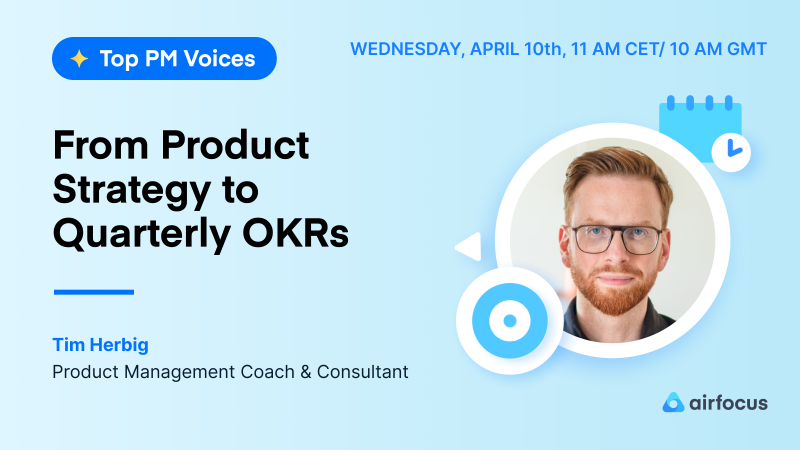
April 10th: 11 AM CET/ 10 AM GMT Webinar: From Product Strategy to Quarterly OKRs Register here.
Is Your Innovation Intentional?💡
This week, we're zeroing in on intentional innovation with Jobs To Be Done (JTBD), Outcome-Driven Innovation (ODI), and outcome-based roadmaps. Learn how aligning with customer needs can transform your approach to innovation. Have questions? Join our webinar with Tony Ulwick on 28 Feb and ask him directly.
⭐️ This Week's Top Picks
🤓 What are Jobs To Be Done (JBTD) - airfocus
Starting with the basics, we introduce the framework developed by Tony Ulwick in 1991 that had a huge role in the success of many innovations. JBTD is the secret behind understanding customer motivations deeply.
💡 What innovation really means for product managers - Kent J. McDonald
In this article, Kent distinguishes between genuine innovation and innovation for its own sake, especially in the realm of parity products. He shares a blend of personal anecdotes, industry insights, and practical advice.
💼 Outcome-Driven Innovation: JTBD Theory in Practice - Tony Ulwick
Let's hear it from the man himself. This enlightening article unveils how ODI's customer-centric approach, focusing on the customer's job-to-be-done, leads to the creation of winning products and services.
🗺️ Should I Use an Outcome-Based Roadmap? - Adam Hecht
Whether you're using the top-down or bottom-up approach to define your outcomes, this guide offers a clear, actionable framework for making your roadmaps more strategic, measurable, and aligned with your key performance indicators (KPIs).
💬 Social Post of the Week
Tony Ulwick via LinkedIn💡
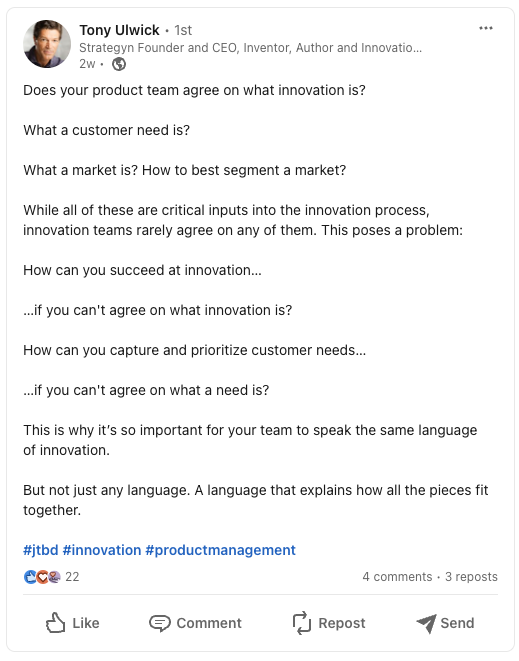
📆 Upcoming Events
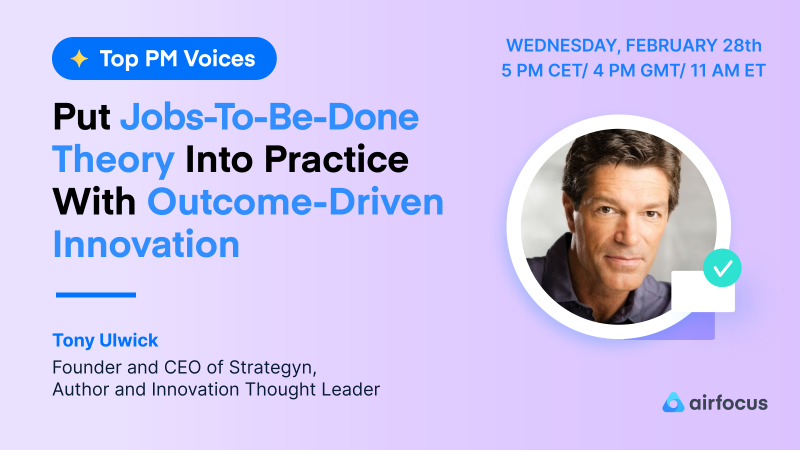
Feb 28th: 5 PM CET/ 4 PM GMT/ 11 AM ET Webinar: Put Jobs-To-Be-Done Theory Into Practice With Outcome-Driven Innovation Register here.
Boosting Customer Focus with OKRs 🎯
How can your team's goals align with what your customers want? We've picked some great reads to help you answer this question, all leading up to our exciting webinar with Jeff Gothelf on "Building Customer-Centric Products With OKRs." Join us this Thursday to learn more.
⭐️ This Week's Top Picks
🤓 The Connection Between Goals and Customer Centricity - Jeff Gothelf
This piece sets the stage for our webinar discussion with Jeff on building customer-centric products with OKRs, showcasing how the right goals can lead to exceptional design and research practices.
💡 How To Be a Customer-centric Product Organization - Adam Thomas
Discover the essential shift from saying to doing in becoming a truly customer-centric product organization. In this article, Adam outlines practical steps for integrating customer feedback into your product strategy.
Explore how OKRs can transform enterprise success through a focused approach on customer satisfaction and retention. The author outlines how setting ambitious objectives paired with measurable key results can align efforts toward growth.
🤓 How To Implement an OKR Strategy for Your Organization - Sami Rehman
Uncover how Adobe, Amazon, and Netflix achieved significant growth by focusing on core objectives with OKRs. This article provides a step-by-step guide on implementing OKRs to align teams, innovate, and enhance customer-centricity.
💬 Social Post of the Week
Malte Scholz via LinkedIn💡(Click here to vote.)
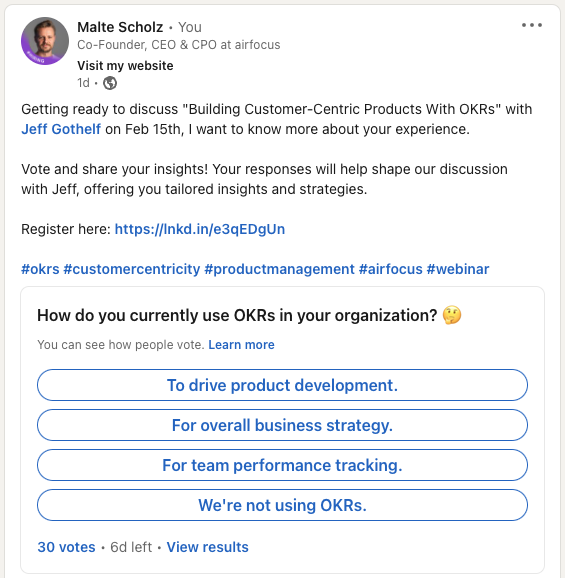
📆 Upcoming Events

Feb 15th: 2.30 PM CET/ 1.30 PM GMT/ 8.30 AM ET Webinar: Building Customer-Centric Products With OKRs - Jeff Gothelf Register here.
Product Backlog Management 101 ✅
They say that backlog management is the art of turning chaos into clarity, a challenge familiar to many PMs and product leaders. To guide you towards this clarity, we've selected some articles full of useful tools and strategies. For more insights, join our webinar this Wednesday with David Pereira.
⭐️ This Week's Top Picks
🛠️ 5 Tools for Managing Your Product Backlog - Quadri Oshibotu
Before you start managing your backlog, you need to make sure you have the right tool for the job. In this article, Quadri presents 5 key tools for handling your product backlog, along with an analysis of their strengths and weaknesses.
💡 Overcoming Common Product Backlog Management Traps - Stefan Wolpers
This article discusses David Pereira's insights from the 54th Hands-on Agile meetup, focusing on strategic backlog management. Discover how to maximize value and steer clear of the 'feature factory' trap with these expert practices.
🦸🏼♂️ 10 Tips for Product Owners on Product Backlog Management - Robbin Schuurman
Product owners play a crucial role in managing backlogs within organizations. The author highlights key strategies they use such as maintaining a manageable backlog size, adhering to a single backlog for greater clarity, and actively involving development teams in the process.
🤓 Your Guide to Backlog: Product vs. Sprint Backlog - Vishal Chaudhary
Learn about the differences between Product and Sprint Backlogs in Agile methodologies, their unique roles, and how they contribute to successful Agile projects. A must-read for anyone looking to master backlog management and drive efficient workflows.
💬 Social Post of the Week
Jeff Gothelf via LinkedIn💡
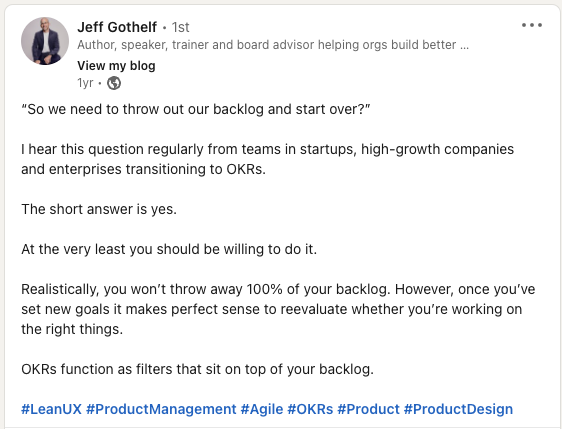
Will 2024 Be the Year of Product Management? 🧐
2024 is predicted to be a great year for product management with lots of new chances for growth and innovation. At airfocus, we're excited to be part of this, with our latest funding success 🚀. Discover what's changing in product management in 2024. Explore the big trends, developments, and important events.
⭐️ This Week's Top Picks
🤩 We Raised $7.5M to Transform Enterprise Product Management Globally - Malte Scholz
Explore the journey of airfocus and our recent $7.5M funding success, a key milestone in enhancing our AI-assisted Product Operating System used by leading global companies. Discover how this funding will propel our mission to redefine enterprise product management.
💡 3 Ways Product Management Is Shaping The Future Of Innovation And Market Success - Rhett Power
Explore the 3 ways PM is driving innovation and market success. This article highlights the impact of customer-centric approaches, trend forecasting, and tech adoption in shaping successful product strategies.
🔮 5 Product Management Trends and Predictions for 2024 - Nouran El-Behairy
Will AI revolutionize the way we work? Are PMs facing new demands? How will data reshape strategy? Find out 5 trends on the horizon for PMs in 2024.
🙌🏼 The best product management conferences in 2024 - Bart Krawczyk
Maximize your product management growth with Bart Krawczyk's guide to 2024's top conferences. This essential list spotlights premier events for unparalleled learning, innovation, and networking opportunities in the dynamic world of product management.
💬 Social Post of the Week
Malte Scholz via LinkedIn💡
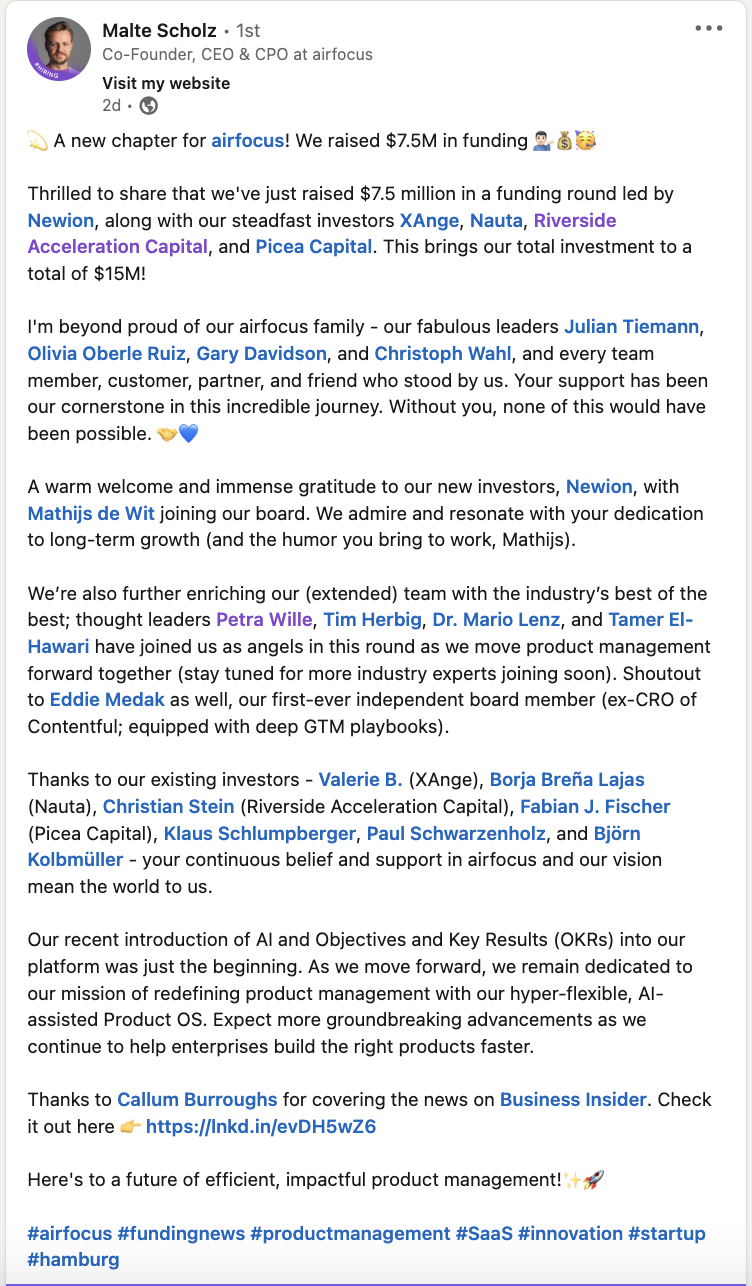
Future-Proof Your Product Management 🚀
Preparing for the future today can ensure your product's success for years ahead. We've curated a selection of articles that shine a light on critical areas you need to focus on to keep your product management approach relevant and dynamic.
⭐️ This Week's Top Picks
💻 Does Your Organization Need Digital Transformation? - Kent McDonald
Staying ahead means leveraging modern tools. Kent McDonald emphasizes the crucial role of digital technologies in business, advocating for a product-centric strategy to enable successful digital transformation and maintain competitiveness.
🌱 6 Rs – Six principles for sustainable product development - UID
Highlighting sustainability as a key component of modern product strategy, this article introduces six principles that integrate economic, social, and ecological aspects, underlining their growing importance in product development.
👷🏼 What are Product Operations? A Beginner’s Guide for Product Managers - Kinzal Jalan
Product Operations is becoming a pivotal aspect of PM. The article breaks down the role of product ops in streamlining development processes and enhancing cross-functional collaboration.
🤖 The future of product management in the age of AI - Ravi Jadhav
AI's integration in PM has marked a significant shift, revolutionizing how products are developed and managed, a trend that is set to continue and expand in the coming years.
🚀 6 Ways to Identify if You Need to Modernize Your PM Approach - airfocus
Time to upgrade your PM approach? This checklist offers vital strategies for systematic prioritization, optimizing team workflows, and ensuring cross-functional alignment.
💬 Social Post of the Week
George Nurijanian via LinkedIn💡

Aligning Products with Market Trends 👀
Success is more than just planning; it's about quickly adapting to changing market trends. In this edition, we've curated content that aims to equip you with the insights and tools necessary to keep your products in step with market predictions for 2024.
⭐️ This Week's Top Picks
🎯 2024 Enterprise OKRs: A Strategic Guide for Effective Planning - Vishal Chaudhary
This article provides a comprehensive guide for enterprises on planning and implementing OKRs for 2024, emphasizing their role in building resilient product roadmaps and fostering team alignment.
🔮 Product Management in 2024: Trends and Innovations - Miko Lehman
What does 2024 have in store for product management? Miko forecasts the rise of AI, IoT, and personalized user experiences, marking a shift towards a more technologically advanced yet human-centered approach in product management.
🔍 Market Research Techniques: A Comprehensive Guide for Product Managers - Maven
Relying on market research to make product decisions is a sure way to enhance your strategy. Maven's guide on market research demonstrates how these techniques can lead to better product insights and informed strategy decisions.
🤸🏼♀️ Adapting Product Vision and Strategy to Changing Marketing Conditions - Jillian Kaplan
What happens when things don't go as planned? In this article, Jillian discusses practical strategies for adapting product vision and strategy in response to unforeseen market shifts.
💬 Social Post of the Week
Anthony Murphy via LinkedIn💡
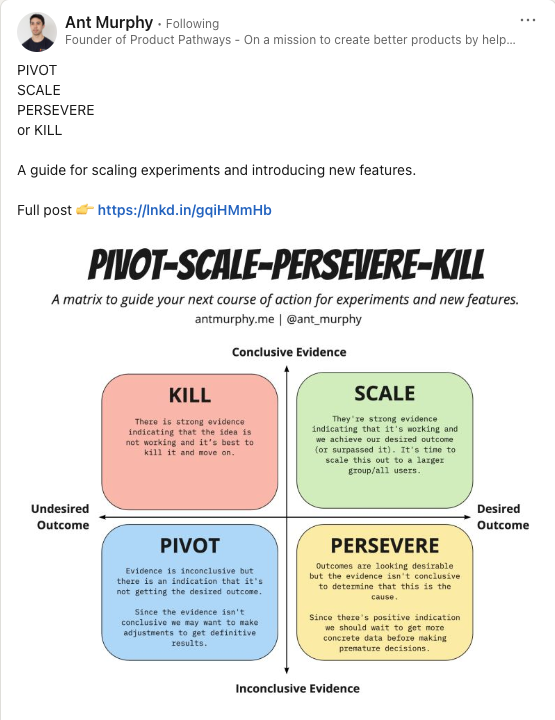
📆 Upcoming events

Join us on Dec 7: 5 PM CEST/4 PM BST/11 AM ET Webinar: Planning a Roadmap to Propel Product-Market Fit
2024 Planning Essentials for PMs💡
As 2023 winds down, we've reached that pressing yet exciting time for PMs to roll up their sleeves for annual planning. It might feel overwhelming but fear not!
We've gathered some resources to help you step into 2024 with crystal-clear, actionable, and strategically aligned OKRs and roadmaps to set you up for a stellar 2024.
⭐��️ This Week's Top Picks
The airfocus Objectives app is an ideal tool for planning, monitoring, and achieving your goals. It offers a comprehensive, integrated, and flexible approach to managing OKRs and aligning them with your strategy.
7️⃣ Create An Effective Annual Product Plan With These 7 Steps - Sid Arora
From defining broad focus areas to finalizing initiatives according to available resources, Sid's process ensures alignment with the company's mission, promoting a culture focused on results and responsibility.
✨ How to Shine as a Product Leader during Annual Planning- Tami Reiss
Tami advises starting the planning process by balancing data and vision and considering the company's stage in its growth strategy and metric tracking. She argues that compelling product vision and strategy involve participation from various company levels.
📕 Product Management. Annual Planning: Instruction for Use - Michael Karpov
Karpov presents the annual plan as a dynamic roadmap, focusing on business metrics, resource allocation, and process improvements, guiding product managers toward achieving key objectives aligned with the company's future goals.
💬 Social Post of the Week
Sondra Orozco via LinkedIn.
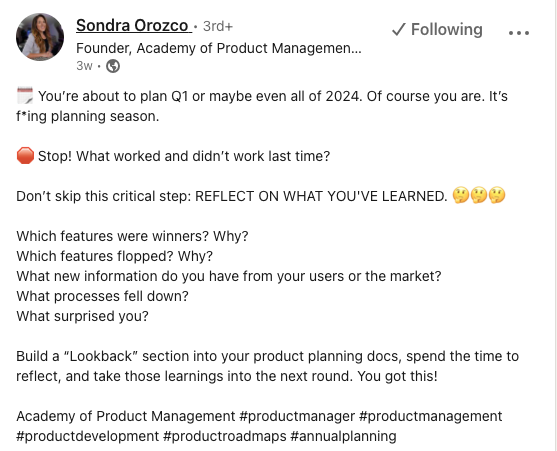
Balancing Data and Intuition ⚖️
As a product manager, you have the challenging task of balancing hard data and the invaluable insights gained from experience. Your ultimate goal is to transform this data into products that genuinely resonate with people, utilizing the power of tools and insights to create products that are both grounded in solid data and deeply human.
⭐️ This Week's Top Picks
🚀 Data-Driven vs. Data-Informed: Finding the Right Balance for Your Product Team
The article discusses the differences between data-driven and data-informed approaches to product management, the advantages and limitations of each, and how to effectively blend data with human insights for better decision-making.
🔢 Data-Driven Product Management: Leveraging Analytics to Optimize Product Performance - Ankita Saraf
Here we delve into the essence of data-driven product management, detailing the systematic approach that relies on analyzing real-world data to make informed decisions in product development.
🧭 Creating a Data-Driven Product Management Strategy - Santiago Pampillo
Using customer feedback, market trends, and user behavior data in the product development lifecycle can change your PM game. The author encourages product managers to adopt data analytics to create competitive, efficient, and customer-centric products.
🗺️ How to Build a Product Roadmap No One Can Argue With - David Geffen
David argues against impulsive and ill-informed decision-making in the product development process, advocating instead for a roadmap that is informed by customer data and aligned with the company's strategic business objectives.
💬 Social Post of the Week
Ant Murphy via LinkedIn 💡
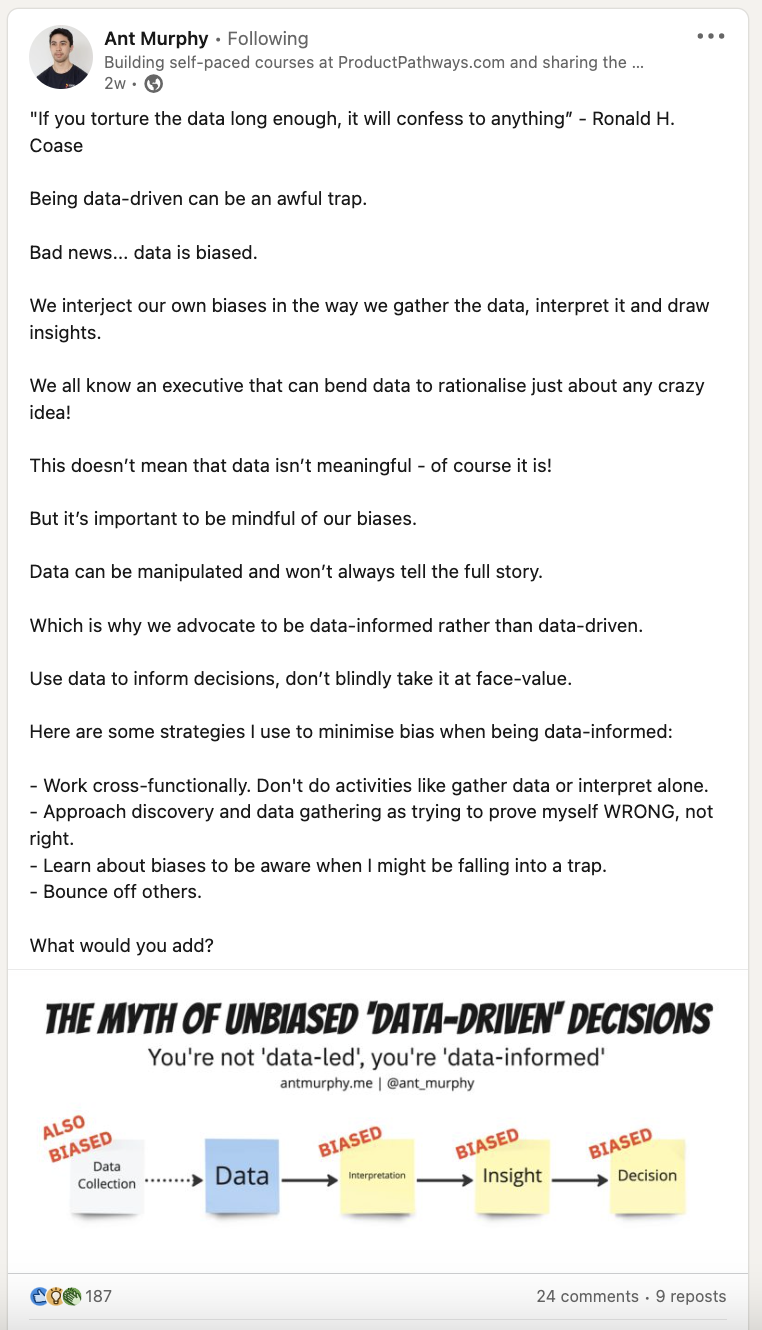
The Hybrid Power of PLG and Sales 🦸🏼♂️
Product-led growth is often seen as the contemporary successor to sales-led growth. However, as the boundaries blur and businesses adapt, it's clear that these strategies can coexist. In fact, many thriving companies are discovering the magic of combining the strengths of both approaches.
⭐️ This Week's Top Picks
🚀 Introduction To Product-led Growth and the Role Product Managers Play - Kerstin Exner
The article discusses the role that PMs play in the transition from traditional sales-driven SaaS models to product-led growth, focusing on collaboration, communication across teams, and emphasizing core functionality for a coherent user experience.
🪴 Sales-Led + PLG = Product-Led Sales - Aakash Gupta
What do you get when you combine the efficiency of product-led growth with sales-led expertise? PLS. Companies like HubSpot, Adobe, and Oracle exemplify this approach, showcasing its potential.
❓ Overcoming Common Obstacles to Product-Led Growth - Helena Ebert
What are the key barriers to PLG? The list includes lack of product-market fit, insufficient customer focus, inadequate data management, and absence of viral growth mechanisms.
🔢 Product-Led Growth Metrics: A Definitive Guide for SaaS Businesses - Eric Keating
Use PLG metrics to aid in understanding and optimizing the user journey, focusing on activation, adoption, adoration, and advocation stages to retain and expand the user base.
🦄 The Myth Of "No Sales" at Product-Led Growth Companies - Alexa Grabell
Contrary to popular belief, PLG companies' products don't "sell themselves" through user-friendly, self-serve experiences. Integrating a sales team is essential for continued growth and to address more complex customer needs.
💬 Social Post of the Week
Elena Verna via LinkedIn 💡

Your Guide to Mastering OKRs 🎯
The Objectives and Key Results (OKRs) framework can be a game-changer for product teams, steering them toward alignment and purposeful actions. We're thrilled to introduce our latest 📘 eBook: OKRs for High-Performing Product Teams: A Practical Guide, packed with insights on how to master and utilize OKRs for optimal team performance. Grab your copy now!
⭐️ This Week's Top Picks
📘 eBook: OKRs for High-Performing Product Teams: A Practical Guide - airfocus
Gain the key skills and insights for successful OKR execution. Uncover the distinctions between good and bad OKRs, supported by real-world examples and case studies, and the tools that can help you seamlessly align your team to set, track, and attain your goals.
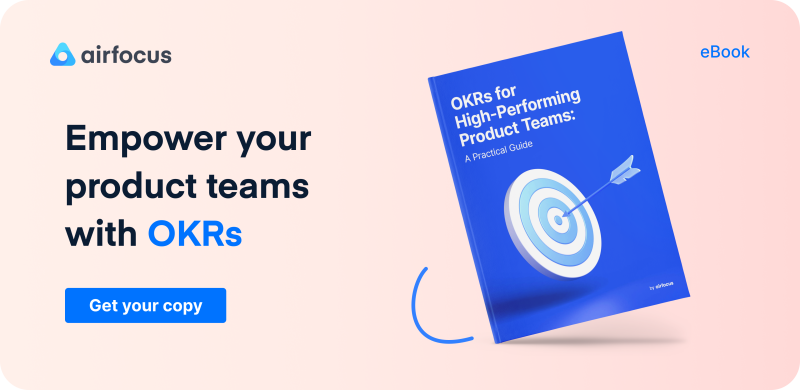
🔍 OKRs vs KPIs: What’s the Difference? - Anthony Murphy
Here, Anthony explains the origins of OKRs and KPIs and provides an analogy to differentiate them. He argues that OKRs aim to achieve specific outcomes aligned with organizational strategy, while KPIs continuously monitor essential health metrics of the business or product.
🤔 What are the benefits and challenges of using OKRs as a product metrics framework? - LinkedIn community Contributors weigh in on the dual aspects of OKRs, underscoring their pivotal role in steering product strategies toward significant outcomes and organizational alignment, while also cautioning against common challenges like crafting unclear OKRs.
🩺 Goal-driven Product Management: How we use OKRs at Oscar - Duncan Greenberg
Instead of theoretical examples, here you can see OKRs in action within a real-world business. Greenberg offers practical guidelines, real examples, pro tips, and solutions to common pitfalls in implementing effective Key Results.
👀 Unlocking the Power of OKR Retrospectives - Andrea Saez
Achieving your goals is not the end of the journey. Andrea highlights the importance of holding regular OKR retrospectives to assess outcomes, celebrate wins, learn from misses, and fine-tune future strategies.
💬 Social Post of the Week
Jeff Gothelf via LinkedIn 👏🏼
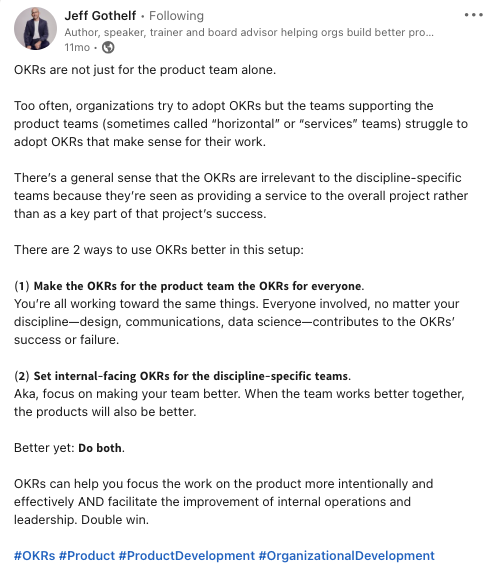
📆 Upcoming events
Oct 19: 10 am CET/ 4 am EST
Webinar: Collecting User Insights for Roadmap Success
Oct 11-12: Lisbon, Portugal
Preparing Your Q4 Game Plan 🏀
As we step into the final quarter of 2023, we are faced with exciting opportunities and unique challenges, making it a crucial period for product managers to shine. In this edition of our digest, we've curated a selection of articles to help you prepare, strategize, and thrive in the coming months.
⭐️ This Week's Top Picks
🚀 4 Tips for Product Managers: Make the Most of Your Q4 - Andrew Melville
This article provides valuable insights and practical advice for product managers to navigate the challenges that can arise in Q4. Emphasizing the importance of flexibility, adaptability, and strategic decision-making in managing product development and priorities effectively.
📆 Why Quarterly Planning is the Perfect Event to Create a Product Goal - Edward Lowe
Here, the author explores the role of quarterly planning in Scrum as a means to define and work toward the product goal. He discusses the benefits and challenges associated with this approach and provides insights into how to conduct effective quarterly planning sessions.
🛠️ Best Practices for Tracking OKRs With the Right Tools - Quadri Oshibotu
In this article, Quadri provides us with insights into how leading companies like Google leverage OKRs. He offers recommendations for successful OKR implementation, emphasizing the importance of transparency, regular reviews, and using the right tools to manage the process effectively.
🗺️ Everything You Need to Know About Quarterly Roadmaps - airfocus
Here we provide a step-by-step guide to working with quarterly roadmaps, including defining OKRs, prioritizing initiatives, estimating resourcing needs, and communicating with stakeholders.
💼 Product Team Hiring in Q4 - Christine Norrander
In addition to planning and OKRs, hiring poses challenges for product teams in Q4 of 2023. The article explores how layoffs, funding constraints, and market uncertainties have resulted in smaller teams, increased workloads, lower morale, resource allocation issues, and retention concerns.
💬 Social Post of the Week
Aakash Gupta via LinkedIn 👏🏼
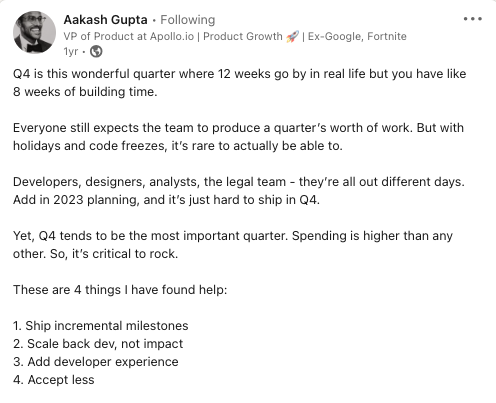
Elevate Your Influence with Effective Communication 📣
Mastering the art of communication is a cornerstone skill sought after by employers in any product professional. It's not just another skill; it can be your secret weapon for driving success. Effective communication serves as the thread that knits together product ideas, execution, and collaborative efforts, fostering connections with both internal teams and external stakeholders.
⭐️ This Week's Top Picks
🎤 How to Improve Your Communication Skills as a Product Manager - Hilary Johnson
Hilary emphasizes the 3 reasons behind the crucial role of communication skills for product managers. She also provides practical tips for improving yours, such as getting to know team members, understanding different audiences, and practicing clear communication, among other helpful insights.
🗣️ The Importance of Communication in Product Management - Michael Hayes
Learn why communication is key for product managers aiming to succeed in various aspects of the product lifecycle, from ideation to development and launch, as well as in building relationships with internal stakeholders (e.g., engineers, designers, marketing, sales) and external parties (e.g., customers, prospects, partners).
📖 Effective Communication Strategies for Product Managers - Luis Jurado
In this article, the author shares 7 communication strategies that can help product managers build strong teams and create successful products. From defining vision and goals to listening, storytelling, and using data, these strategies have the power to elevate your communication game to new heights.
🤝 How do you effectively communicate with stakeholders? - LinkedIn Community
With the help of AI, product experts on LinkedIn share their tips on how to best communicate with stakeholders. They stress the importance of clear, concise, and consistent communication to build trust, credibility, and collaboration while avoiding misunderstandings and conflicts.
🚀 The Ultimate Guide to Internal Product Management - airfocus
This comprehensive guide on internal product management will help you supercharge your internal communication skills. Throughout this guide, you will gain insights into internal product management, its associated challenges, advantages, optimal strategies, and what to communicate and when.
💬 Social Post of the Week
Ant Murphy via LinkedIn 👏🏼
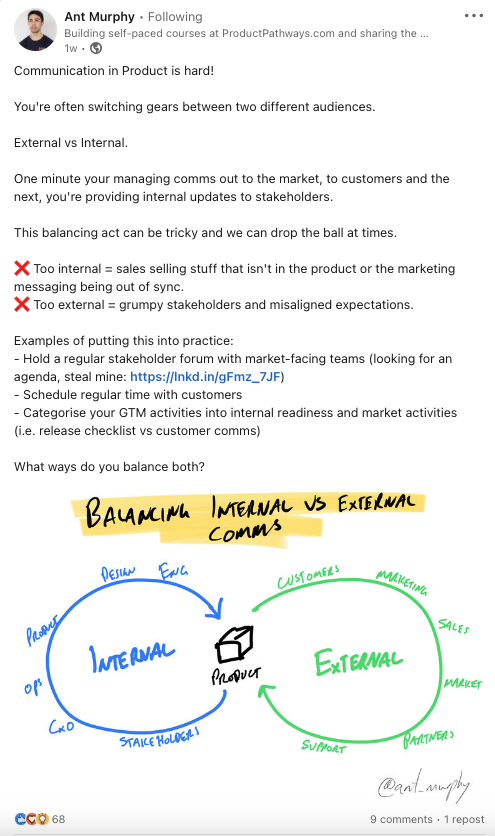
Product Strategy Insights: Key Metrics for Success 🚀
Crafting a successful product strategy involves aligning your vision with customer needs and business goals. But how do you know if your strategy is effective? Our selection of featured articles explores key metrics and indicators that can help you evaluate and enhance your product strategy's impact and value.
⭐️ This Week's Top Picks
📐 How to Align OKRs with Product Strategy and Business Objectives - Adam Thomas
Aligning OKRs with product strategy and business objectives ensures efforts contribute to broader goals. In this article, Adam highlights how effective alignment enhances organizational success and competitiveness with real-life examples from Google and Airbnb.
Judging the effectiveness of your product strategy might pose a challenge. How can you assess the impact and value of your product decisions? In this compilation of tips and opinions, experts share essential metrics and indicators to assess, enhance, and refine your product strategy.
⚖️ What metrics are the most important for your product?- Nick Odlum and Kevin Mcnally
Intercom's Analytics Manager and Senior Machine Learning Engineer highlight the challenge of translating product metrics into actionable insights. The solution lies in asking the right questions, collaborating between analysts and product teams, and defining metrics based on product goals.
🙌🏼 Measuring Product Success: Three Tiers of Product Success Metrics -Robbin Schuurman
The article discusses the challenges of measuring and maximizing product value. It emphasizes the importance of moving beyond vanity metrics (Tier 3) and proxy metrics (Tier 2) to focus on business and customer metrics (Tier 1).
🚀 How To Implement an OKR Strategy for Your Organization - Sami Rehman
This article highlights how major companies like Adobe, Amazon, and Netflix benefited from implementing OKRs. Sami explains the prerequisites for successful OKR implementation, the importance of a clear strategic direction, and how to set, cascade, and communicate OKRs across the organization.
💬 Social Post of the Week
Tim Herbig via LinkedIn
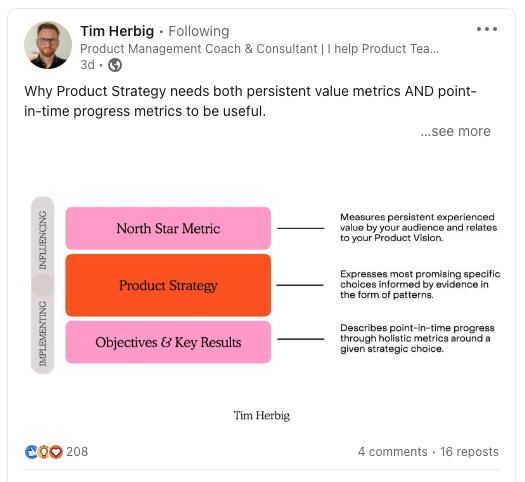
Breaking Boundaries: Product Management Across Industries 🌍
Product management is NOT limited to software alone. The truth is, whether tangible or intangible, products thrive under the guidance of effective product management skills. These skills are now a driving force cutting across diverse industries, igniting collaboration, innovation, and triumphant product outcomes. The below collection of articles showcases this universal potential and the dynamic product tools that make this possible.
⭐️ This Week's Top Picks
🛠️ Why Every Industry Should Consider Using a Product Management Tool - Sami Rehman
Product management tools are revolutionizing industries beyond software. Learn how they can align goals, improve collaboration, gather feedback, and drive data-driven decisions across diverse sectors.
🤔 Becoming an Industry-Agnostic Product Manager - Becky Yelland
Explore the power of industry-agnostic product management. Uncover why your skills and adaptability are key assets when navigating different sectors, regardless of prior industry experience.
🎁 A Product is a Product: Product Management Is Not Just Software! - João Craveiro
Challenge the misconception that product management is limited to software. Dive into the universal principles that underscore product management's applicability across various industries.
💼 In-Demand, Tech-Adjacent Industries that Need Product Managers - Kyle
Why are different sectors seeking product managers? and why is your expertise as a PM essential? Explore the PM roles and responsibilities within eCommerce, retail, food delivery, ridesharing, and healthcare.
🚀 How To Select and Leverage Customer vs. Enterprise Product Management Tools - Quadri Oshibotu
Navigate the world of product management tools with insights into the distinction between customer-centric and enterprise-focused solutions. Discover the criteria for choosing the right tool and the top solutions that can enhance your product management journey.
💬 Social Post of the Week
Lisa Zane via X (formerly Twitter) commenting on Product management trends in 2023 💡.

Elevate Your Product Roadmaps with Real-World Insights 🚀
In today's dynamic environment, a well-structured roadmap serves as the guiding compass for product teams, aligning their efforts with business goals and customer needs. It empowers them to make data-driven decisions, fostering innovation and maximizing product value. Here is a curated list of articles to inspire you to create exceptional product roadmaps that lead your company to new heights of success.
⭐️ This Week's Top Picks
👍 Roadmapping Best Practices With Real-World Case Studies - Sami Rehman
Our journey begins with real-world case studies from industry giants Airbnb and Netflix. Discover roadmapping best practices that have enabled these successful tech companies to adapt, thrive in a rapidly changing market, and embrace customer-centricity. Learn the art of balancing short-term needs with long-term growth strategies, setting your product roadmap on a trajectory of excellence.
✔ 10 Tips for Creating an Agile Product Roadmap - Roman Pichler
Agility is the key to staying ahead in the ever-evolving tech landscape. Roman Pichler brings you ten invaluable tips to create an agile product roadmap that can gracefully adapt to frequent changes and unexpected developments. From goal-oriented focus to securing stakeholder buy-in, these tips will equip you to make informed decisions while ensuring simplicity and measurability.
📢Why SaaS Companies Should Embrace Public-Facing Roadmaps - Andrea Saez
Transparency, engagement, and trust - the pillars of successful SaaS companies! Andrea Saez unveils the power of public-facing roadmaps, providing an opportunity to showcase your product strategy and elevate customer engagement. Learn from real-life case studies of successful public-facing roadmaps, and unlock the potential to build stronger connections with your audience.
💣 Top 7 Tips To Avoid Destructive Product Roadmaps - Dave Martin
Steer clear of roadmap disasters with Dave Martin's top 7 tips. Learn how to position your roadmap to support autonomous teams, foster innovation, and align seamlessly with your business strategy. Avoid the pitfalls that could hinder your SaaS business's growth and become a master of roadmap success.
📐 How to Build a Product Roadmap No One Can Argue With - David Geffen
Data analytics - the key to building unbeatable product roadmaps! David Geffen walks you through the steps to create data-driven roadmaps that lead to better outcomes and success. Learn how to gather actionable feedback, analyze insights, and prioritize features objectively. Empower your company with a roadmap that leaves no room for doubts.
💬 Social Post of the Week
Enzo Avigo via LinkedIn 😂
The Future of AI in Product Management🔮
What real-world impact does AI have on product management? And how can PMs not only adapt but thrive in this exciting era? To assist PMs in navigating this process, we are delighted to present our research report, "The Impact of AI on Product Management." This comprehensive report incorporates insights and tips from over 100 product leaders, empowering you to enhance product processes and drive organizational success. Click the first link below to download the full report.
⭐️ This Week's Top Picks
📖 The Impact of AI on Product Management - airfocus
Explore the findings of this report involving 130 product professionals, highlighting the transformative influence of AI in the field. Gain insights into various aspects, including job security, barriers to adoption, and the specific areas of product management most affected by AI. Additionally, the report offers expert tips and strategies to successfully implement AI within product organizations.
👨💼 What is an AI Product Manager? - Nick Hotz
Nick explains in detail the duties and obligations of an AI Product Manager, and why businesses of all scales are depending on skilled AI professionals. Acquire invaluable perspectives into the fundamental principles of AI product management and master the art of navigating tradeoffs with an "AI PM manifesto".
💬 The Pros and Cons of Using AI in Customer Insights - Sami Rehman
Based on our report's findings, customer feedback is among the product areas most influenced by AI. In this article, Sami delves into the immense potential of AI technologies to analyze extensive customer data, empowering product decisions, customer-centric strategies, and overall business growth.
✏️ 10 Ways AI Is Improving New Product Development - Louis Columbus
Louis lists ten key ways AI is enhancing the entire product development lifecycle, from ideation to market launch. In this area of product management, AI adoption is ultimately leading to faster innovation, improved decision-making, and increased success rates.
In this thought-provoking article, the author explores the ethical considerations and potential biases associated with AI. He also offers essential strategies to ensure transparency, fairness, and accountability in AI-powered products to foster trust with customers and mitigate potential risks.
💬 Social Post of the Week
Marily Nika via Twitter 💡
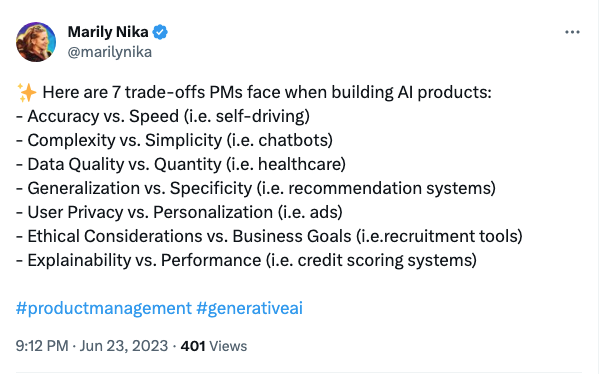
Planning Your PM Career Path🚦
In a constantly evolving field like product management, crafting your career path can be a challenging task. The recent announcement of Airbnb's product functions' shift sparked a wave of contemplation among PMs regarding their role.
Whether you are a seasoned product professional or just embarking on your journey, it is essential to reflect on what product management is, what it isn't, and where your career path fits, in order to have the vision and skills to grow and adapt.
⭐️ This Week's Top Picks
❓30 Questions to Determine if the Product Manager Job is Right For You -Stephanie Oh
Do you have what it takes to be a successful PM? or to move on to the next step in your PM career? Answer these 30 questions to get valuable insights into the qualities and traits that are required to make it in a product-related role.
🧑💼 How To Prepare for a PM Interview - Adam Thomas
Here, Adam discusses the product management interview process, provides insights into common interview questions, and highlights mistakes to avoid when preparing for a product management role.
🔍 Decoding Job Titles: The Different Types of Product Manager - Ellen Merryweather
What is the difference between PM, technical PM, Product marketing manager, and other PM titles? (and who earns more?!) This article discusses the different types of product roles and provides insights into their responsibilities and average salaries.
5️⃣ Five Dangerous Myths about Product Management - Noah Weiss
In this article, Noah Weiss, an experienced product manager who worked at Google, Foursquare, and Slack dispels several dangerous myths associated with the position of product manager.
🔮 The Future of Product Management in 2023 and Beyond - Nouran El-Behairy
How will factors like AI, product-led growth, and product talent affect product management in the near future? This article highlights several key insights from "The Future of Product Management Report" by Product School, along with additional commentary.
💬 Social Post of the Week
Ankit Shukla via LinkedIn
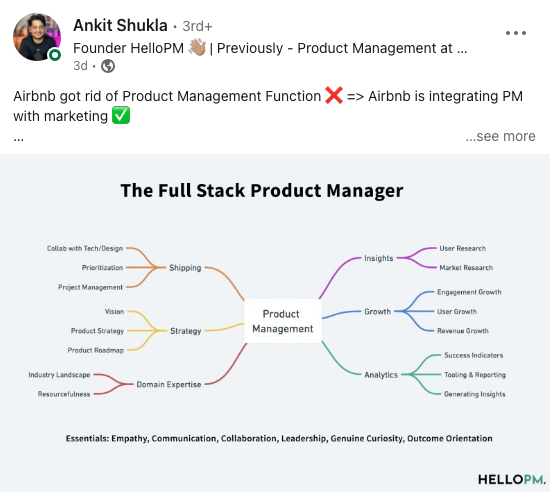
Achieve More With (Effective) OKRs �🎯
It's mid-June, which means it's time to review last quarter's OKRs and set ones for the new quarter. However, it's important to remember that setting good OKRs is just the beginning; the real magic lies in effectively tracking and delivering success through them.
⭐️ This Week's Top Picks
✍🏼 How You Should Set OKRs for Product Management - Tomas Prochazka
An excellent introduction to understanding OKRs in product management. Gain valuable insights into the meaning, history, and practical examples of OKRs, ensuring you kickstart your OKR journey on the right foot.
📐 KPIs vs. OKRs (With Examples) - Issac Kwon
While these metrics are often used interchangeably, it's crucial to understand their differences and leverage them appropriately. Discover their best practices and real-world examples from various industries to effectively measure success.
✅ Best Practices for Tracking OKRs With the Right Tools - Quadri Oshibotu
Quadri provides valuable guidance on the challenges and best practices for tracking OKRs, accompanied by real-world examples. Additionally, he shares a list of tools to help you stay on top of your OKRs and drive your team toward achieving their objectives.
🤔 Not Everyone Needs Objectives and Key Results (OKRS) - Christina Wodtke
It's important to remember that OKRs may not be suitable for every team. The author discusses common mistakes made by companies when implementing OKRs and highlights the importance of considering their effectiveness. Gain insights into a more mindful approach to OKR implementation that aligns with your team's needs.
📃 Objectives and Key Results (OKRs) Template - airfocus
This comprehensive OKR template enables product managers and their teams to set aligned objectives, track progress, and achieve product success by breaking down company objectives, assigning ownership, defining initiatives, and tracking key results.
💬 Social Post of the Week
Anthony Murphy via Twitter. 👏

🕵🏼♂️ A Sneak Peek from airfocus' Marketing Team OKRs
Objective: Empower product managers with actionable insights and expert tips to set effective OKRs.
Key Result: Publish a comprehensive OKR resource in Q3.
Stay tuned for the amazing resources that will take your OKRs to new heights 🚀.
The Art of Effective Release Planning 🎨
Successfully launching products and features in today's fast-paced environment is no small feat. It requires a great deal of careful strategy and meticulous planning. As product managers, we understand that the release plan is not just another artifact; it is a powerful tool that enables clear cross-functional communication and keeps our launches on track, aligning them with desired outcomes.
⭐️ This Week's Top Picks
👊🏼 Avoid the Punch: How to Create an Effective Release Plan in an Outcome-Based World - Adam Hecht In this article, the writer argues that release plans are still important even if you are focused on outcomes. Having a release plan is the best way to avoid being "punched in the mouth" by delays, bugs, and team confusion. It can transform your roadmap into a blueprint for execution.
⚖️ The Product Roadmap and the Release Plan - Roman Pichler
This interesting article explains the relationship and differences between a product roadmap and a release plan. The writer stresses the importance of keeping both in sync, as changes in one can impact the other.
✅ Effective vs. Ineffective Release Plans - With Examples and Templates - Adam Thomas
Here, Adam helps us understand, with examples, what differentiates an effective from an ineffective release plan. He lists the common challenges faced by product managers when attempting to create an effective release plan and how to overcome them.
🚀 Tips for Product Owners on Release Planning - Robbin Schuurman
Setting goals, focusing on benefits and results, considering dependencies, and ensuring only "done" work is released are just some of the tips the author has for product owners to help them create a successful release strategy and plan.
📃 Release Plan Template - airfocus
Our release plan template is tailored to provide a structured approach for managing releases. This ready-to-use template can help you avoid chaos and ensure alignment and effective product/feature releases no matter how complex things are. Feel free to explore it and see its benefits firsthand
💬 Social Post of the Week
Pradip Khakhar views as presented by Victor Forest via LinkedIn. 👏
📅 Upcoming events
Jun 6th: 7 PM BST/ 6 PM GMT / 2 PM ET / London
Book launch and networking event: Product Rantz by User Pilot
Jun 21st: 5 PM CET / 4 PM GMT / 11 AM ET
Webinar: How to Go Beyond User Onboarding
Jun 28-30: Hamburg, Germany.
Navigating the Intersection of Product and Project Management
As a product manager, you've likely been mistaken for a project manager at least once. This confusion arises from the overlapping nature of these roles, despite their distinct differences. In fact, by harnessing the convergence between them and utilizing essential project management skills and tools, you can elevate your product work.
⭐️ This Week's Top Picks
🔀 The Intersection of Product and Project Management- Victoria Inman & Jeff Hancock
What can be achieved through a partnership approach between product and project managers? This article contends that the collaboration of these roles holds significant potential to add substantial value and empower product teams.
🪄 Why Organizations Transition from Project to Product Management - Malte Scholz
One way things are moving is from project to product. In project management, success is measured by meeting predefined timelines and resource constraints. Conversely, success in product management revolves around delivering value, a defining trait of modern business.
🤓 Yes, Product Managers Should Project Manage - Victor Wu
On the other hand, product managers can wear several hats from the project management's closet to enhance their product development efforts. The author argues that acquiring fundamental project management skills can significantly boost the efficiency of your product team.
🔨 Gantt charts: The Project Management Tool You Need to Know - Andrea Saez
A prime example of project management tools that can elevate your product performance is Gantt charts. By integrating Gantt charts with product roadmaps, product managers can showcase the big picture and the finer details of the product's direction, strategy, and execution.
💬 Social Post of the Week
Purna Kaushalya via LinkedIn. 💡
Maximize Product Impact With a Business Roadmap
A business roadmap can help product managers have a more structured plan for developing products that are in alignment with the business strategy, but how does that work? We have the answer for you!
⭐️ This Week's Top Picks
🗺️ What Is a Business Roadmap? And How to Set It Up - Malte Scholz
A business roadmap is a long-term strategic planning document showing your company's goals and the steps required to achieve them. It differs from lengthy business plans as it focuses on the big picture, high-level goals, and objectives.
🏔️ The Fundamentals of The High Performing Business Roadmap - Rajesh Nair
How does building a business compare to climbing a mountain? Turns out they are quite similar! You need research and planning to climb a mountain and the same structures to build a successful business. Therefore, in both cases, having a roadmap can be the way to the top.
🪄6 Ways To Leverage AI in Roadmap Planning - Lisa Zane
While a roadmap acts as a guiding light for the team, building it can be an overwhelming experience, so why not leverage the power of Artificial Intelligence toward building the roadmap you need? In this article, Lisa shared 6 ways you can unlock the capabilities of AI in roadmap planning.
🤔 Entrepreneurs Confuse Product and Business Plans - Martin Zwilling
A business plan, which is more detailed than a business roadmap, is sometimes confused with a product plan and product roadmap. The product plan is an internal detailed description of the product, while a business plan is an external document that describes everything about the business to investors.
💬 Social Post of the Week
Daymond John via LinkedIn. 💡
Build a Strong Product Portfolio
When you start adding another product to your business, things get complicated fast. In this edition, we compile multiple articles on how to create and maintain your product portfolio strategically. Let's dive in!
⭐️ This Week's Top Picks
📖 How To Develop a Product Portfolio Strategy - Andrea Saez
A product portfolio strategy is a strategic approach to managing a company's product portfolio. It involves evaluating the company's current and potential products to determine which products should be developed, maintained, or retired.
🖌️ Visualizing a Product Portfolio Strategy on a Wardley Map - Simone Cicero
The need to articulate a portfolio of product strategies is gaining importance as organizations are forced to deal with the increasing modularity and composability of markets in general. Visualizing the portfolio of your products is essential to evolve a strategy around the interdependencies and interactions between the building blocks.
🔱 Creating Product Strategy with Multiple Strategic Tracks (MuST) - Itamar Gilad
For most tech companies, their first big product success is also their last. Finding a second hit is very hard no matter how much we invest in vision and strategy development. But some companies are different: such as Apple, Google, Amazon, etc. Itamar digs deep into how these companies do it with the MuST principle.
📈 Maximizing Product Potential: A Guide To Building a Strong Product Portfolio - Kent McDonald
In order to add products in a way that helps you sustain and grow market share and revenue, you need to build your product portfolio intentionally. In this article, Kent shares some actionable steps to build and manage a product portfolio and how Atlassian is doing it.
❓ Should a Head of Product Make Strategic Product Decisions? - Roman Pichler
The head of product role and the product strategy are often linked. But should a head of product make strategic decisions for individual products? Or would it be better to empower the product people to own the product strategy?
📻 How to Build Your Product Strategy Stack - Ravi Mehta
In this podcast, Ravi dives deep into his product strategy stack framework and how it was used to develop a powerful strategy at Tinder. He also discusses his other popular frameworks—the frontier of understanding and exponential feedback—and how they can help you grow in your career.
💬 Social Post of the Week
Anthony Murphy via LinkedIn. 💡
The Product Metrics That Matter
Happy Easter weekend!
In this edition, we will share with you some very insightful and actionable articles on data and product metrics. Let's dive in!
⭐️ This Week's Top Picks
☸️ Product Metrics: A Flywheel Framework For Cloud Business Leaders
Product metrics can be “leading” indicators for “lagging” financial outcomes. Which product metrics matter the most to your cloud business & how do these act as a barometer for financial performance?
🛠️ Lean Analytics: The Way To Build Better Software - Behzad Nazarbakhsh
The best way to make evidence-based decisions is to follow the data. However, the issue with using data is that you can easily become overwhelmed if you don't know what data to look at. Moreover, human flaw prevents you from fully utilizing all of the insights data has to offer.
❓ Are You Tracking The Right Product Metrics? - Eira Hayward
Metrics can be a minefield for the unwary – navigating your way to find the right metrics is one of the hardest parts of a product manager’s job. What do you need to know to make a go of it?
✅ Product Metrics That Matter - Cláudia Delgado
Before product metrics, we were relying on business metrics. Consider revenue, for example. That’s a lagging success indicator. We just understood the result of our shots at the end of the game or even the championship. Feedback and learning took too long. Since product metric is introduced, the game is changed forever.
💭 The Responsibility of AI: Who is Accountable for the Results of Predictive Models? - Inês Liberato
In this article, Inês goes deep into the data problem of predictive modeling, how that could impact your product management process, and how different stakeholders across teams should take responsibility to avoid the consequences caused by data issues.
In this podcast, Laura talks with Lenny Rachitsky about the role of experimentation and data in growth, and her big wins from her time leading growth teams. Laura also explains how customer insights helped her uplevel her career and how she (surprisingly) thinks about qualitative versus quantitative data.
💬 Social Post of the Week
Tim Herbig shares common mistakes while drafting Product OKRs.
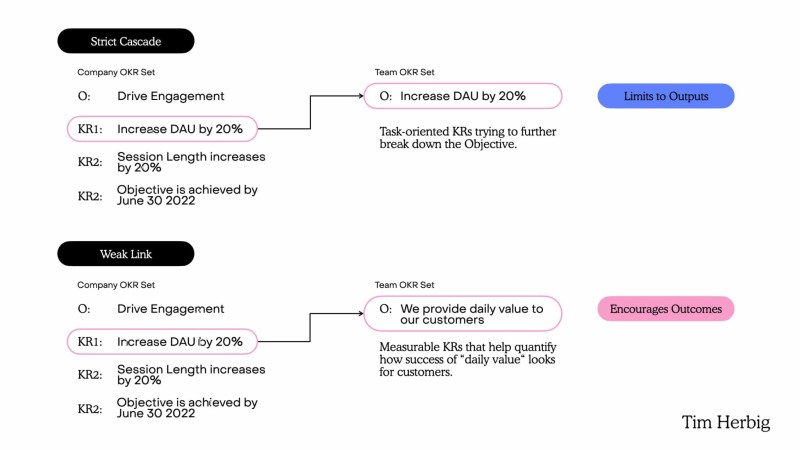
GPT-4's Impact on Product Management
GPT-4 has taken the tech world by storm since its release on March 14th. The first one whose job is to be replaced by it is definitely its predecessor: GPT-3.
This advanced technology opens many possibilities for product management, and we dedicate this Digest edition to its impact and include some experts' opinions on it.
Happy reading!
⭐️ This Week's Top Picks
❓ The Promises and Pitfalls of ChatGPT - Marily Nika
Marily shares her opinions on the limitations of ChatGPT that PMs should be aware of while leveraging the technology, as well as the areas where ChatGPT can be of great assistance with practical examples.
🛠️ How AI experts are using GPT-4 - Melissa Heikkilä
Unlike ChatGPT, which is freely accessible to the general public, GPT-4 is currently accessible only to developers. It’s still early days for the tech, and it’ll take a while for it to feed through into new products and services. Still, people are already testing its capabilities out in the open.
😳 OpenAI CEO Sam Altman: 'A little bit scared of this' - ABC News
The CEO behind the company that created ChatGPT believes artificial intelligence technology will reshape society as we know it. He believes it comes with real dangers, but can also be "the greatest technology humanity has yet developed" to drastically improve our lives.
☄️ ChatGPT And Why AI Makes Me Both Excited and Concerned - Lisa Zane
Lisa believes more can be done to find a happy medium to both gather the appropriate context to develop GPT as a relevant tool based on real-world data and make sure that it helps humans far more than it harms us.
📽️ How AI is Transforming The Way PMs Work - airfocus
Earlier this week, we gathered a panel of product experts to discuss their thoughts on the virality of AI usage and share their experiences of using AI in product management as well as how to best integrate AI into the product development process.
📻 Breaking Down Today's Machine Learning Technology - Christine Pawlikowski
In this podcast, Melissa Perri chatted with Christine to discuss language models, the different types of machine learning, how they can be used to solve problems, and the importance of good data and ethical considerations when using machine learning algorithms.
💬 Social Post of the Week
Shreyas Doshi via LinkedIn. 💡

📅 Upcoming events
Mar 30th: 5 PM CEST / 4 PM BST / 11 AM EST
Webinar: Building a Winning Product Strategy for Business Success
Apr 6th: 5:30 PM CEST / 4:30 PM BST / 11:30 AM EST
Webinar: Designing Cutting-Edge Industry Applications with ChatGPT
Product Strategy for Growth 🚀
It's true that there are a lot of resources out there on business strategy, but it can be tough to find good ones on product strategy. That's why we're excited to share our recent favorites with you in this week's digest. If you're just starting out, we highly recommend checking out our new eBook first. It's perfect for beginners!
⭐️ This Week's Top Picks
📘 Leveraging Product Strategy for Product and Business Growth - airfocus
In this eBook, you will learn everything you need to create your own product strategy, with examples, actionable steps, and a strategy checklist. We start from the basics of product strategy, all the way to helping you master it.
🚴 Product Strategy Choices: Pursuing Explicit Priorities as a Product Team - Tim Herbig
Does your Product Strategy tell you to “make the product better” and to “be more like Spotify”? If yes, it’s probably not that useful. That’s because effective Product Strategy is about articulating explicit choices and making sure they get translated into action.
📋 How to Define Your Product Strategy - Gibson Biddle
A classic! Gibson Biddle wrote a twelve-part series that provides a step-by-step approach to define your product strategy, sharing his learnings from his time at Netflix and suggesting practical questions that you can exercise with your team.
🔁 How Product Strategy Fails in the Real World - First Round Review
Nate Stewart - CPO of CockRoach Labs - shares the failure modes for product leaders to keep an eye out for (like focusing on customer quality over quantity), and how he’s sidestepped those mistakes in his role at Cockroach (including a new approach to design partners).
❓ How To Choose the Right Product Strategy Framework - Vishal Chaudhary
A well-proven framework can reduce the time and effort to execute a product strategy. Businesses can use many popular frameworks to develop their product strategy, and the right framework will depend on the specific product and market.
📻 Product Strategy Audits and More - Melissa Perri
In this segment, Melissa answers subscribers’ questions about how to do a product strategy audit, offering professional services to one-off clients, and how to choose whether to stay on at the company in a new capacity.
💬 Social Post of the Week
Malte Scholz via LinkedIn. 👏

📅 Upcoming events
Mar 22th: 5 PM CET / 4 PM GMT / 11 AM ET
Roundtable discussion: How AI Is Transforming the Way PMs Work
Mar 30th: 5 PM CET / 4 PM GMT / 11 AM ET
Webinar: Building a Winning Product Strategy for Business Success
Customer Churn and Product Retention 💰
Hello friends 👋
As a product manager, one of the most important metrics to keep track of is customer churn. In this Product Digest edition, we have picked articles and opinion pieces that provide valuable insights on how to better measure retention rate and reduce churns.
Enjoy reading!
⭐️ This Week's Top Picks
👌 What is Good Monthly Churn? - Lenny Rachitsky
Churn is unavoidable. So what to do? Beyond constantly working to reduce churn, it’s essential that you understand what healthy monthly churn looks like for your type of business—so that you know if you’re on track for 🚀 or ☠️.
📊 Should I Be Using NPS to Measure Customer Loyalty in SaaS? - Andrea Saez
NPS (Net Promoter Score) is popularly used by SaaS companies. Still, Andrea doubts whether NPS is a meaningful metric to measure customer loyalty and identify what you can do to improve product adoption.
🔧 How PayPal Fixed a $100M Churn Problem - Matt Lerner
"After 17 years, we finally "cracked" a $100M churn problem at PayPal. Zero fancy tech, just a spreadsheet, some SQL, and a physicist named Ben." - Matt Lerner, Ex-Director at PayPal.
💌 Dear Product Managers, Churn Is Good for You - Andrei Tiburca
Churn is inherently bad; no questioning that. That said, it is also a valuable signal that can help product managers spot where they’re going wrong with their product and course-correct before the symptom blows up into a complete product failure.
❓ Are churn surveys worth it? - Angela Guedes
Angela shares her insights on why churn surveys can result in confirmation bias and three tips to make the most out of churn surveys, especially for early-stage startups (read: without a lot of resources).
📻 Good Churn vs Bad Churn - Miles Norris
In this podcast, Miles Norris, VP of Product at MagicLab (Bumble, Badoo, Lumen, Chappy), discusses whether retention is as relevant as we're told, how retention looks in healthy businesses, and the 4 phases of retention.
💬 Social Post of the Week
Leah suggests looking at churns the same way we look at revenue in order to get a depth map of negative signals we combat to fight churn.

📘 Top Product Book
Hooked: How to Build Habit-Forming Products
Hooked is based on Eyal’s years of research, consulting, and practical experience. He wrote the book he wished had been available to him as a start-up founder—not abstract theory, but a how-to guide for building better products.
Hooked is written for product managers, designers, marketers, start-up founders, and anyone who seeks to understand how products influence our behavior.
AI Prompts in Product Management
Happy Product Digest weekend!
Our AI edition was a hit, so we are bringing you another one! This time we will be focusing more on how you can leverage AI to support your product work with prompt suggestions and some insights on prompt engineering.
FYI, we at airfocus also just launched AI Assist - using the power of generative AI to help you with product-specific tasks like drafting problem statements or analyzing feedback sentiment. Check it out!
⭐️ This Week's Top Picks
📋 Top 70 AI Prompts for Product Managers in Every Product Stage - airfocus
How can product managers use AI? The possibilities are endless; you just have to use the right prompts. We prepared a list of 70 prompts you can use in different stages of product management - from product discovery to product planning - to get the most help out of your new sidekick.
📚 Prompt Engineering And Why It Matters To The AI Revolution - Gennaro Cuofano
Like most processes, the quality of the inputs determines the quality of the outputs. Designing effective prompts increases the likelihood that the model will return a response that is both favorable and contextual.
🤖 How Will ChatGPT Change Product Management? - Eira Hayward
ChatGPT and the like will change what is expected from product managers when it comes to both hard skills and soft skills. PMs can use AI to automate multiple small tasks in their routines and become more efficient; and skills like product intuition, stakeholder management, and prioritization will be more valued than ever.
⛓️ 6 Ways to Leverage AI in Roadmap Planning - Lisa Zane
Before even considering plugging AI into what you’re working on, you’ve got to use your human intelligence to define your specific desired outcomes. Once you’ve adequately framed your roadmap, exploring AI in these 6 ways may help determine what and how to collect, organize, and prioritize information.
📻 AI and Product Management - Marily Nika (Meta, Google)
On this Lenny's podcast, Marily shares her insights on how AI is empowering her work, and why she believes that every Product Manager will be an AI Product Manager in the future. They also discuss why PMs should learn a bit of coding, where they can learn it, and best practices for working with data scientists.
💬 Social Posts of the Week
🍲 Some food for thought from Andrej Karpathy via Twitter.

📜 Tobias Zwingmann compiles a great list of resources to make better use of ChatGPT!
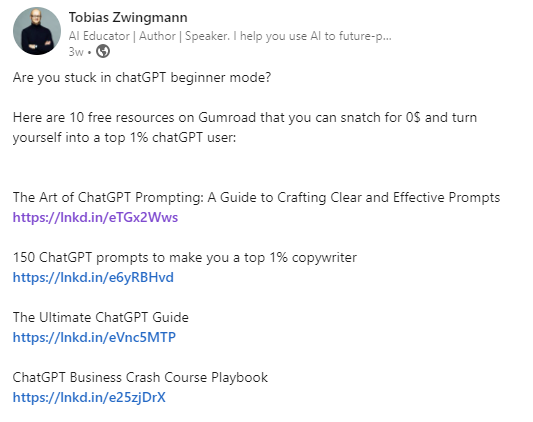
📅 Upcoming events
Feb 16th: 5 PM CET / 4 PM GMT / 11 AM ET
Webinar: airfocus What's New What's Next
Feb 23rd: 7 PM CET / 10 AM PT / 1 PM ET
Panel Discussion: Strengthening Team Cohesion and Morale in 2023
OKRs in Product Management 🏹
Since it's the planning time of the year, and there's a good chance you are either using OKRs or thinking about adopting OKRs right now, we thought it would be fitting to talk about OKRs in this edition!
⭐️ This Week's Top Picks
📊 OKR Anti-Pattern: Using Measures Of System Behavior - Jeff Gothelf
System behavior can look a lot like human behavior when you reduce both down to metrics. However, system behavior is a feature of your product. It helps you determine to what extent you’ll implement that feature. It doesn’t, however, tell you whether or not you’ve delivered value.
💬 The Roundtable Debate: How Do You Set Product OKRs? - airfocus
Last year, we held a hugely popular roundtable with Robin Zaragoza, Bernhard Hacker, and Kent McDonald on setting product OKRs. We discussed the benefits and the potential pitfalls of OKRs, when the OKRs framework does not work, and how to write good OKRs. Make sure to check out the report of the debate!
🎭 How Product Teams Can Move On From OKR Theater - Tim Herbig
By focusing on vanity metrics instead of measuring the solving of proven user problems, you jeopardize creating success for the business and your users. Let’s take a look at how to recognize OKR Theater — and how to ensure your team is focusing on the right things.
⛓️ How to Align OKRs to Roadmaps - Kent McDonald
OKRs help you put some metrics around the problem you’re trying to solve. Roadmaps help you communicate the things you’re going to use to reach your outcome. How are the two related and how can you align them?
📻 An Inside Look at How Figma Builds Product | Yuhki Yamashita (CPO of Figma)
In this episode, Lenny talks with Yuhki about operationalizing quality, the case against OKRs, and how Figma isn't just known for product-led growth, but also for building a community of empowered users. A very insightful episode overall, and interesting takes on OKRs at 40:50 if you want to skip to that part!
💬 Social Posts of the Week
A helpful thread by Teresa Torres on how to differentiate OKRs and Outcomes!
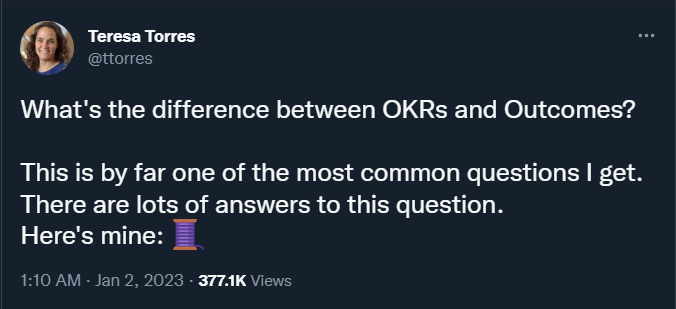
📅 Upcoming events
Jan 19th: 5 PM CET / 4 PM GMT / 11 AM ET
Webinar: The Product-led Growth Guide - Show, Don't Tell - Leah Tharin
Feb 8th: 3 PM CET / 2 PM GMT / 9 AM ET
Webinar: Building a Product Management Talent Strategy - Anthony Murphy
Happy New AI-Year! 🎆🎉
We dedicate the last Digest edition of the year to the AI topic, because who is NOT talking about AI in the past couple of weeks?!
We are bringing you some opinions from the thought leaders in the scene, together with our favorite product song written by AI!
⭐️ This Week's Top Picks
📊 Prediction on 2023 Product Trends - Emilia Korczynska
"I've never seen Product People being so unanimous about anything - but this year, when I asked top Product Managers and Marketers to share their opinion on the upcoming 2023 product trends, almost everyone mentioned AI."
🤖 Prediction on 2023 Product Trends - according to ChatGPT
Inspired by Emily's post, we at airfocus also asked ChatGPT - the hottest artificial intelligence chatbot these days - about its "thoughts" on product trends in 2023 and this is what we've got.
🎨 Exploring the Power of OpenAI ChatGPT for product designers - Edward Chechique
It is more than evident that AI technology will change how product designers work. In this article, Edward demonstrates some use cases for product design using the new ChatGPT.
📍You need an AI transformation manager, NOT an AI product manager - Kevin Dewalt
As the business landscape slopes up toward AI Abundance, we need an additional specialized role to address the unique challenges of AI transformation.
📻 The Ethics of AI in Product Management - Ammar Jawad
From one of the foremost leaders in the machine learning field, Ammar Jawad breaks down his thoughts on topics like psychology in product, machine learning in the tech industry, and the ethics of artificial intelligence.
💬 Social Posts of the Week
✒️ Wise words from Saeed Khan.

🎤 A product management song by "Eminem"?? We have to share this with you.

📅 Upcoming events
Jan 19th: 5 PM CET / 4 PM GMT / 11 AM ET Webinar: The Product-led Growth Guide - Show, Don't Tell
Jan 27th: 6 PM CET / 12 AM ET / 9 AM PT Webinar: Developing a Strong Product & Design Sense with Bob Baxley
Empowered Product Teams 🐝
The human factor plays a huge role in a product's success, but is rarely talked about enough.
We are bringing you some top articles about product team empowerment this week, along with an insightful video from Marty Cagan.
⭐️ This Week's Top Picks
💼 Why And How To Create Empowered Product Teams: An Actionable Guide - Kerstin Exner
Many companies will claim that they have a strong product management discipline, but if you look under the hood, this is not always true. The ones that do usually outperform their competitors in innovation, speed, quality, agility, and adaptability. All of these are critical in a fast-changing world.
📍 Self-similarity and Manager/Leader Accountability (for Cross-functional Teams) - John Cutler
The key point here is that having "cross-functional teams" is all well and good. But these teams are a mirror of the managers they report to (which mirrors the incentives in place). If the managers cannot collaborate, the team will have trouble collaborating.
🚧 Why Groups Struggle to Solve Problems Together - Al Pittampalli
There are five stages of problem-solving: defining the problem, generating solutions, evaluating solutions, picking a solution, and making a plan. When we solve problems on our own, we intuitively move in between these stages to generate solutions quickly.
🗝️ Open Your Product Development Process to Your Team and Stakeholders - Hilary Johnson
A well-thought-out product development process is key to creating and launching meaningful products. You’ll certainly be more effective with your process if you involve key team members and stakeholders at the right times.
⚔️ Product vs Design vs Tech: A Partnership, not a Battlefield - Anthony Murphy
In high-performing teams, each individual has a deep sense of responsibility to the team and ownership of the product. They participate and yearn to understand more about the different aspects of product development.
📽️ Achieving Extraordinary Results with Ordinary People - Marty Cagan
Marty has had the extremely good fortune to be able to work with many of the very best technology product teams in the world. What he has learned is that there is a profound difference between how the very best product companies create technology products, and the rest.
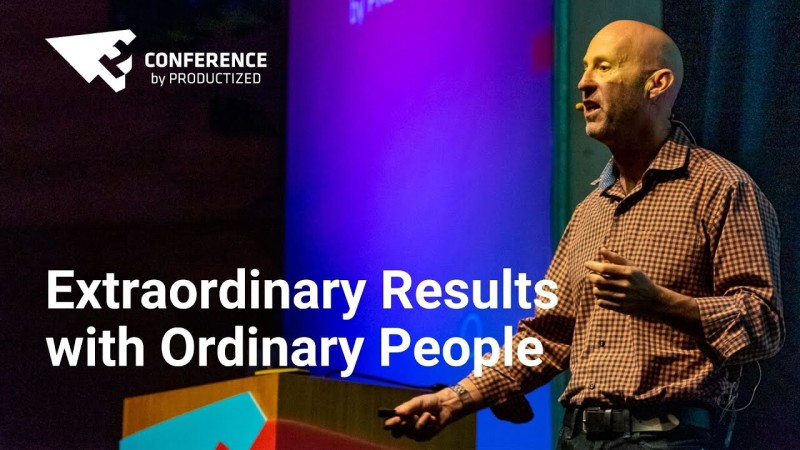
💬 Social Post of the Week
The r/productmanagement subreddit shares advice on how to deal with an underperforming team.
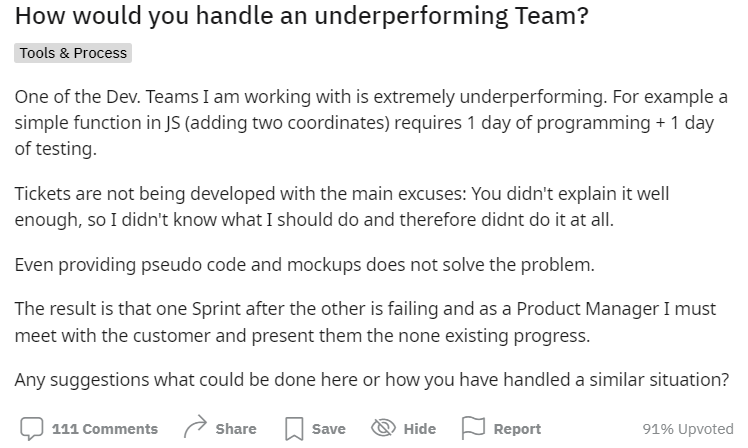
📘 Top Product Book
The Team that Managed Itself: A Story of Leadership - by Christina Wodtke
How do you build the right team and choose the goals to pull them to greatness, even if you’re dealing with a toxic environment? How do you keep your people moving in the right direction without burning out or burning it all down? Leading so well that your team learns to manage itself?
Learn how from this book by Christina Wodtke. You can order your copy here.
📅 Upcoming events
Dec 14th: 5pm CET / 11am ET / 8am PT Webinar: How Miro Scales Delivery and Discovery
Dec 16th: 6pm CET / 12pm ET / 9am PT Webinar: Take Back Your Power & Special Afterparty
Product Leadership ⛰️
Inspired by *gestures wildly at everything* whatever is going on at Twitter, we decided to dedicate this Product Digest edition to the topic "Product leadership".
Want to read others' opinions on the current state of product management at Twitter? We've got you too!
⭐️ This Week's Top Picks
70 percent of the workers questioned believe they would be happier at work if they had a better relationship with their managers. In comparison, 60% feel they would be more productive.
💅 The Highest Paid Person's Opinion (HIPPO)
Many people in the position to give out HIPPOs got there by being right, a lot. They developed and delivered successful products and services and helped grow the business to where it is today. None of that matters when it comes to a new initiative.
📍 Product Leadership: The Four Pillars
Sometimes we get caught up in the “management” portion of our profession and lose track of moving toward “leadership.” Management is about execution. Leadership is about inspiring others to follow you and bring your vision to life.
📚 How to Apply Product Thinking to Your Entire Organization
Applying product thinking to your organization doesn’t happen overnight. It’s a habit and mindset. This means having an ongoing and collective effort. It can be challenging to know where to start, especially if your organization, team, or stakeholders are new to this approach.
⛰️ Crossing the Canyon: Product Manager to Product Leader
What got you here, won't get you there. There is a core reason why the step to Product Leader is the hardest; it's an almost completely different job requiring several new abilities like product strategy.
📻 How To Unlock Your Product Leadership Skills
Ken Norton, an executive coach and an ex-PM at Google for 14 years, shares with Lenny Rachitsky his deep experience in leadership and the lessons he most often offers his clients to unlock growth.
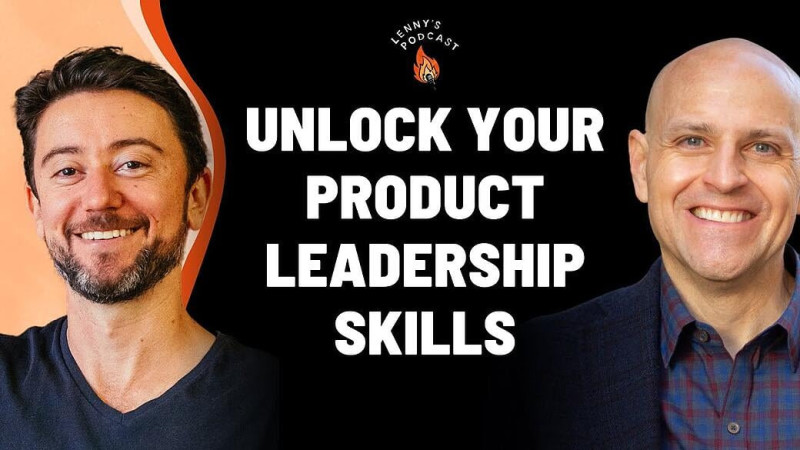
💬 Social Post of the Week
More than a hundred PMs shared their opinions under this thread. Don't miss the discussion!
Product managers, what's your view of how @elonmusk is leading twitter?
— JustAnotherPM (@JustAnotherPM) November 20, 2022
📘 Top Product Book
EMPOWERED: Ordinary People, Extraordinary Products (Silicon Valley Product Group) - by Marty Cagan and Chris Jones.
Bill Campbell - a legendary Silicon Valley coach - once said, "Leadership is about recognizing that there's a greatness in everyone, and your job is to create an environment where that greatness can emerge." This book shows you how to become that empowering leader.
A perhaps popular but fitting choice for this week's recommendation! You can order your copy here. Tip: The Kindle version is on sale for Black Friday!
📅 Upcoming events
Nov 30th: 5pm CET / 11am ET
Roundtable Discussion: Setting Product Ops up for Success
Dec 7th: 3pm CET / 9am ET
Webinar: Fundamentals of Successful Product Management: The 3 Non-Negotiables
Dec 14th: 5pm CET / 11am ET
Webinar: How Miro Scales Delivery and Discovery
B2B and Product-led Growth
Happy Product Digest weekend!
This week we'd like to share a mix of insights on Product-led growth (PLG) with you, especially when it comes to a B2B environment.
⭐️ This Week's Top Picks
📚 Introduction to PLG and The Role of the (B2B) Product Manager
The B2B product manager has a central role in collaborating, coordinating, and communicating with all teams to create a coherent and compelling product. This is very similar to how product management in B2C companies has been operating for years.
✍️ How to Win With Product-led Sales
Everyone wants the best of both worlds: low CAC with product-led (PLG) and high ACVs with sales-led (SLG) growth models. But implementing both is tricky as they utilize different channels, monetization strategies, growth loops, and even internal resources.
💬 Inside Hotjar’s Bootstrapped PLG Strategy
"The biggest misconception I see about product-led growth is people assume it's about product and that's a bit of a reduction." - Hotjar CEO Mohannad Ali shared how the company bootstrapped to $50M+ with PLG.
🎈 What Makes a Strong Product Culture?
A product-focused company will naturally create a product culture around it, resulting in an environment that delivers for the product managers, engineers, sales and marketing teams, and customers.
💻 The Importance of Data Quality For Product-led Companies
Data touches every aspect of a PLG company, from personalization to strategy. But if the success of the business depends on data, then poor data quality directly impacts the top and bottom lines.
📻 How to Unsuccessfully Launch a PLG Motion
In this podcast, Wes Bush - author of the popular book "Product-led Growth" - discusses a different approach of ideas and insights about how to be successful in building an unsuccessful launch of a product-led growth motion!
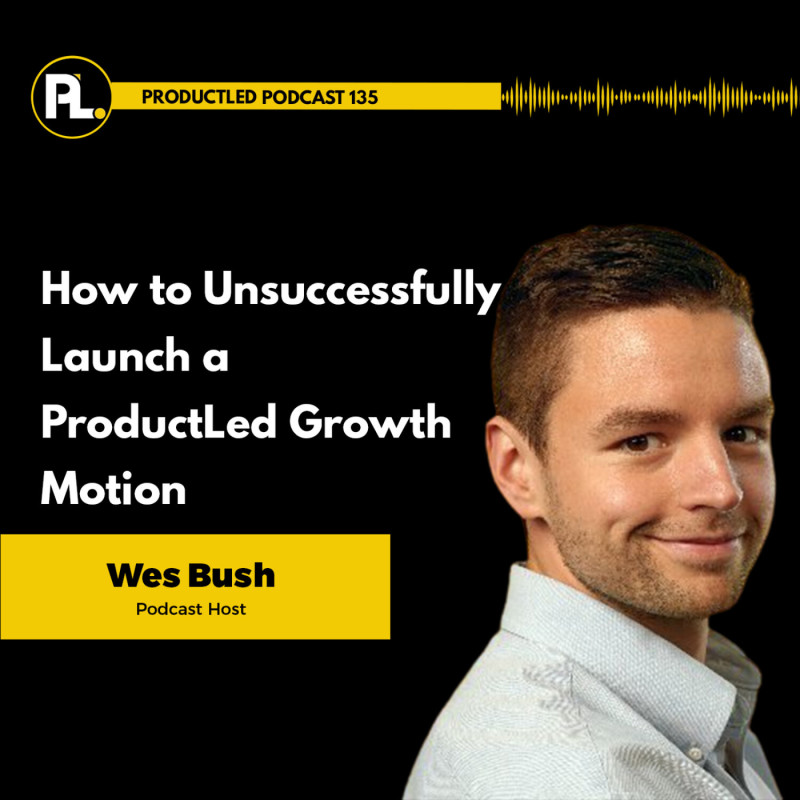
💬 Social Post of the Week
Read Elena Verna's full post here.
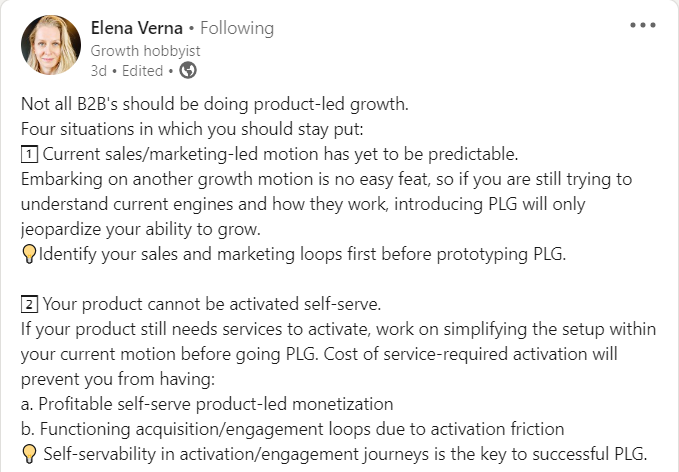
📘 Top Product Book
Mastering Product Experience (in SaaS): How to Deliver Personalized Product Experiences with a Product-led Strategy by Mickey Alon and Nick Bonfiglio.
This book points out the limitations of conventional marketing techniques for SaaS businesses and explains how a thought-through data infrastructure can help design delightful personalized product experiences to acquire and retain users.
You can order your copy here.
Product Design 🎨🖌️
Welcome to the newest Product Digest issue! This time we're fastening substantially on product design. If you or your friends are trying to navigate through product design topics feel free to share this newsletter.
⭐️ This week's top picks
📚 The Art of Designing a Product
In this article, the author goes through the product design process and explains all of its stages.
📚 UX Design and Product Roadmaps: Here’s What You Need To Know
When product design and User Experience considerations come together, we get the UX roadmap. Read the article to learn more about it.
📚 Designing for "Delight" Is Dead
The ultimate goal of product design has to be well-being — not delight. One of the last articles from the pen of an innovation optimist Alex Klein.
🎥 UI/UX Design vs Product Design
In this video you will learn What is Product Design, What is UI/UX Design, How UI/UX design is different from Product Design, Product Designer Salary and a lot more!

💬 Social post of the week
Malte Scholz via LinkedIn
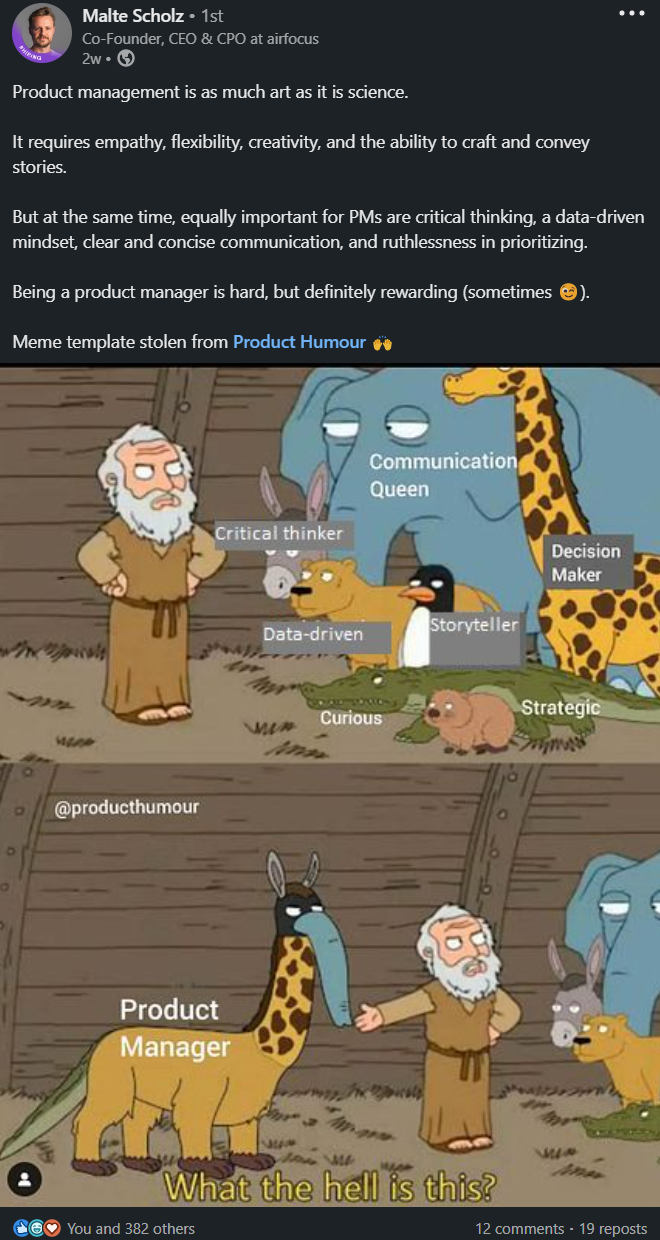
📘 Top product book
In Designer's Guide to Product Vision: Learn To Build Your Strategic Influence To Shape the Future authors (Laura Fish and Scott Kiekbusch) help you navigate fast-changing product journeys―iteratively and continuously improving experiences while staying aligned with your mission and purpose. Interesting book for every product designer.
Feel free to order your copy here.
Product Strategy 🗺️📍🚀
Welcome to the next Product Digest issue! October's edition will bring you to the exciting world of product strategy. If planning is something you want to learn more about feel free to start with the video below and deep dive further into the articles.
⭐️ This week's top picks
📚 The 5 Product Innovation Mistakes and How To Avoid Them
What are the main reasons why product innovation fails? In this article, you will find the 5 reasons that the author sees as the most common and some thoughts on how to address them.
📚 Practical Guide To Defining a Product Strategy
Once you have your mission and vision statement clearly identified you can engage in defining a clear strategy to execute that vision. Check out this article to know more information.
📚 Common Product Vision Board Mistakes
The product vision board is a simple yet powerful tool to capture the product vision and the product strategy. Despite its simplicity, effectively using it can be challenging.
🎥 What Is Product Strategy (An Overview)
What is Product Strategy? What does a Product Strategist do, and how can you get started in Product Strategy? Product Strategist Jonathan Courtney gives you a basic overview of everything you need to know about it.
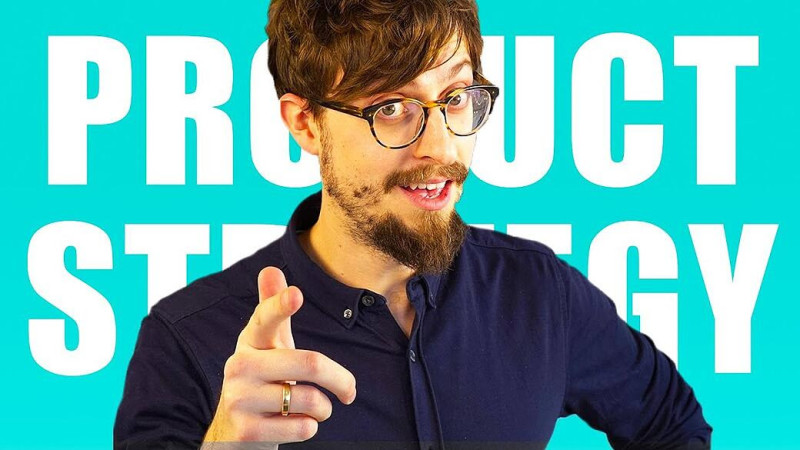
💬 Social post of the week
Itamar Gilad via Twitter
Many product managers are stuck between waterfall planning and agile execution. It’s not a great place to be. You’re working incredibly hard to satisfy everyone, but you have no time to do your real job - discover the product that creates most value.
— Itamar Gilad (@ItamarGilad) October 14, 2022
📘 Top product book
In Strategize: Product Strategy and Product Roadmap Practices for the Digital Age author shared practical advice and valuable examples about product strategy so that you can apply the practices directly to your products. Comprehensive and insightful, the book will enable you to make the right strategic decisions in today’s dynamic digital age.
Feel free to order your copy here.
Product Vision 🔮🚀
Have you ever been confused about the product vision and company mission? You are definitely not the first one but after reading the article from Inês Liberato you will understand these two concepts much better. Feel free to pick your favourite Saturday reading from the ones below.
⭐️ This week's top picks
📚 Company Vision vs. Product Vision
Today we would like to bring you the concept of product vision and how it works within the company context sometimes also called company (vision) mission.
📚 Putting It All Together: Vision, Strategy, Roadmap, and OKRs
Set of actionable advice on vision, strategy, roadmapping and OKRs. If you are new in a product space then this article can give you a nice overview.
📚 Creating Product Strategy with Multiple Strategic Tracks (MuST)
Product Strategy is hard. For most tech companies their first big product success is also their last. Finding a second hit is very hard no matter how much we invest in vision and strategy development. The core business somehow always generates 90%+ of revenue and engagement.
🎥 Product Vision vs. Product Strategy: What's the Difference?
Differentiating Product Vision vs. Product Strategy is not just about semantics. If you understand the difference between them, you can actually use Product Vision to help drive bold choices in Product Strategy.
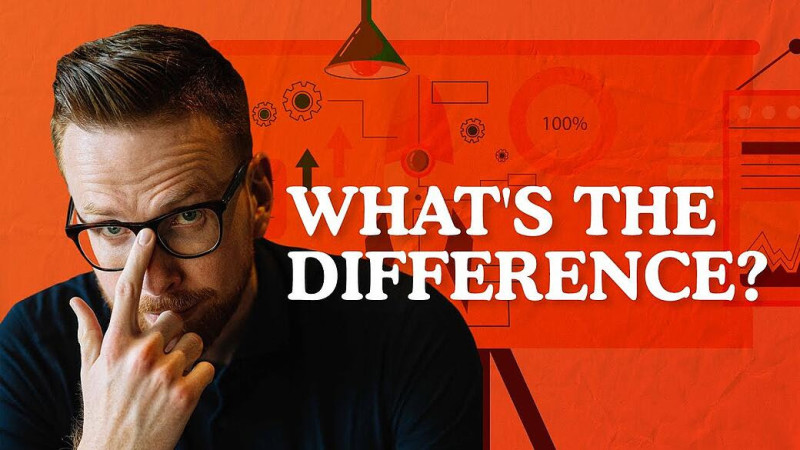
💬 Social post of the week
Itamar Gilad via LinkedIn
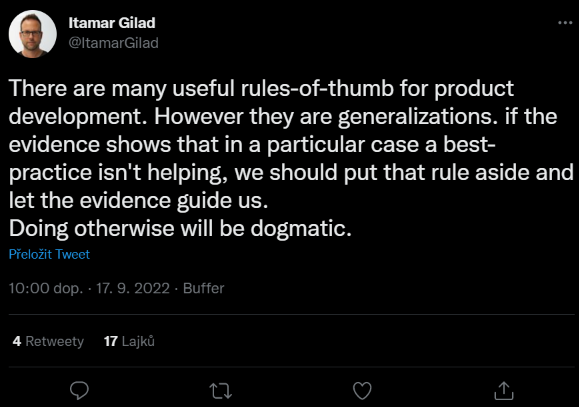
📘 Top product book
In Vision to Value: How to Structure Tech Companies to Deliver Great Products author shared his tips and ideas on how to guide leaders in technical operations towards setting up product development structure, customer support, developing business processes, and organizing teams, while highlighting many of the issues contributing to organizational failure, and some approaches to solving them.
Feel free to order your copy here.
Product Ops 🚀🔧
This week we focus on Product Ops. Emerging role in a product management industry but not everyone knows much information about it. Feel free to watch the video with Marty Cagan and read other articles.
⭐️ This week's top picks
📚 Product Operations: The COO of the Outcome-Focused Product Org?
Are you looking to move into product ops or evaluating if your team could benefit from it? Here are some of the basics behind what product operations does, how it fits in, early wins, and more!
Product ops, referring to product operations, supports a cross-functional product team to constantly ensure and improve their efficiency. Do you want to learn more? Check this article from Clement Kao.
📚 Product Operations: From zero to one
"...in many ways, a product ops team functions as a miniature product team — the product process is my product, and the product team are my users. Therefore, my success in product ops hinges on my ability to understand the needs of my users, the product team, and align around shared goals for the improvement of my product — the product development process." This is how Joshua McLaughlin thinks about Product Ops. Do you want to learn more from him?
🎥 Marty Cagan on Straight Talk About Product Ops at Lean Product Meetup
Marty Cagan gave "Straight Talk About Product Ops" talk at Lean Product Meetup on January 20, 2022. See the video below.
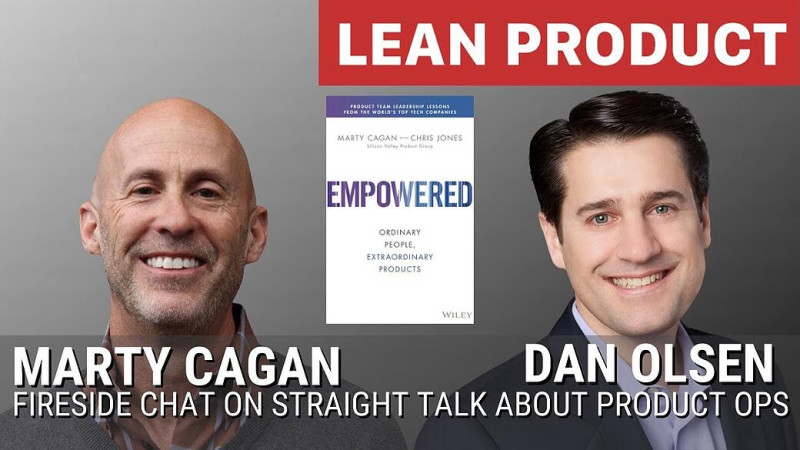
💬 Social post of the week
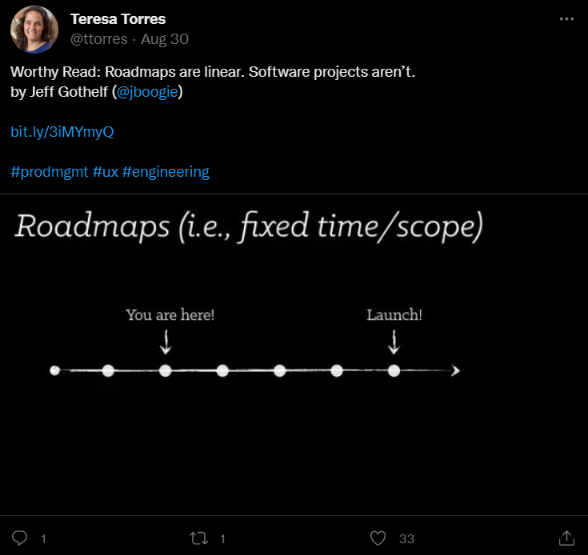
📘 Top product book
In Product Management in Practice: A Practical, Tactical Guide for Your First Day and Every Day After author provides real-world guidance for current and aspiring product managers. Updated for the era of remote and hybrid work, this book provides actionable answers to product management's most persistent and confounding questions, starting with: What exactly am I supposed to do all day?
Feel free to order your copy here.
Product Teams 💪👫🚀
We are all in a product space so knowing the basics of how to run and work effectively in modern product teams can help us to build better products. Have fun reading the articles and tell us your experiences with managing product teams.
⭐️ This week's top picks
This article addresses the process side of running a product team. If you are in the stage of building or running one click here to learn a more structured way of doing product management.
📚 How to Level-up Your Product Team: The Three ‘Ps’
This article provides a framework to move your product team forward and ‘level-up’ your capability. It can be helpful for everyone who stays in a product some time already and need to move forward faster.
📚 Product Team Basics - How To Set Up a Reporting Hierarchy
Setting up a product team requires deep knowledge of what product management is and how it works. It’s challenging to set up your product team and organization to work together. Getting them to apply the right level of product thinking to solve the right problems even more. You need to understand how strategy fits together with discovery, marketing, and implementation.
🎥 Product Group Approach to Team Structure
A short video briefly explaining how you can structure your future product team to deliver the best performance and results.
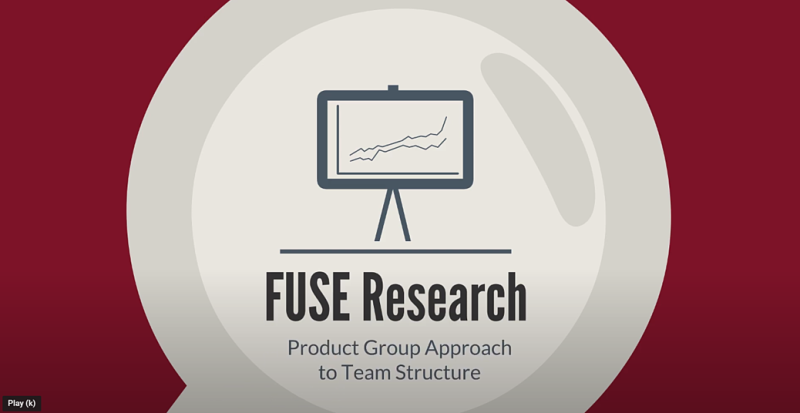
💬 Social post of the week
John Cutler via LinkedIn

📘 Top product book
In Product Leadership: How Top Product Managers Launch Awesome Products and Build Successful Teams authors present interviews with nearly 100 leading product managers from all over the world. Authors Richard Banfield, Martin Eriksson, and Nate Walkingshaw draw on decades of experience in product design and development to capture the approaches, styles, insights, and techniques of successful product managers.
Feel free to order your copy here.
Product & Processes📈🚀
Welcome to a new issue of our Product Digest newsletter. Today we have picked for you some articles about products and processes - especially focusing on product development. Have fun reading and tell us which article you specifically enjoy.
⭐️ This week's top picks
📚 Behind the 7 Phases of Product Development
There are 7 phases of product development, and each one of them is vital in achieving success in a product. You might have been in the business for a while, but this concerns you. It is not just PM textbook content; these stages have their own implications for your work.
📚 3 Types of Innovation: Product, Process & Business Model
It is important to state the three different ways in which a company can innovate in order to improve its processes and remain relevant. Learn more in this article about the types of innovation.
📚 Skills and Processes To Thrive as a Product Manager
In order to talk about which skills and processes a Product Manager should have, it’s important to take a step back and think in the first place: what does it mean to be a Product Manager (a.k.a. PM)?
🎥 How to Structure Your Product Discovery Process (2020) by Tim Herbig
With all the uncertainty and non-linearity of product discovery, it can be incredibly hard to define your own product discovery process and set up a structure. In this video, Tim will dive into some general advice for bringing structure into your product discovery activities. For more guidance check out his free resources here.
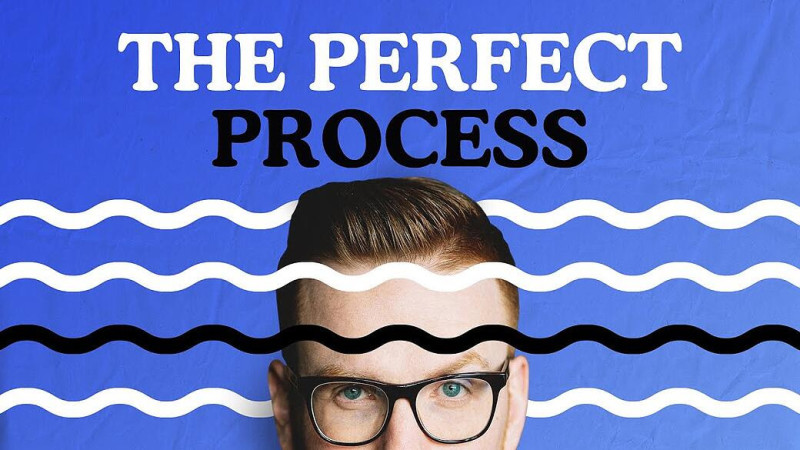
💬 Social post of the week
EQ (Emotional intelligence) is not just a nice thing to have for a Product leader. It's essential to creating a powerfully collaborative Product practice. Read more about Product EQ and how to develop it, here: https://t.co/6U97wLSsz7
— Kate Leto (@kleto) August 2, 2022
📘 Top product book
In Productize: The Ultimate Guide To Turning Professional Services Into Scalable Products Eisha Armstrong writes about her 25+ years of experience that she has in successful creating, launching and growing productized services. Eisha knows what works and what doesn't and she is passionate about making sure organizations learn from each other and avoid reinventing the wheel.
Feel free to order your copy here.
Designers & PMs 🎨😮🙋
Welcome to the next edition of Product Digest. In previous issues, we spoke a lot about the relationships between PMs and Developers and this time we will explore another product role which is undoubtedly an important element of every product team - let's have a look at designers.
⭐️ This week's top picks
📚 Designers + Product Managers: Navigating Tension and Role Fuzziness
Product management and design are quite well-defined disciplines “on paper”. On the battlefield, however, things are different, and what we actually bring to the table is incredibly fuzzy. More information inside the article from Thiago H. Dalcin, Berlin-based designer.
📚 Who Are Product Designers in the New Age
The design industry has evolved and has been growing over the last few years. The term designer is changing along with the landscape of design. There are numerous designers in the digital space frequently performing the same role as product managers but with different titles.
📚 Google’s Heart Framework for Measuring UX
If you’ve been struggling to adopt useful metrics in your user experience team – you might want to consider the HEART framework designed by Kerry Rodden, Hilary Hutchinson and Xin Fu, from Google’s research team.
🎥 Heart Framework: Choosing the Right Metrics for User Experience Value
The Heart framework is a great tool for designing discussions for product teams. In conjunction with the goal signal metrics process, it brings business metrics into your design process.

💬 Social post of the week
Itamar Gilad via Twitter
The average company defines many goals, but pursues just a handful of "winner" ideas.
— Itamar Gilad (@ItamarGilad) July 4, 2022
The best companies set very few goals, but evaluate and test many ideas.#productmanagement #OKRs
📘 Top product book
In The User Experience Team of One : A Research and Design Survival Guide Leah Buley prescribes a range of approaches that have big impact and take less time and fewer resources than the standard lineup of UX deliverables. Whether you want to cross over into user experience or you're a seasoned practitioner trying to drag your organization forward, this book gives you tools and insight for doing more with less. Feel free to order your copy here.
Value & PM 📈👔
Here we are again with the next issue of Product Digest. This week we are bringing you a bunch of interesting articles and content about the value. You can learn what it is, why you should strive to maintain and grow it and if you are looking for more actionable content, then check out our 5-minute guide "How To Use the Value vs Effort Model".
⭐️ This week's top picks
📚 Product Management Means Creating Value
The product’s value proposition succinctly communicates the benefits for your users and how you’re superior to your competitors. If you want to learn more, this article is full of information about product value.
📚 10 Tips for Product Owners on (Business) Value
There is a lot to talk about regarding the subject of ‘value’, and therefore, this article written by Robbin Schuurman covers 10 tips about value.
📚 How To Use the Value vs Effort Model
In this 5-minute guide, learn when and why to use the value vs effort model to prioritize initiatives and focus on items that will have the largest impact based on their goals and effort.
🎥 Product Management Principle: Measuring Value
If you are a product professional or looking to become one you likely have come across the term 'Value'. Product professionals are often referred to as being the 'Value Maximiser' or the 'Value Gatekeeper' but what does value actually mean and how can you measure it?

💬 Social post of the week
Marty Cagan via Twitter
For those of you that are interested in learning more about how the best product companies in the world create great products, there's an exceptionally good new book out now by @tfadell. I write about it here: https://t.co/DNWN0auHYl
— Marty Cagan (@cagan) June 21, 2022
📘 Top product book
In Vision to Value: How to Structure Tech Companies to Deliver Great Products Luis Gomes de Abreu lays the foundations for designing an organization around agility, scalability, and delivering value to the end-user. You will learn strategy, tips, and ideas function to guide leaders in technical operations towards setting up product development structure, customer support, developing business processes, and organizing teams.
Feel free to order your copy here.
Prioritization Frameworks 🔎
Welcome to the next episode of our Product Digest newsletter. We will talk about prioritization frameworks today. Most of you probably heard about some of them but there are never enough interesting materials to learn. If you are new in a product space you can start with our guide first.
⭐️ This week's top picks
📚 Product Prioritization Frameworks Explained
Before we list out the best frameworks, it is important to remember that these frameworks will not help you with conducting in-depth evaluations, but only help you in better decision-making. Read more about prioritization frameworks in this article.
📚 Why You Should Avoid Prioritization Frameworks
Prioritize based on objectives and strategy, not spreadsheets and formulas. Another interesting article to think about before you jump into the prioritization game.
📚 The Ultimate Guide to Prioritization
Learn to structure a repeatable process to build outstanding products. Try these proven strategies to uncover insights and feedback, as well as how to select the right prioritization framework and put it in place to make the best decisions.
🎥 Google Product Manager Prioritization Interview: Tilt Brush to Product Manager Transition
Watch this Google PM interview. Kevin Wei (Coinbase PM) asks Cherrie, Google PM, how she would prioritize features for Tilt Brush, Google's VR painting app.
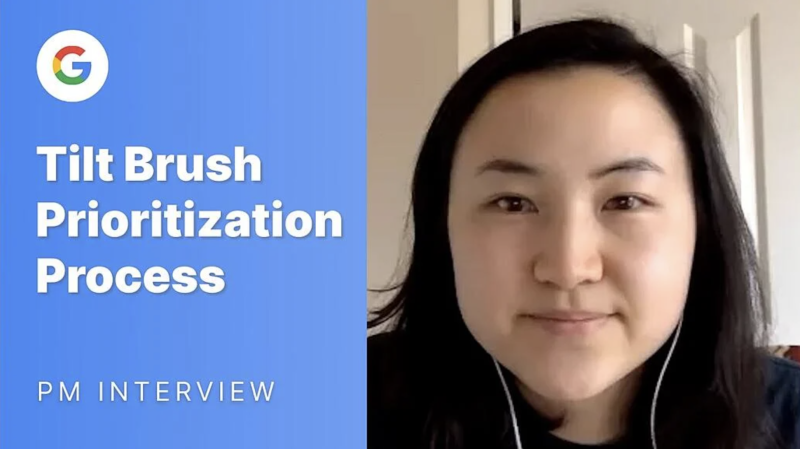
💬 Social post of the week
Itamar Gilad via Twitter
Product managers are a special breed of animal — neither engineering nor business nor design. They thrive when they report to senior PMs who understand their unique set of challenges, can coach them, and give them the freedom they need to do their jobs.
— Itamar Gilad (@ItamarGilad) June 7, 2022
📘 Top product book
In Project to Product: How To Survive and Thrive in the Age of Digital Disruption With the Flow Framework Mik Kersten introduces the Flow Framework―a new way of seeing, measuring, and managing software delivery. The Flow Framework will enable your company's evolution from project-oriented dinosaur to product-centric innovator that thrives in the Age of Software. If you're driving your organization's transformation at any level, this is the book for you.
Feel free to order your copy here.
Developers & PMs 👨🔧💙🙋
Welcome to the next episode of our Product Digest newsletter. This time we choose the topic Developers & PMs. Many of you maybe think about the transition or just want to understand how the other side thinks about the work. Let us know if you have any ideas for the next issue of PD.
⭐️ This week's top picks
📚 What Developers Should Know About Product Management
Learning about business perspective can improve technical decisions that developers need to take on a day-to-day basis. Feel free to read this piece as a first if you are a developer.
📚 Product Manager Relationships: Software Engineers
This post looks at the relationship between a product manager and a software engineer. Another useful perspective for everyone in the product space.
📚 How I Transitioned From Being a Developer to a Product Manager at Amazon
An exciting journey of becoming a product manager from the pen of one who had a strong technical background.
📹 Developer to Product Manager Transition
How to transition from a Developer to a Product Manager? How to transition from an Engineer to a Product Manager? How to transition from an IT specialist to a Product Manager? Answers to all those questions are in this video!
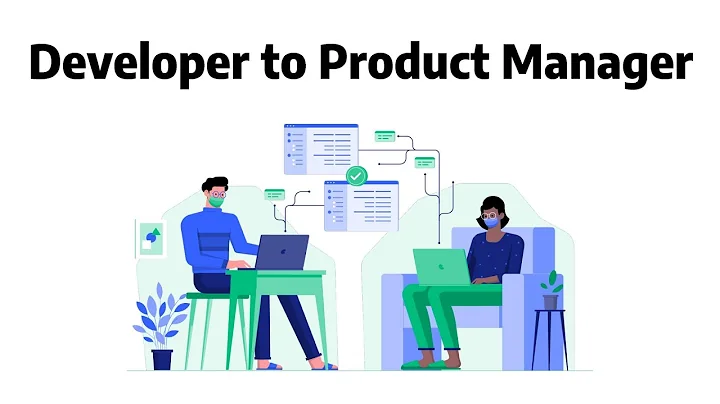
💬 Social post of the week
John Cutler via Twitter
Please … product managers … expand your awareness of the unknown unknowns.
— John Cutler (@johncutlefish) May 26, 2022
Talk to skilled ux researchers and learn about the various methods they use.
There’s a whole universe of expertise to be aware of.
📘 Top product book
Iot Product Manager: Handbook for It Engineer, Iot Data Analyst and Iot Solutions Engineer To Become a Internet of Things Product Manager by Padmaraj Nidagundi will teach you how to become IoT product manager. If you have ever thought to yourself, “I want to become a IoT Product Manager or I want to enhance my skills as a IoT Product Manager” then this is perfect book for you.
Feel free to order your copy here.
Feature Factory 🏭😶
Have you ever thought that you may be working in a feature factory? In this edition of Product Digest, we dive into this topic and brought you several interesting articles. Check them all or if you have never heard about this particular topic watch the video first.
⭐️ This week's top picks
📚 12 Signs You’re Working in a Feature Factory
How do you know if you’re working in a feature factory?
📚 Going From Feature Factory To Continuous Discovery in 1 Year
In this article, there is a focus on the specific organizational and process changes the author made over the course of 1 year.
📚 Transcend the “Feature Factory” Mindset Using Modern Agile and OKR
The alternative to transcend the “Feature Factory” mindset is to embrace modern Agile’s four principles. But how can we apply them in practice? 📹 Do You Have a Scrum Team or a Feature Factory?
Many companies claim to be using Scrum ... but oftentimes there isn't a Scrum team - the core to Scrum, what many companies often have is a feature factory.
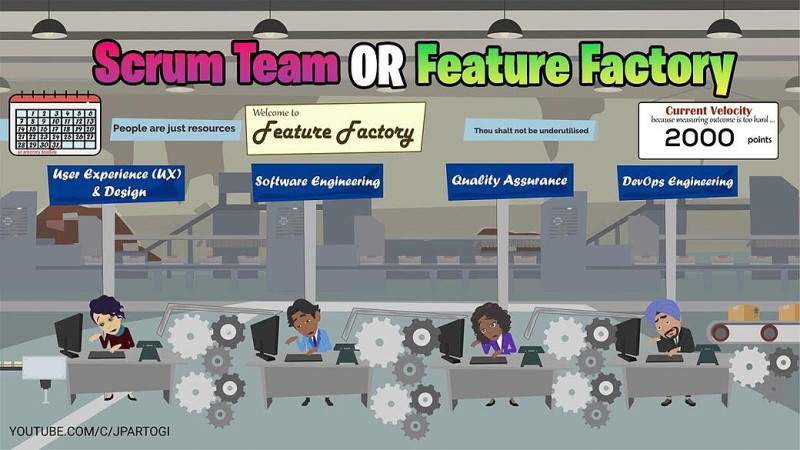
💬 Social post of the week
John Cutler via Twitter
As a company scales one of the biggest challenges is the “unknown unknowns”.
— John Cutler (@johncutlefish) May 13, 2022
Without this l, ppl don’t even know to as someone before they charge into something.
📘 Top product book
Escaping the Build Trap: How Effective Product Management Creates Real Value by Melissa Perri will teach you how to lay the foundation for great product management that can help companies solve real customer problems while achieving business goals. You’ll learn product management principles that can be applied to any organization, big or small.
Feel free to order your free copy here.
Internal Product Management 📈🏢
This week of Product Digest we are covering the topic of internal PM. If you don't know much about it then you can start absorbing more information by downloading our newest guide or just quickly watching the video below. Enjoy the reading and have fun with internal PM.
⭐️ This week's top picks
📚 Life as an Internal Product Manager and How To Make It Work!
There isn’t a whole lot of information or stories from internal product managers on the internet, so this one can give you a sight of what the life of an internal PM can look like.
📚 Internal vs External Product Manager (What’s Right for You?)
There are many specialities within the vast world of product management. A lesser-known, but significant difference in product management is the difference between an internal and external product manager.
📚 Internal Product Management in Digital Transformation
This eBook is meant to not only shed light on the practice of internal product management but also clarify why product management practices are vital for managing internal initiatives with IT teams for companies that want to remain competitive.
📹 Building Internal Tools Is Product Management Too
Lightning talk by Hannah Bertiger, Product at Walmart about building internal tools using an outcome-based approach and product management best practices.
💬 Social post of the week
John Cutler via Twitter
no org change on a grand scale -- no matter how flowery the language and "good sounding" -- is ever without unexpected 2nd and 3rd order effects. Some negative. Some positive. It's hard. Always. And things happen you never intended to happen.
— John Cutler (@johncutlefish) April 29, 2022
📘 Top product book
Build What Matters: Delivering Key Outcomes With Vision-led Product Management by Ben Foster and Rajesh Nerlikar will introduce you to their methodology for becoming a product-driven company. Through their tested strategies and stories of success, you’ll learn how vision-led product management helps you achieve company objectives by meeting both current and future customer needs.
Feel free to order your free copy here.
Data Product Manager & PM
A data product manager focuses on collecting, organizing, storing, and sharing product management data within an organization. Maybe you are working in a data space or you know someone who is thinking about the switch in his/her career more to the product. This issue of Product Digest shows you the most interesting articles and videos about Data PM's role.
⭐️ This week's top picks
📚The Age of Data Product Managers: How To Prepare!
A Data Product Manager is a professional who, in addition to the product, has advanced knowledge of Data Science — nowadays this is a huge opportunity for a career move in the product space and this article will help you with it.
📚 Data Scientist or Data Product Manager? Why You Need Both
Data product manager and a data scientist can divide and conquer their business challenges. As partners, along with their stakeholders, they can define and execute the roadmap that is most likely to drive the most value. Read more about both roles here.
📚 What Good Data Product Managers Do — And Why You Probably Need One
In this article, Barr Moses unpacks the newest data role on the modern data team: the data product manager.
📹 How To Build Data Products by Squarespace Product Manager
Product Management event in New York about how to build data products by Product School.
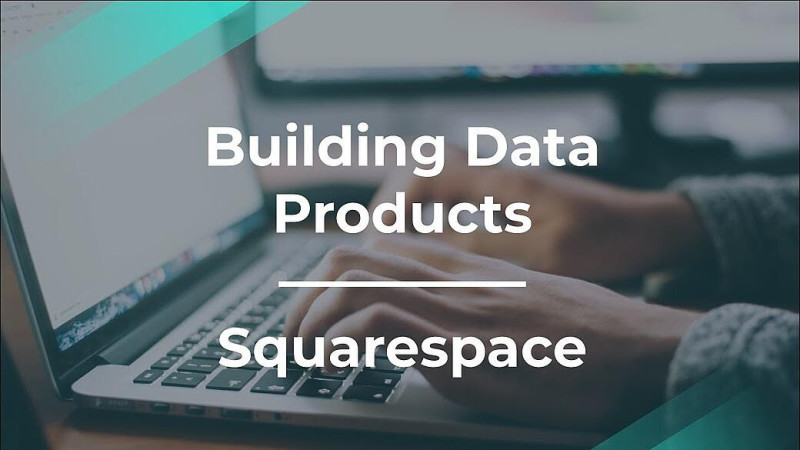
💬 Social post of the week
Mellisa Perri via Twitter
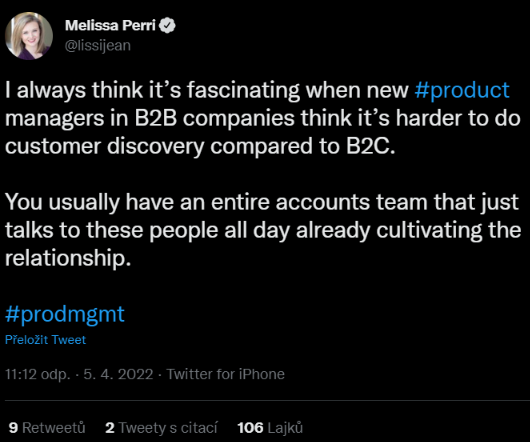
📘 Top product book
Data Science Product Manager: Handbook for Data Scientists, Data Analyst, Analytics Manager, and Data Engineer To Become a Product Manager by Padmaraj Nidagundi is a book full of practical questions/answers for everyone working with data and is interested in a product. If you have ever thought to yourself, “I want to become a Data Science Product Manager or I want to enhance my skills as a DS Product Manager” then this is perfect book for you.
Feel free to order your free copy here.
Product Marketing & PM 📈
Product marketing sits at the intersection of product, sales, CS, and marketing. While this demonstrates the huge impact product marketing can have, it does make defining product marketing a bit more challenging. To help you understand the role we have prepared this issue of Product Digest mainly focused on PMM.
⭐️ This week's top picks
📚 Product Marketing Tips and Strategies
Yasmeen Turayhi, Product Marketing Executive and organizer of a famous show called "The Essential Go To Market: Tips and Strategies" shared her tips from some of her recent guests.
📚 Product Manager vs. Product Marketing Manager
A product marketing manager assists the product team and the company by assessing competitor products and conducting extensive research to see how the product is faring in the market. Learn more from our online guide for product managers.
📚 17 Things We’ve Learned From Top Product Marketers
Interviews with the top 1% product marketers from companies like Gong, Privy and Highspot for advice around marketing's most in-demand role.
📹 Product Management vs Product Marketing
A simplified comparison of the roles: How they are interrelated; how they bring value; and why it might be time for your organization to have both.

💬 Social post of the week
Most important marketplace KPIs to track:
— Lenny Rachitsky | lennysan.eth (@lennysan) March 29, 2022
1. Fill rate: % of intentful sessions that end up converting
2. Bookings growth: # of completed transactions
3. Supply growth: New active supply
4. GMV growth: Dollars going through your system
📘 Top product book
Well-Designed: How to Use Empathy to Create Products People Love by Jon Kolko is a book full of insightful knowledge whether you’re a designer, a product developer, or a marketer thinking about your company’s next offering, this book will forever change the way you think about—and create—successful products.
Feel free to buy your copy of this book here.
Growth & PM 🎓🚀
We have looked into the statistics and it seems that most of you are interested in growth & product management. Therefore we curated the most interesting resources about this particular topic and you can enjoy the weekend with some interesting readings.
⭐️ This week's top picks
📚 Product Growth and Various Types of Product Managers
Product growth is what the product teams working in growth do to execute that strategy. If you have never heard about the growth in product management this article can help you to understand the basics.
Marketing, engineering and design play critical roles on a growth team but product is uniquely positioned as the cross-functional ‘glue’, the business expert and the voice of the customers. Read more in this article.
📚 What is Growth Product Management?
Growth product management is a specialized form of product management, with focuses on how to make the product become successful. If you are completely new this piece can help you.
📹 How to Create a Product Led Growth Strategy
Building a product-led growth strategy can seem complicated, but it doesn't have to be. In this session, Mickey, CTO of Gainsight, breaks down what it really takes to build a robust product-led growth strategy.
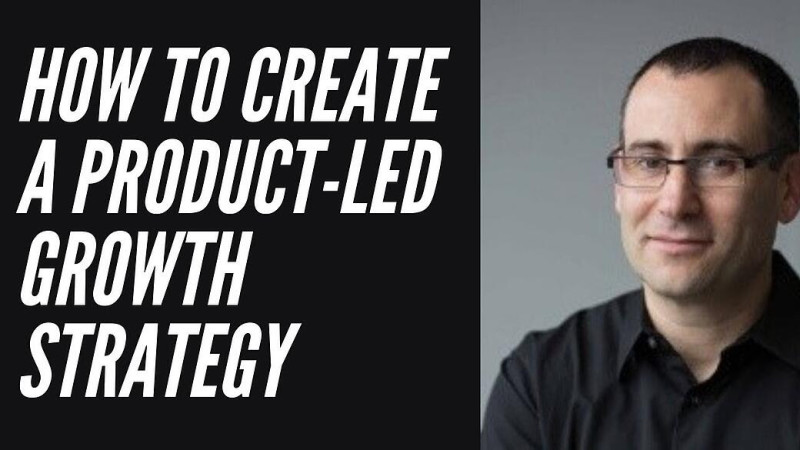
💬 Social post of the week
Marty Cagan via Twitter
And for those with the appetite to dive deeper into the differences between the two product worlds, this is what I consider my most important article in the past several years: https://t.co/owlVumfWPR
— Marty Cagan (@cagan) January 29, 2022
📘 Top product book
Product-led Growth: How To Build a Product That Sells Itself by Wes Bush is a book full of insightful knowledge that comes packed with "do this, not that" real-life examples from the industry’s biggest brands - as well as a collection of high-converting email scripts you can customize and send out immediately to turn more users into customers.
Feel free to order your free copy here.
Empathy & PM🤗
Another weekend is here and we are bringing you the newest issue of our weekly newsletter. This week we will look into empathy. You will learn how to develop this skill by reading our recommended articles, book or feel free to watch the video.
⭐️ This week's top picks
📚 How To Use Empathy To Be a Better Product Manager
Here’s a look at empathy, explaining why it’s important for product managers and what you can do to build your empathy muscles.
📚 How To Develop Product Sense
Product sense is not only one of the most important PM skills - but it’s also often the hardest to learn. Read more in a brilliant article from Jules Walter, Product Leader at Youtube.
📚 The Fine Line Between Empathy and Assumptions in Product Management
”Do you walk in your user’s shoes?”, in other words, “Do you have empathy for your users?”, are some of those rhetorical questions, the answer to which is expected to be an astounding ‘YES’. Learn more about empathy for your users or customers in the following article.
📹 Empathy and Product Management
How important is the ability to be empathetic as a Product Manager?
William Keck, Director of Product Management for Apartment Guide, speaks on empathy and a few key fundamentals of Product Management.
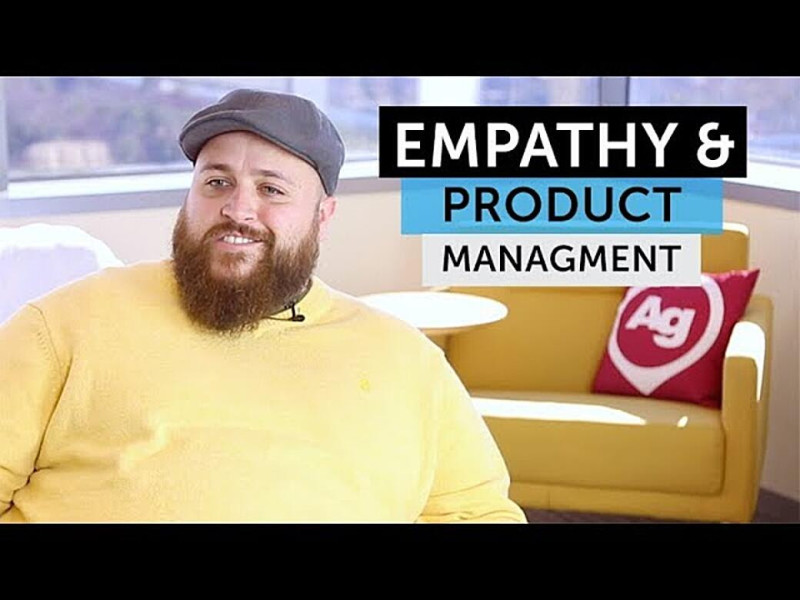
💬 Social post of the week
John Cutler via Twitter
product management is 90% forecasting...
— John Cutler (@johncutlefish) March 18, 2022
...forecasting whether anyone will read your doc
📘 Top product book
Well-Designed: How to Use Empathy to Create Products People Love by Jon Kolko is a book full of insightful knowledge whether you’re a designer, a product developer, or a marketer thinking about your company’s next offering, this book will forever change the way you think about—and create—successful products.
Feel free to buy your copy of this book here.
Customer Centricity ⭕
This week we focus on customer centricity and customer value. We've rounded up the best reads about customer centricity, alongside a great book around customer value. Don't forget to watch a video presentation on a similar topic. Easy to digest with a lot of value.
⭐️ This week's top picks
📚 Value Propositions for Product Managers
One of your most valuable tools as a product manager is the value proposition. Learn how to use value propositions to drive unique value to customers.
If you wish to modernize the way you create products, start by putting the customers at the center of everything.
📚 What Is Customer Centricity and Why You Need a Strategy
Customer centricity is the act of putting the customer at the forefront of every decision you make while developing a product. It’s about understanding your customers at a holistic level.
🎥 Defining Customer Value: A Deep Dive for Software Product Leaders
Customer value plays a critical role in every software business, but is often misunderstood or underutilized. Feel free to see this video presentation to learn more about it.
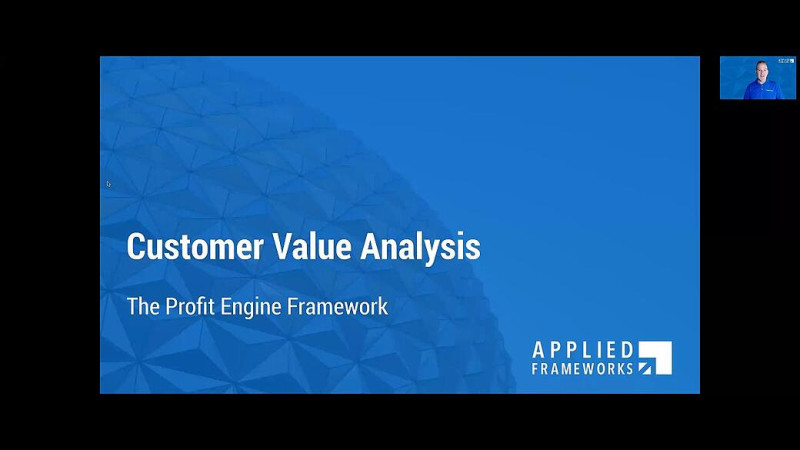
💬 Social post of the week
John Cutler via Twitter
"things keep going up and to the right ... so we must be doing something right"
— John Cutler (@johncutlefish) March 9, 2022
yes, and that thing could have been done right five years ago. oh and luck
📘 Top product book
The Customer Centricity Playbook: Implement a Winning Strategy Driven by Customer Lifetime Value by Peter Fader and Sarah E. Toms is the best choice for everyone interested in focusing on the right customers for strategic advantage. In this new book, Fader and Toms offer a real playbook for companies of all sizes that want to create and implement a winning strategy to acquire, develop, and retain customers for the greatest value.
Feel free to buy your copy of this book here.
Product Discovery 🔎
Another week is behind us and you are reading the newest Product Digest. We have handpicked for you several interesting articles about product discovery and all the related topics.
⭐️ This week's top picks
📚 Product Discovery Is a Mindset, Not a Process
In this article you will read what product discovery means to the author Andrea Milan, Product Lead at Subito. You will learn some of the pitfalls he has seen or experienced in his life, and he will share with you some tips on how to enhance continuous discovery in your organization.
📚 How We Invalidated 7 Business Ideas in 4 Months
During the last 4 months of continuous discovery an author of this article, Jan Riethmayer, invalidated 7 business ideas that he believed were real problems but after conducting over 60 user interviews made it clear they were not.
📚 A Quick Guide to Product Discovery - 4 Product Discovery Methods
The two most fundamental issues to solve for a product manager are building the RIGHT product and building the product RIGHT. Both are equally important and are reflected in the phases of product discovery and delivery. In this article, we take a closer look at what product discovery means and how to do it.
🎥 Product Discovery Process Overview
Tetiana Sverhunenko, Business Analysis Competency Lead at AltexSoft, explains the idea and major steps of product discovery. Here, she explains what lean approach has to do with product discovery, and how MVP helps us deliver better products.
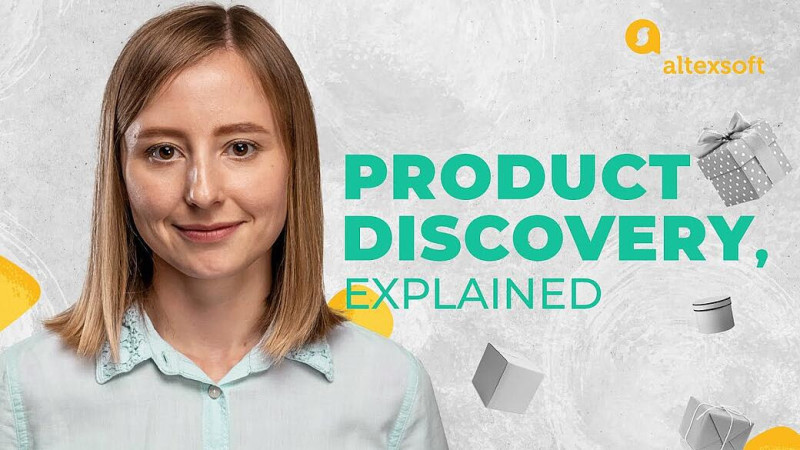
💬 Social post of the week
Teresa Torres via Twitter
"Outcomes should be set by a two-way negotiation between leadership and the product team." - @ttorres https://t.co/CRo0n54nDu #prodmgmt #ux pic.twitter.com/4dO1mmzbol
— Teresa Torres (@ttorres) February 25, 2022
📘 Top product book
Inspired: How To Create Tech Products Customers Love by Marty Cagan is an evergreen classic and it should be on the shelf of every product manager. It is an extra valuable resource of information for technology product managers. This book will take you and your product organization to a new level of customer engagement, consistent innovation, and business success.
Feel free to buy your copy of this book here.
OKRs & Roadmaps👌
We are here again with your weekly product management articles. Today we are kicking off the weekend with OKRs & roadmaps topic. Read the articles, watch the video or order the book if you want to level up your PM skills quickly.
⭐️ This week's top picks
📚 Connection Between OKRs, Product Roadmap, and PMT KPIs
There are many ways how you can build your product, roadmap, and vision. This article is one of the good ways to start with it. It will explain to you the basics of this topic.
📚 OKR vs Roadmap: Is OKR Replacement of Product Roadmap?
Differences and similarities between OKRs and roadmaps. Read the article if you are planning to work with both of them.
📚 How To Align OKRs to Roadmaps
OKRs help you put some metrics around the problem you’re trying to solve. Roadmaps help you communicate the things you’re going to use to reach your outcome. To truly understand how the two fit together, it’s best to get on the same page about what OKRs and roadmaps are so we can then look at how they work together. 🎥 OKRs for Strategic, Outcome-based Planning by the New York Times PM, Brian Peterson
As a Product Manager, you’re responsible for delivering products and features that both delight customers and move the company closer to its top-line metrics. However, how do you know whether the individual features you ship each sprint or each quarter are successful?

💬 Social post of the week
John Cutler via Twitter
something every product manager, designer, and developer should think about
— John Cutler (@johncutlefish) February 23, 2022
when applying for a job, talk to people in support, customer success, and marketing.
judge a culture not by how your peers are treated, but how the ppl with much lower comp and visibility are treated
📘 Top product book
Product Direction: How To Build Successful Products at Scale With Strategy, Roadmaps, and Objectives and Key Results (OKRs) by Nacho Bassino helps interdisciplinary teams learn how to discover and deliver the right solutions to delight customers while creating a sustainable business model. A very helpful book for anyone interested in how to connect OKRs and roadmap.
Feel free to buy your copy of this book here.
Roadmapping 🗺️🛣️🚀
This week we will share with you some interesting articles mostly about roadmapping. Maybe some of you wanted really dive deep into the making product roadmaps and then now is the ideal time to start planning and learning how you will jump in. Maybe this Product Digest will help you.
⭐️ This week's top picks
📚 The Most Effective Product Roadmap Types You Need To Know
No product can be done properly without a product roadmap to simplify the process and keep the entire team on the right track. In this article, Maja Dakić goes through the general categorization of roadmaps.
60+ pages full of information about roadmapping and especially product roadmap: what is it, how to create a product roadmap, types of roadmaps, prioritization and tips on how to communicate with stakeholders effectively using roadmaps.
📚 UX Is Dead, Long Live the Product Journey
One of the key aspects in the last 40 years that changed product development was the rise of User Experience (UX). Sasha Milinkovic, UX Consultant, explain his opinion on this topic in his article.
🎥 Best Practices for Product Roadmap — Jeff Lash
Finding Product Roadmaps’ best practices is a challenge for the teams. Thinking from the point of view of sales, marketing or engineering, the priorities always varies between the teams. But this is not negative. What Jeff Lash explains to us is that we have to adapt to the needs of each team to achieve the goal in the best way.
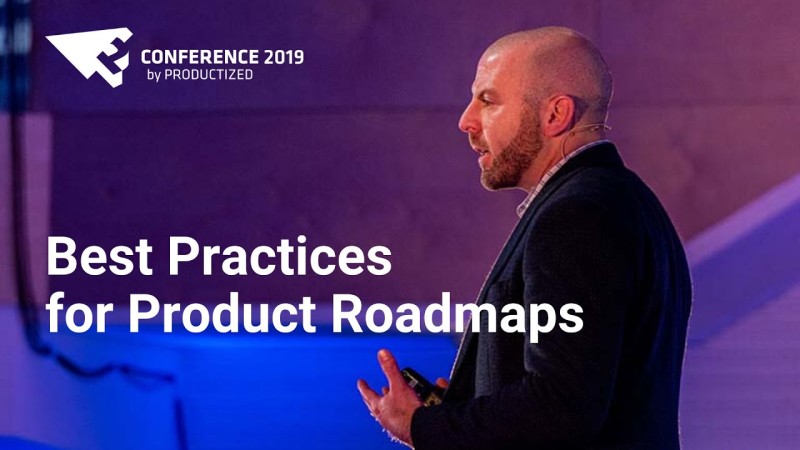
💬 Social post of the week
John Cutler via Twitter
If you were to name a couple "sub communities" in the cross-functional product space...what would they be?
— John Cutler (@johncutlefish) February 18, 2022
product managers, for example, is way too broad
📘 Top product book
Product Roadmaps Relaunched: How to Set Direction while Embracing Uncertainty by C. Todd Lombardo is a practical guide teaching you how to create an effective product roadmap, and demonstrates how to use the roadmap to align stakeholders and prioritize ideas and requests. With it, you’ll learn to communicate how your products will make your customers and organization successful.
Feel free to buy your copy of this book here.
Agile & PM 🤓
Agile is something that everyone should know. However, do we really understand correctly what it means especially in the context of product management? In this episode of Product Digest, we picked some of our favorite tips for readings for you.
⭐️ This week's top picks
📚 The Essence of Agile Product Development Explained
If you are new in product management the word "agile" is something you should really understand well. Read the article from the pen of Kate Dames explaining the essence of agile product development.
📚 Breaking The Walls Between Business and Agile Teams
Managers and product managers are often frustrated by the apparent lack of care the development team is showing for the needs of the business. Itamar Gilad, an experienced ex-Google product manager explains this problem in his article.
📚 Agile: Best Practices and Methodologies
This guide offers an in-depth look into what Agile is, how it benefits product managers specifically, some popular Agile frameworks and the best practices.
🎥 Agile Business Transformation: What It Takes To Succeed
Learn how many of the most successful companies are implementing an agile mindset and framework and achieving excellent results. Interesting TEDx talk with Joe Justice who founded WIKISPEED and operated Agile@Tesla from Tesla's Fremont, California global headquarters. You can watch the video here.

💬 Social post of the week
Itamar Gilad via Twitter "If you want people to listen, tell a story. If you want them to believe, show evidence."

📘 Top product book
Building the Agile Business through Digital Transformation is an in-depth look at transforming businesses so they are fit for purpose in a digitally enabled world. It is a guide for all those needing to better understand, implement and lead digital transformation in the workplace. It sets aside traditional thinking and outdated strategies to explain what steps need to be taken for an organization to become truly agile.
Feel free to buy your copy of this book here.
Collaboration & PM 🚀👨
For most product managers, cross-team collaboration is the essence of their daily routine. In this edition of Product Digest, we decided to explore this space and we hand picked some interesting articles about this particular topic.
⭐️ This week's top picks
📚 Product Manager Relationships: Customer Success
"... if the role of the product manager is to understand the customer’s needs, then relationships with the customer success team are a direct route to the source of valuable information that can be used to understand these needs." Learn more in this article from Robert Drury, Product Management Couch.
📚 7 Trends Shaping Product in 2022 & Why They Matter
Kasey Kaplan, Chief Product Officer at Beforepay, published a new article about 7 key considerations for companies as they embark on their product journey in 2022. Interesting read for everyone who wants to be updated.
📚 6 Tactics on How to Fuse Product & Enterprise Sales for PLG Success
This article is full of insights about sales and PLG success. If you are struggling with setting up processes or striving for inspiration or ideas on how to start things running, you are in a right place.
🎥 Product Management vs Product Marketing
A simplified comparison of the roles: How they are interrelated; how they bring value; and why it might be time for your organization to have both. You can watch the video here.
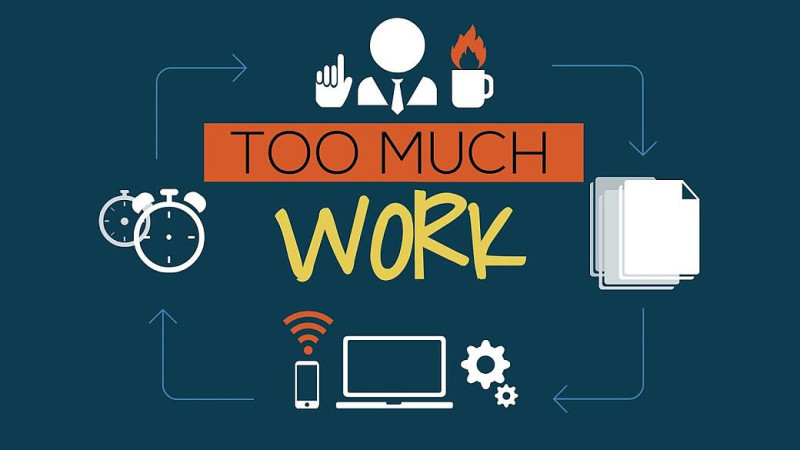
💬 Social post of the week
Jackie Bavaro via Twitter "... in each of 3 phases of a PM career means success something different.
A big "aha" moment for me was realizing that there are 3 distinct phases of a career in product. An APM's job is only a small slice of what a senior PM does. And that's again a small slice of what a director does. Success means different things at each phase.
— Jackie Bavaro (@jackiebo) January 25, 2022
A thread: pic.twitter.com/js0FEoXoUY
📘 Top product book
Outcomes Over Output by Joshua Seiden is an important read for every product manager. A great tool to include in your mental tool kit. This book coaches us to think and lead our teams by outcomes in order to focus on customer behaviors that bring business results, as well as meaningful transformations in any organization.
Feel free to buy your copy of this book here.
Data & PM🎓📊
This week we focus on data and product management. We have picked for you three interesting articles and one self-explaining video from the data product manager. Data PM is growing so catch this trend with us and enjoy the articles.
⭐️ This week's top picks
📚 How We’re Building Our Data Platform as a Product
Learn why it’s critical for a modern data platform team like Stuart’s to “think product” in truly delivering business value.
The following blog post is a summary of a few key concepts taught during the course on designing data products by Lutz Finger, Group Product Manager at Google.
📚 The Rise of Data Products and Their Owners
Interesting article from the pen of Jaakko Mikkonen, Head of Customer Analytics and Data Management at If. He is exploring the space behind data product managers and their participation in creating value for data consumers at If.
🎥 The Basics of Data Product Management by Eric Weber, Head of Data Products at Yelp
Head of Data Products at Yelp, Eric Weber explaining in this video how to create data products that drive business value. Highly recommend you see this video if you are interested and new in data product management.
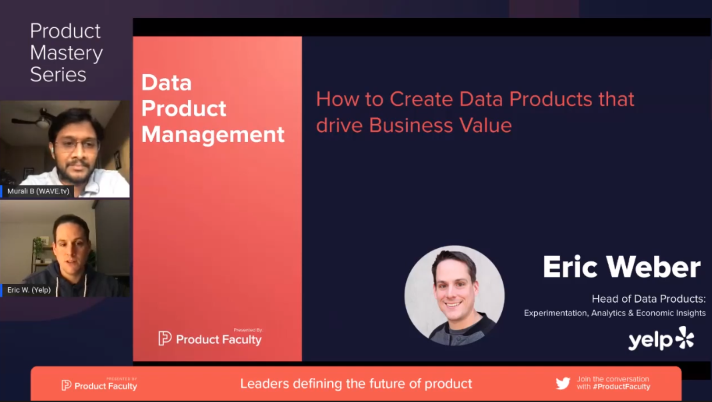
💬 Social post of the week
Teresa Torres via Twitter
"... when we shift from an output mindset to an outcome mindset, we have to relearn how to do our jobs." Do you agree?
Most product trios don’t have experience with driving outcomes.
— Teresa Torres (@ttorres) January 21, 2022
They grew up in a world where they were told what to build.
So, when we shift from an output mindset to an outcome mindset, we have to relearn how to do our jobs.
Learn more in my book https://t.co/gY1HjyiWXq #ux pic.twitter.com/3Swg6NZ09Y
📘 Top product book
This Product Data Management A Complete Guide (Kindle Edition) is an instant Product Data Management self-assessment that will make you the entrusted Product Data Management domain adviser by revealing just what you need to know to be fluent and ready for any Product Data Management challenge.
Feel free to buy your copy of this book here.
OKRs & PM💪🚀
This week we focus on OKRs and product management. We have picked for you three interesting articles and if you want to understand more about this framework don't forget to watch the TED talk video.
⭐️ This week's top picks
📚 20+ OKR Best Practice Tips From Experts
Setting Product OKRs is becoming increasingly common in business. What challenges do organizations face in doing this, and what’s the best way to go about it? Ahead of airfocus’ upcoming roundtable - Kick Off 2022 by Setting Your Product OKRs Right – we are running a series of interviews with the participants, beginning with Kent J. McDonald.
📚 OKRs for Early Stage Startups
João Craveiro's article can be beneficial for everyone in early-stage startup. You will learn how to manage and set up all-important objectives across the team.
📚 Best Practice When Setting Product OKRs – The Consultant Perspective, With Robin Zaragoza
In this interview we speak with Robin Zaragoza, consultant and Founder & CEO of The Product Refinery about her perspective on setting product OKRs.
🎥 Why the Secret to Success Is Setting the Right Goals
In this practical video, Doerr shows us how we can get back on track with "Objectives and Key Results," or OKRs -- a goal-setting system that's been employed by the likes of Google, Intel and Bono to set and execute on audacious goals.

💬 Social post of the week
Dare Obasanjo via Twitter
... are you an aspiring product leader? Read this tweet then.
Many people want to be managers to grow their careers but in reality being a leader is more important in the long run. A leader is someone whose authority is earned and people choose to follow as opposed to someone people have to follow because it’s their job.
— Dare Obasanjo (@Carnage4Life) January 10, 2022
Good leaders are…
📘 Top product book
Even if you don’t really aspire to be a full-time UX designer, as a product manager it’s useful to understand basic UX principles so you can build better, more beautiful, and user-friendly products. This book is a true piece of art, delivering bite sizes of UX design best practices and principles you can easily remember.
Feel free to buy your copy of this book here.
Digital Transformation & PM 💪🚀
This week we focus on digital transformation & product management. Check the collection of articles below and if you have never heard about this topic then you can start your learning session with the video.
⭐️ This week's top picks
📚 Best Practice When Setting Product OKRs – The Product Manager Perspective, With Kent J. McDonald
Setting Product OKRs is becoming increasingly common in business. What challenges do organizations face in doing this, and what’s the best way to go about it? Ahead of airfocus’ upcoming roundtable - Kick Off 2022 by Setting Your Product OKRs Right – we are running a series of interviews with the participants, beginning with Kent J. McDonald.
📚 The Rising Importance of Product Managers in a Digital Transformation
As the world moves further towards digital, our products and services are moving faster than ever. The same is true for changes in customer buying habits. Let's explore together the rising importance of product managers in a digital transformation in this article.
📚 Stop Asking Your Users What They Want
Amy Rogers gathered and explained four common questions you should avoid if you want to improve the quality of your user interviews.
🎥 Product Management – The Lever for Digital Transformation
The following video can take you through all basic information about the role of product management in companies going through digital transformation. If you have never heard about this you will probably like it!

💬 Social post of the week
I’m excited to host a free webinar on the what and why of continuous discovery. Join us February 1st. Sign up here: https://t.co/b73twBooHb #prodmgmt #ux pic.twitter.com/UkI6GavvTP
— Teresa Torres (@ttorres) January 3, 2022
📘 Top product book
Last week we gave you a recommendation for the book about OKRs. This week we can add another resource to study this field more. Objectives and Key Results: Driving Focus, Alignment, and Engagement is an interesting book that will help you understand the basics of OKRs and you will learn how to gain knowledge to implement this framework. This book is your key resource for designing, planning, implementing, and maintaining your OKRs program for sustainable company-wide success.
Feel free to buy your copy of this book here.
2022 Year Edition
Hi everyone,
Welcome to the January 2022 edition of our weekly curated newsletter. This edition of Product Digest will introduce you to a mix of the useful topics to kick off your new year in the right direction. We will share with you some upcoming trends and practical tips for the beginning of the year.
Have a great weekend!
⭐️ This week's top picks
📚 IT Takes on a Product Mindset
The need to co-create with the business has many CIOs shifting away from IT projects in favor of a product-based approach that, like so much else in business, is a journey that takes time to nurture and succeed.
📚 Welcome to 2022: The Year of Product Management
What can we expect from product management in 2022? We asked some of the most influential names in the industry and here’s what they had to say.
An interesting story about the transition from a customer success role to a product management role with all the valuable insights. 🎥 The Rise of Product Ops
Still a pretty new function in the product world, Product Operations is quickly growing in popularity, particularly in large organisations, and, naturally, in companies building tools for product managers. But is Product Ops just the next hype, or a step towards fragmenting the Product Manager role further?
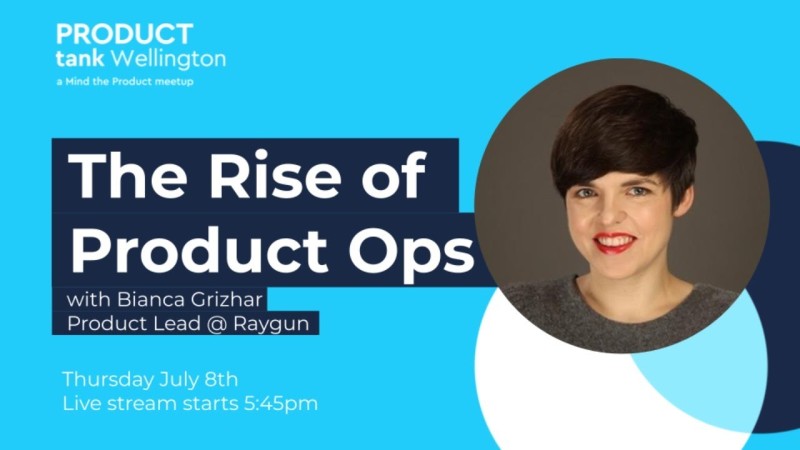
💬 Social post of the week
2022 off to a good start pic.twitter.com/RVW9GdFCnI
— Lenny Rachitsky | lennysan.eth (@lennysan) January 1, 2022
📘 Top product book
It's the new year 2022 here and many of us are setting up the goals that we want to achieve.
Today we would like to introduce you a book that can help you with it. Setting goals as outcomes sounds simple, but it can be hard to do in practice. The book Outcomes Over Output: Why Customer Behavior Is the Key Metric for Business Success is a practical guide to using outcomes to guide the work of your team.
Feel free to buy your copy of this book here.
Develop Your PM Career 🎓
Hi everyone,
the next round of our Product Digest newsletter is here! In this December edition we have prepared our picks around career topics. You'll learn the best practices from top PMs and don't forget to check the tip for the top product book down below.
Have a great weekend everyone!
⭐️ This week's top picks
📚 Reflecting on a Career in Product Management
Nice reflection on a career in product management from the pen of Ken Norton, a famous Product Manager known for his work at Google and other big enterprises. Anyone who wants to shape a career (not only in product management) can benefit from his blog post.
📚 How To Excel as a Product Manager at an Early-stage Startup
Tim Winkler is an entrepreneur, startup founder and community builder who knows a lot about product management. Read his article to learn how to adapt and excel as a product manager in an early-stage startup company and let your product shine.
📚 What To Do in Your First 30 - 60 - 90 Days as a Product Manager
Kent McDonald has written an article for your first three months in a new company. You should create a plan to get up to speed at a pace that is not overwhelming but doesn’t leave you bored. Here’s an overview of a 30-60-90 day plan for a product manager.
📹 How To Become a Product Operations Manager (Top 5 Tech Jobs)
Want to know how to become a Product Operations Manager at top tech companies? Watch the following video from Colin Late, Senior Product Director from Silicon Valley.

💬 Social post of the week
Toby Rogers via Twitter
10 people every product manager should follow:
— Toby Rogers 🚀🤘 (@tobiasrogers) November 28, 2021
Leadership @shreyas
Strategy @gibsonbiddle
Tactics @johncutlefish
Positioning @aprildunford
Discovery @ttorres
Roadmaps @simplybastow
Delivery @lissijean
OKRs @cwodtke
Community @lennysan
Career @jackiebo
📚Top product book
The authors of this book are Blair Reeves and Benjamin Gaines. Both are experienced product managers from enterprise software companies.
Building Products for the Enterprise: Product Management in Enterprise Software explains critical differences between enterprise and consumer products, and deliver strategies for overcoming challenges when building products for the enterprise. If you are in a stage of switching your career to an enterprise company or want to improve your processes this book will help you with it.
Feel free to buy your copy of this book here.
Discovery and Product Management💪
Welcome to the next week of our Product Digest’s newsletter. This week we handpicked for you some interesting articles around the discovery and customer centricity topics. If you are new to PM - these articles are a must.
Plus if you considering buying Daniel Thulfaut's new ebook. Don’t forget to use the code mentioned in the description.
Have a great weekend everyone!
⭐️ This week's top picks
📚 From Vision to Version eBook
Strategy Framework for Digital Product Management Rockstars. Step by step guide for crafting and aligning your product vision, strategy and roadmap.
Use discount code: airfocusROCKS if you're interested in buying this ebook. By subscribing to Daniel’s newsletter you will get one chapter of the ebook for free.
📚 Continuous Benchmarking: The Task Everyone in Product Should Do
... “I’ve worked on numerous positions on product teams. From junior product assistant, to running the entire show, to everything somewhere in between. There is one task I’ve found vital in all of them. I call it continuous benchmarking.“ Amazing article from Penelope, Head of Product working at InlineManual.
📚 Introducing People Skills for Product People
People Skills for Product People was a live course from the skilled product manager Pradip Khakhar. If you are struggling with soft skills then his course can help you to improve and raise the bar for upcoming days. Feel free to follow Pradip to be updated.
📚 What Is Customer Centricity and Why You Need a Strategy
The way customers research, use, and buy products or services is changing. Therefore, the way companies attract customers, position their products or service, and sell is evolving. Customers are ever more empowered than before.
📹 Introduction to Modern Product Discovery - Teresa Torres
Teresa spoke about how to understand the trends in the field and additionally how to pick-and-choose these methods to form a coherent strategy that ultimately lead to a better product. Everyone who is interested in the discovery process can benefit from her speech.

💬 Social post of the week

📚Top product book
"If you haven't had the good fortune to be coached by a strong leader or product coach, this book can help fill that gap and set you on the path to success."- Marty Cagan
Continuous Discovery Habits: Discover Products that Create Customer Value and Business Value is a masterpiece written by Teresa Torres, internationally acclaimed author, speaker, and coach and this book should be on the shelf of every product manager.
Feel free to buy your copy of this book here.
Communication and Product 👂👄
Welcome to the December edition of Product Digest - your weekly curated newsletter about product management topics. This week we have picked several articles for your weekend readings. Most of them are around important product manager's skill communication.
⭐️ This week's top picks
📚 17 Things We’ve Learned From Top Product Marketers
Interesting article to read. It is full of interviews with the top 1% product marketers from companies like Gong, Privy and Highspot for advice around marketing’s most in-demand role.
📚 Product Management Trends and Challenges in 2022 – A Product Coach Perspective With Lisa Mo Wagner
It’s something that we’ve been hearing more and more over the past 18 months and it’s a topic that’s certain to come up in our upcoming roundtable - Product Management Trends and Challenges in 2022.
📚 Introducing People Skills for Product People
People Skills for Product People was a live course from the skilled product manager Pradip Khakhar. If you are struggling with soft skills then his course can help you to improve and raise the bar for upcoming days. Feel free to follow Pradip to be updated.
📹 What It Takes To Be a Product Management Coach With Lisa Mo Wagner
What does it take to become a great product manager? In this video they asked someone who has been both a product manager and a coach for others, Lisa Mo Wagner.
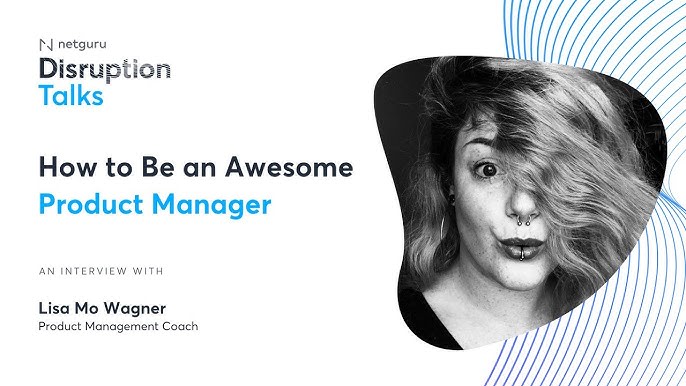
💬 Social post of the week
As PMs, we don't write code or create designs, *communication is the job* 📢
— Justin Williams (@Product_Foolery) December 3, 2021
As @lennysan's says: “Whenever someone asks me what is the one skill I can work to become a better PM, I say communication.”
🏆In a survey of over 1k PMs, comms was the #1 skill pic.twitter.com/tugD2ptdme
📚Top product book
Product Management’s Sacred Seven: The Skills Required To Crush Product Manager Interviews and Be a World-class PM is a book authored by 3 product managers at Facebook, Google, and Microsoft.
Product Management’s Sacred Seven is a comprehensive resource that will teach you the must-know knowledge and applied skills necessary to become a world-class PM that can get hired anywhere.
Feel free to buy your copy of this book here.
Growth and Feedback 🚀💪
In this last November edition of Product Digest, you can learn more about growth and feedback. Whether you are involved in the hiring process, are responsible for the product team's structure, or just want to brush up on some good-to-have PM skills, you can benefit from the articles we picked for you this week.
⭐️ This week's top picks
📚 Building Feedback Loops Into Your Business Model
Now that we have spent some time thinking about other business models in the market place let’s start developing this one. Today we are going to look at key resources in the business model, and how feedback loops make your business model more powerful.
📚 Six Rules of Hiring for Growth
As Paul Graham teaches us, “Startup = growth. The only essential thing is growth. Everything else we associate with startups follows from growth.” Thus, your first growth hire is one of the most important hires you’ll make.
📚 How To Manage Customer Feedback
Let’s be blunt. No matter what your product or what sector you operate in, your customer is the core driver of business and your most valuable asset. If you choose to ignore customer feedback, you’re choosing to lose those customers. It couldn’t be any simpler.
There’s a new kind of product manager in town: the growth product manager. This emerging role is taking hold throughout the software industry, but is especially prevalent within product-led organizations. In these companies, the product itself is a primary lever for growth, so it makes sense for the product team to take on growth responsibilities tied to revenue.
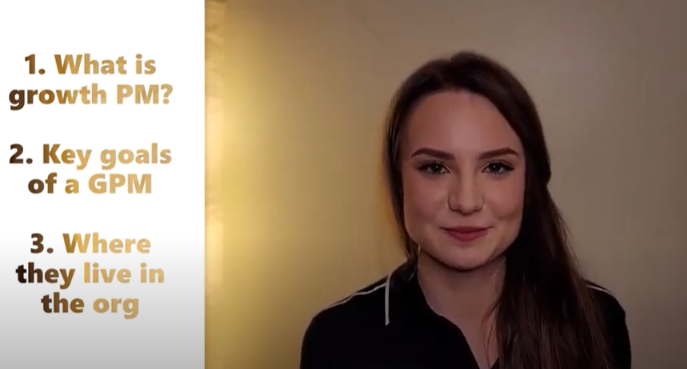
💬 Social post of the week
Most important metrics to track when building a consumer business 👇 pic.twitter.com/HYrOHuZKZv
— Lenny Rachitsky (@lennysan) November 23, 2021
📘 Top product book
”This book should be mandatory reading for entrepreneurs, and the same goes for managers who want better entrepreneurial instincts. Ries’s book is loaded with fascinating stories—not to mention countless practical principles you’ll dearly wish you’d known five years ago.” —Dan Heath, co-author of Switch and Made to Stick.
The author of the book The Lean Startup: How Today’s Entrepreneurs Use Continuous Innovation To Create Radically Successful Businesses, Eric Ries, is an entrepreneur and author of the popular blog Startup Lessons Learned. He co-founded and served as CTO of IMVU.
Feel free to buy your copy of this book here.
Modern Product Management🎓
In this November edition of Product Digest, you can learn more about modern product management. We've compiled a list of evergreen articles from top PMs, a book recommendation, and a webinar from Melissa Perri. Enjoy and have a great weekend!
⭐️ This week's top picks
📚 A New Era for PMs — What Will Product Management Look Like in 2022?
Some trends stay, some trends go, technology unlocks new opportunities, and user needs keep us all on our toes. The fast-paced nature of the job is something you have to love as a PM, but the last 18 months have been a particularly challenging test on our processes and our ability to adapt. The question we need to ask ourselves as we approach the end of 2021 is: what have we learned this year and how can that help us move forward?
📚 4 Easy Ways to Collect Quick User Feedback
Kimberly Berls, Product Lead at Verizon, shares four very easy ways to get fast and useful user feedback. If you are struggling with ideas where you quickly see the feedback, don't forget to read this article.
📚 The 8 Do’s and 500 Don’ts of Interviewing Product Managers
8 valuable tips from experienced Product Manager, Adam Hecht about how to use empathy, time management, and curiosity to judge PM candidates. If you are interested to learn more about this topic, feel free to check our PM book recommendation at the bottom of this newsletter.
📹 Product Operations: The Fuel for Winning Product Strategies
Product Operations is still a rising trend in the software product industry. It’s a function that seeks out and eliminates barriers that prevent leaders from creating, executing, and managing evidence-based product strategy. It’s not a single activity or project, but an ongoing process of learning, discovering, and improving. Check the following webinar to learn more about what Melissa Perri thinks about product operations.
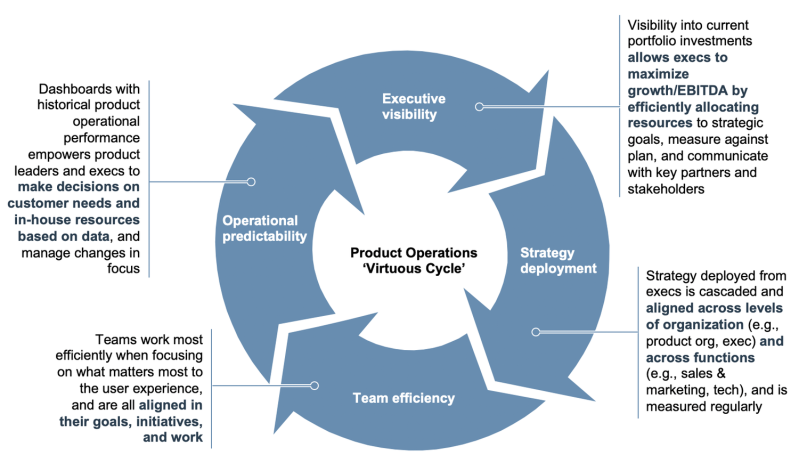
💬 Social post of the week
Hiring for culture fit has benefits, but it's also something we need to do with great care. Focusing too much on fit often means overlooking different cultures, lifestyles, and ways of thinking that would help create a more diverse and more innovative team. #prodmgmt
— Kate Leto (@kleto) November 16, 2021
📘 Top product book
'This book is a fantastic catalyst to rethink which skills you need in a product team in order to be truly innovative - and then details exactly how to change both your hiring and coaching practices to foster those skills in your organisation.' - Martin Eriksson | Co-Author, Product Leadership
The author of the book Hiring Product Managers: Using Product EQ to go beyond culture and skill, Kate Leto is a product management expert with more than 25 years of experience.
Feel free to buy your copy of this book here.
Customer feedback👨🚀
In this week's November edition, you can learn more about customer feedback. Feel free to recommend our Product Digest newsletter to your friends and colleagues if you find it valuable.
⭐️ This week's top picks
📚 7 Ways To Use Customer Feedback To Improve Your Brand and CX
To gain customer feedback nowadays seems like an easy task for brands. But what comes before, in terms of what questions do you want to ask and after, in manners of feedback interpretations is challenging. Will companies use feedback to improve their products and services?
📚 Which Is Better One-time or Continuous Customer Feedback?
Have you ever wondered how you can collect customer feedback with less time and administrative effort and still increase customer satisfaction? Today we would like to give you an answer to this question and, in this context, show you what effects one-time as well as ongoing customer surveys have on your company’s success.
📚 5 Ways to Measure Customer Satisfaction
In order to make sure that customers are happy, you have to ask the right questions and keep track of the answers. You cannot just assume or hope. Here are five ways you can measure customer satisfaction that will better empower your customer success team and decrease churn rate.
📹 How to Close the Loop on Customer Feedback: Best Practices for 2021
In this video, you'll learn about closed-loop feedback best practices. We will share some examples of closed-loop feedback processes and communications, and show you a few ways to use customer feedback to increase customer loyalty, improve employee experience, and grow your business.

💬 Social post of the week
Stop hiding your startup idea thinking someone is going to steal it and instead focus on getting customer feedback as soon as possible. Ideas are worth zero and execution is worth millions.
— Andrew Gazdecki (@agazdecki) November 9, 2021
📘 Top product book
In Build What Matters, Rajesh and Ben introduce you to their methodology for becoming a product-driven company. Through their tested strategies and stories of success, you’ll learn how Vision-Led Product Management helps you achieve company objectives by meeting both current and future customer needs.
Feel free to buy your copy of this book here.
Roadmapping and Other Tips🚀
In this week's edition of Product Digest, we share a mix of articles about roadmapping and other product management tips. Don't forget to check the end of this newsletter and the book of our product hero C. Todd Lombardo. If you like our weekly newsletter, feel free to forward it to your friends or colleagues and every mention is highly appreciated.
⭐️ This week's top picks
[Read] Introduction to Roadmap Architecture
As a Product Manager it is important that you have a roadmap in place. Equally important is that you design your roadmap architecture and structure. This becomes increasingly important as your company, teams and products scale.
[Read] Take a Product Management Approach to Data Monetization
The product management approach of driving progress can be seen in many new verticals. In this article you will learn how data project management evolved to data product management and what are key differences.
[Read] Ideas Are Easy! But Starting Up?
The biggest mistake new entrepreneurs make is not treating their ideas carefully. You want to make sure you prepare thoroughly before starting a business, but realize that things will almost certainly go awry. To run a successful business, you must adapt to changing situations.
[Video] C. Todd Lombardo: Roadmaps Are Dead! Long Live Roadmaps
Do you ever feel like breaking up with your roadmap? In his talk from #mtpcon San Francisco 2018, C. Todd Lombardo takes on a topic that is emotional to most of us as product managers – the product roadmap. Moreover, you can find his book down here. Really recommend it to everyone!
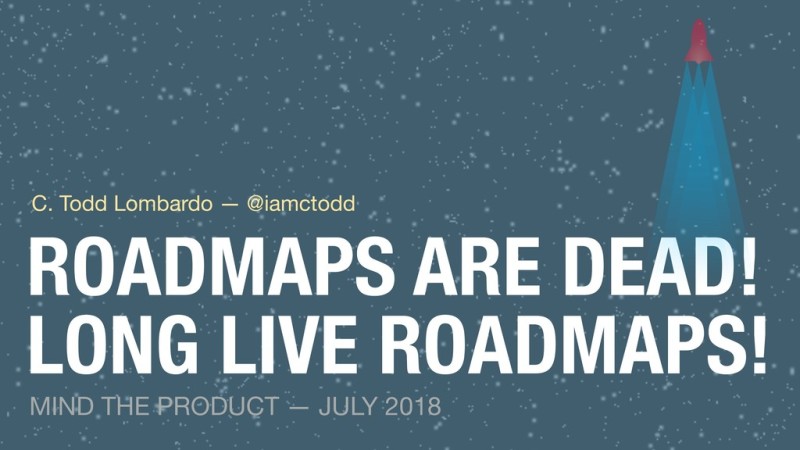
💬 Social post of the week
4 years into my PM career, I made the transition from a generalist role to a growth PM role (driving Airbnb’s supply growth). I loved it. It's fast-paced, high-impact, and at the center of action. If you're hoping to make a similar move, here's my advice.
4 years into my PM career, I made the transition from a generalist role to a growth PM role (driving Airbnb’s supply growth). I loved it. It's fast-paced, high-impact, and at the center of action. If you're hoping to make a similar move, here's my advice.https://t.co/Vhfqqo8YaE
— Lenny Rachitsky (@lennysan) November 2, 2021
📘 Top product book
Product Roadmaps Relaunched: How to Set Direction While Embracing Uncertainty
This practical guide teaches you how to create an effective product roadmap, and demonstrates how to use the roadmap to align stakeholders and prioritize ideas and requests. With it, you’ll learn to communicate how your products will make your customers and organization successful. The author of the book C. Todd Lombardo is VP of product at Openly.
Product Management and PM career🚀
In this week's edition of Product Digest, we share a mix of articles about product management and career development in the PM field.
⭐️ This week's top picks
[Read] How Digital Product Management Promotes Value Stream Management Success
Today, DPM represents a core building block of digitally optimized businesses. DPM is a strategic approach to ensuring technology investments yield maximum returns. Through DPM, teams apply a set of practices that help optimize the evolving management of technology.
[Read] The Case Against Heatmaps
Heatmapping has become a standard part of the website optimization toolkit. However, are they actually useful? Oliver Palmer, CRO Consultant, described the pitfalls of overusing heatmaps and offered alternatives in this article.
[Read] Avoid the Punch: How to Create an Effective Release Plan in an Outcome-Based World
“Release plan?” you might think. “I can’t worry about that! I’m too focused on outcomes!” And, you might be right! One of the most critical things to consider is whether such a concept can function in an outcome-based world. Check out this article by Adam Hecht, Senior Product Manager at Bombas, on how to create effective release plans.
[Video] What Do Product Managers Do?
The Product Manager role continues to be a topic of debate. As teams and organizations grow, the responsibilities of a PM change from being a Swiss army knife doing anything and everything to a skilled influencer creating a shared understanding with the team.
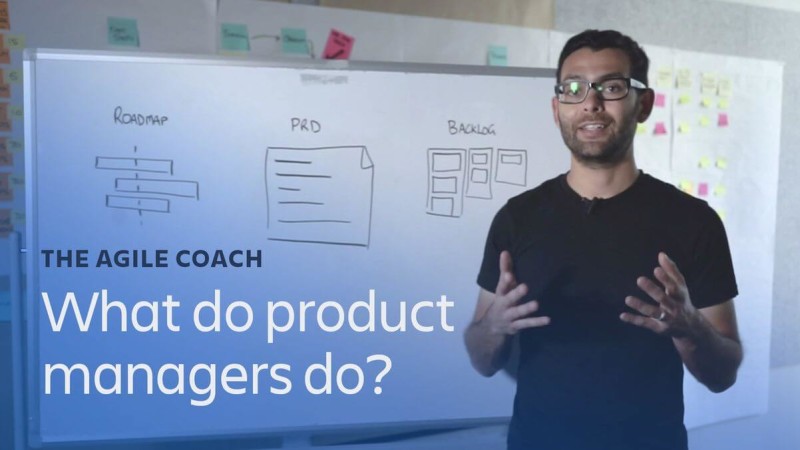
💬 Social post of the week
Great startup hiring advice from @hunterwalk
— Lenny Rachitsky (@lennysan) October 23, 2021
1. Know what excellent looks like
2. Ask candidates who reject you to name names
3. Sell past the close
"Show me the first 20 employees of a startup and I’ll tell you whether it’s going to be successful or not."https://t.co/mtwx5CAUYI
📘 Top product book
Cracking the PM Career: The Skills, Frameworks, and Practices To Become a Great Product Manager
From the authors of the best-selling book, Cracking the PM Interview, Jackie Bavaro and Gayle Laakmann McDowell published another comprehensive guide on the skills, frameworks, and best practices to become a great Product Manager. It will help you level up your skills and career.
Feel free to buy your copy of this book here.
Agile, SAFe and Other Topics🎓
In this week's October edition, you can learn more about Agile, SAFe, and some basics for everyone interested in Kanban roadmaps and how to conquer PM interview questions. Have a great start to the weekend!
⭐️ This week's top picks
[Read] What is a Kanban Roadmap?
There is no such thing as a Kanban roadmap - so where did this term come from, anyway? Let's start with the basics. A popular article written by our Senior Product Manager, Andrea Saez, shares with you what is Kanban, and what's the difference between Kanban boards and product roadmaps.
[Read] The Product Management Career Framework Your Team Deserves
If you are already leading a team of Product Managers or want to grow as a Product Manager, Program Manager or Product Owner, this article is helpful for anyone who wants to improve or start their product management careers.
[Read] Beware SAFe (The Scaled Agile Framework for Enterprise), an Unholy Incarnation of Darkness
If you agree with the social media post of the week below, then you can read more information about this topic here in this article written by Sean Dexter, Senior Product Designer of Hubspot.
[Video] Agile Scrum Full Course in 4 Hours
In this video, you will learn everything you need to know about Agile and Scrum - Agile project management, Agile user stories, Scaled Agile Framework, how Scrum, Kanban, and Agile are different from one another, and so much more! Watch it here.

💬 Social post of the week
Austin Yang via Twitter
Tip for product managers:
— Austin Yang✌️ (@IamAustinYang) October 8, 2021
If you see a company splitting PM/PO roles or running SAFe, run as fast as you can!
🏃🏃♀️🏃♂️
📘 Top product book
Decode and Conquer: Answers to Product Management Interviews is your starting point on how to conquer the most difficult PM interview questions.
The author, Lewis C. Lin, CEO of Impact Interview, was Microsoft's Director of Product Management. Before Microsoft, he worked at Google, leading new AdWords product launches.
Feel free to buy your copy of this book here.
Prioritizing, Product-Led Growth and Other Topics 🎓
In this week's edition, we would like to share with you a mix of useful tips across the topics. You can read about mapping, product-led growth or prioritization. Also, don't forget to check out our newly launched app airfocus Insights - the most flexible way you can centralize your feedback and inform your product discovery.
⭐️ This week's top picks
[Read] Mapping: An Introductory Guide for Product Teams
Mapping is a visual framework that can be extremely useful for product teams. Maps come in all shapes and sizes: experience maps, customer journey maps, life of the customer maps, user story maps, mind maps, process maps, network maps, empathy maps, and so on... Teresa Torres, internationally acclaimed consultant and speaker shares her insights in this guide with you.
[Read] Culture for Product-Led Growth: How to Implement Flat Spaces in Your Company
You can create flat spaces at all levels. It’s a versatile product tool because it’s basically a principled belief that successfully harnessing your entire team can yield better outcomes. From Product Managers to Chief Product Officers, everyone can use the tactics to good effect. Oji Udezue, VP of Product at Calendly.com, shares his tips for the ones who are going to implement this strategy.
[Read] My Product Management Toolkit (46): Making Decisions
Have you ever struggled to make a decision? Mark Abraham, world-known PM, wrote an article about the process of making decisions. Being able to make decisions or motivate others to make decisions is a core part of being a Product Manager - almost everyone can benefit from his knowledge.
[Video] How to Prioritize and Make Decisions As a PM
If you want to extend the previous tip about making decisions then we would like to invite you to watch the following video from Product School - How to Prioritize and Make Decisions As a PM.

💬 Social post of the week
Melissa Perri via Twitter
Do you agree with Melissa on the following statement? Melissa Perri is a seasoned PM and the author of Escaping the Build Trap.
There’s something I’ve been playing around with in my head as it relates to “product thinking” and I’m going to try to describe it here, although not fully formed yet.
— Melissa Perri (@lissijean) October 7, 2021
I think we do a real disservice to “#prodmgmt” when we talk about it only as a process. /1
📘 Top product book
Managing Product, Managing Tension: Ways to Manage the Pressure and Uncertainty of Managing Products is the definitive book on the challenging nature of product management.
The author, legendary Product Manager, Marc Abraham brings the pressures and unknowns inherent in managing products to the fore and offers practical solutions about how to harness them - ultimately turning them to your advantage in order to help develop world-class products.
Feel free to get your copy here.
Tips for Building a Successful Product Team💪
In this week's edition, we would like to share useful tips for building your product team. Whether you are involved in the hiring process, are responsible for the product team's structure, or want to brush up on some good-to-have PM skills, you can benefit from the articles and videos we picked for you.
See you next week!
⭐️ This week's top picks
[Read] Decoding Product Management — A Skill Matrix to Grow, Coach, Assess, and Hire World-Class PMs
If you are the leader of one or more product managers or aim to become one, feel free to make this framework your own. Experiment with information from this article and adapt it to your organization to help you improve your PM recruiting and become a better team leader.
[Read] Product Thinking vs. Project Thinking
Kyle Evans's article deep dive into the differences between product thinking vs. project thinking and how you can elevate thinking and culture from a project level to a product level. If you are struggling with this, this reading can help.
[Read] Why We Don’t Interview Product Managers Anymore
Instead, Brad Dunn, Chief Product Officer at Whispir ask Product Managers to audition. Yes, you read that right - audition. Read his article and discover his thoughts about hiring new PMs and why he decided to use this new approach.
[Video] Product Sense & Strategy Questions in PM Interviews
In this mini-lesson, CEO and Founder of RocketBlocks, Kenton Kivestu, share product sense and strategy questions that you can expect to face in product management interviews and what interviewers will be evaluating the candidate on. Watch the video here.
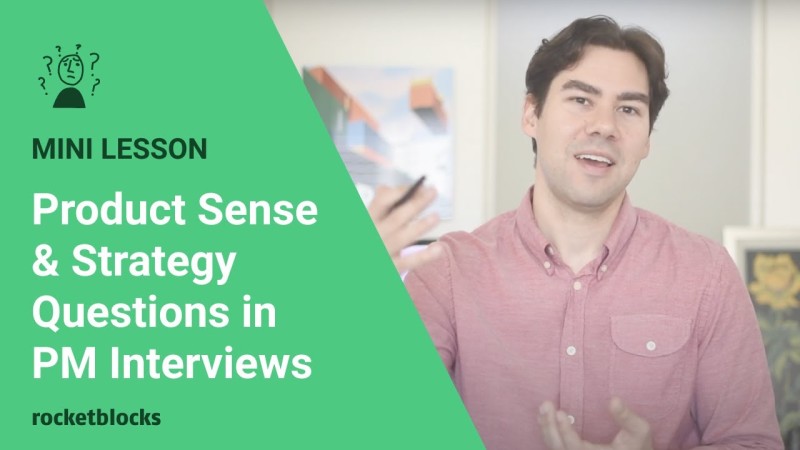
💬 Social Post of the Week
Teresa Torres via Twitter
Teresa Torres is an internationally acclaimed author, speaker, and coach. She teaches a structured and sustainable approach to continuous discovery that helps product teams infuse their daily product decisions with customer input.
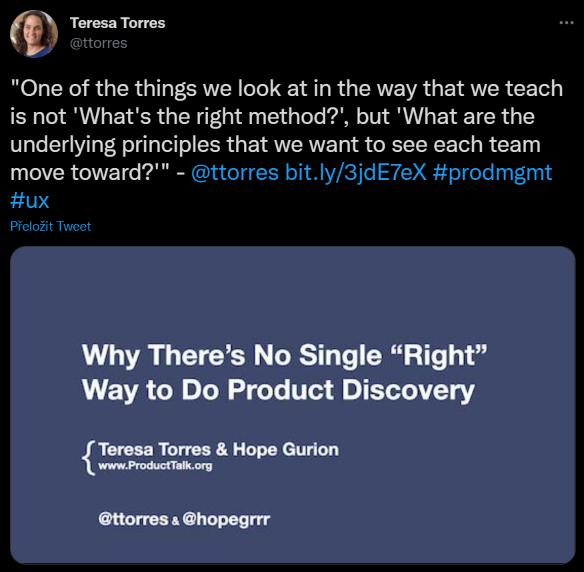
📘 Top product book
Measure What Matters: How Google, Bono, and the Gates Foundation Rock the World with OKRs is the must-read book for everyone who wants to learn how to use a simple goal-setting technique.
The author, legendary Venture Capitalist John Doerr reveals how the goal-setting system of Objectives and Key Results (OKRs) has helped tech giants from Intel to Google achieve explosive growth - and how it can help any organization thrive.
Feel free to get a free audio version here.
The Art of Killing Features ⚔️
In this week's edition, we look at the art of killing features. LinkedIn just killed their stories, and we get a bit deeper into the topic of how you could think about product strategy and retiring features in your product.
Watch the teaser interview with Bart Jaworski, Product Manager at Microsoft, and check the other articles around this topic.
⭐️ This week's top picks
[Read] Will Linkedin Stories Catch On?
Kushaan Shah, Growth Marketer at Livongo, shared an interesting article about an upcoming feature for LinkedIn a year ago. We know the rest of the story one year later, but check out Kushaan's take on the feature assessed based on the STEPPS framework.
[Read] What is Product Strategy?
About five years into her career as a PM, Rose Yao was told that she was not thinking strategically. Baffled with the feedback and wanting to improve, she began studying people who are good at strategy and understand how they made decisions. In this article, Rose covers the basics of product strategy, saving you a ton of research time.
[Read] Killing Features — Just As Important As Building Them
Grant Ammons, Director of Engineering at Convertkit and Pipeline CRM published an article about the art of killing features. You'll learn how to identify the right features to kill and when is the best time to do so.
[Video] Product Drive October 4-5th 2021: Teaser Interview with Bart Jaworski
Even companies like LinkedIn make product mistakes. On 30 September, LinkedIn killed its fairly new feature (launched in October 2020!) - LinkedIn stories. Userpilot team invited Senior Product Manager at Microsoft, Bart Jaworski, to discuss what makes product features successful and the thought process behind making them. Click here to watch it.

💬 Social Post of the Week
Bart Jaworski's Youtube channel explores classic product management topics with a fresh perspective. Feel free to check out the newest video on storytelling and why Product Managers need to be good storytellers.

📘 Top product book
Inspired: How to Create Tech Products Customers Love is considered as a bible of product management. A classic that should be on the bookshelf of every Product Manager.
Marty Cagan, Partner at Silicon Valley Product Group, gives a master class on how to structure and staff a vibrant and successful product organization, and how to discover and deliver technology products that your customers will love.
Learning and Growth for Product Managers 🎓 🚀
In this week's edition, we look at learning and growth for PMs.
This should be an evergreen topic for everyone who wants to move their career forward. Enjoy the reading and see you next week!
⭐️ This week's top picks
[Read] A Learning Framework for Growth
Parv Sondhi, Product Manager at Tech and Lecturer at Berkeley shared insightful tips for boosting your personal growth as a Product Manager. If you are struggling with growth, this article is the top pick for you.
Do you know what research exactly means? Have you ever tried to answer this question? In this article, Ernesto Peña rethinks the common part of the daily job of Product Managers.
[Read] How To Improve Your Communication Skills as a Product Manager
Communication is everything. Hilary Johnson, Product Lead / Growth Advisor @ustwo recommends her tips on how to effectively communicate across the teams.
[Video] How Curiosity Drives Careers | Bo Ren | TEDxUniversityofRochester
Bo talks about how being inquisitive helped her carve her unconventional career path, and sheds some light on diversity and inclusion issues in tech. Being curious helps her build things like the Facebook news feed, because asking questions and challenging assumptions is at the core of what Product Managers do. Click here to watch the video.

💬 Social post of the week
Here is a first in the series of articles from Pratibha Pandint about a career in product management. Follow her at "This Practical [Work] Life" for more information.
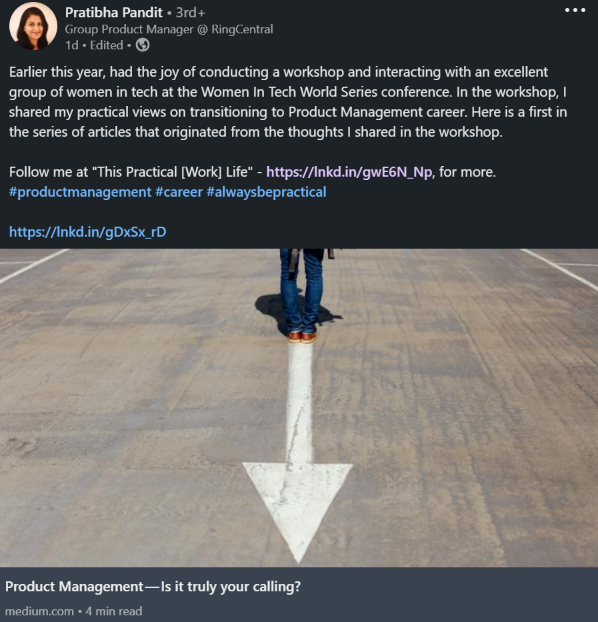
📘 Top product book
The Lean Product Playbook is a practical guide to building products that customers love. If you want to improve your skills or just be updated about evergreen good practices, feel free to get it here with Audible Trial.
This book helps improve your chances of building successful products through clear, step-by-step guidance and advice.
How Not to Be The Company That Also Built "Stories" ... and More
This week LinkedIn finally decided to say goodbye to stories, following Twitter by just a few weeks. It just never gets old to highlight the importance of discovery before building things.
This week we bring you discovery tactics, book reviews, and dealing with your favorite HiPPo, with lots of love.
⭐️ This week's top picks
[Read] Product Discovery – 13 Important PFRAQ Questions to Ask
Questions around what and why something should be built are the focus of discovery. At this stage it’s important to spend more time on the problem space than to the solution space. André Bento brings you 13 questions you can ask throughout the discovery process.
[Read] Discovery vs. Documentation
An absolute gem from Marty Cagan, looking at the dangers of old school product requirement documents in the era of a pandemic and remote work.
[Read] SUNDAY REWIND: Remember HiPPOs Are Humans Too…
Making decisions is hard when you have a HiPPo breathing over you - but remember, they're people too. Imogen Schels gives us great advise and shows us how to put those neede empathy skills to work when we're under pressure!
Effective Meetings: Process-Oriented Versus Mission-Oriented Meetings
When meeting with stakeholders and making decisions, it's important to make the most out of your time together. This is the fourth episode of the series on High Output Management by Andy Grove, you'll learn about the two different types of meetings, process-oriented and mission-oriented, how to use meetings to increase leverage, and how much time you spend in meetings.
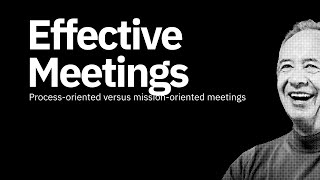
💬 Social post of the week
did it hurt? when u said you didn’t have time for research & created something no one wanted?
— Allison Grayce (@allisongrayce) August 31, 2021
📘 Top product book
It would make sense to recommend Teresa Torres' Continuous Discovery Habits, but as a bonus, I won't just recommend 1 or 2, but 10 great books on product discovery you should read.
Many thanks to Lena Haydt for putting this list together!
Product Parallels and Ketchup 🍅
This week we look at how product management has parallels to some of our favorite hobbies.
From movies to scuba-diving, we've put together some great articles for you (some of which may even give you some ideas for things to do this Summer!)
⭐️ This week's top picks
[Read] A Scuba Diver’s Guide to Product Management
Gabrielle Bufrem, Product Leader at VMWare, runs us through how getting her certification as a scuba diver helped her draw parallels to life as a Product Manager.
[Read] Lights, Camera, Product Management?
"What a director is for a movie, Product Manager is for a software” - this and many more correlations between product and directing by Siddarth Seth, Director of Product at FloBiz.
[Read] Why Every Product Manager Needs a Flux Capacitor
While we’re still waiting for hoverboards and self-drying jackets, we can still look at the Back to the Future trilogy and take away some lessons from Doc Brown's time machine.
[Video] What is Product Management Like in Gaming?
Product management in the gaming industry; what’s so different about it? Olivier Courtemanche walks us through the rise of social and mobile free-to-play gaming and the evolution of the product management role. At the crossroads of creativity and business, this key role has reshaped video game development and redefined corporate cultures by forcing entertainment companies to adapt to the millennium’s new platforms. Click here to watch it.
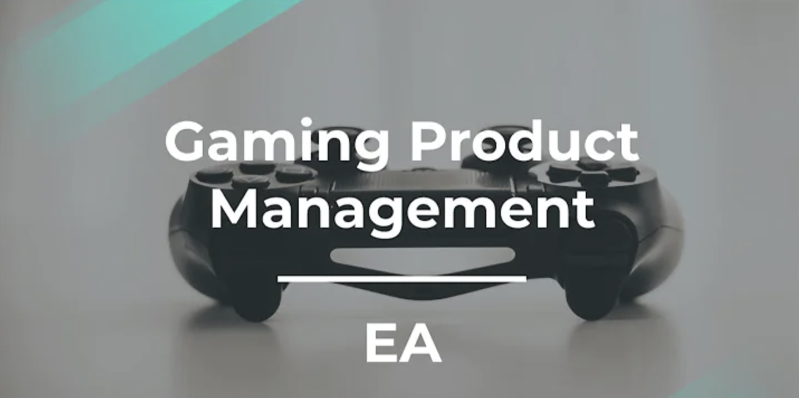
💬 Social post of the week
Benjy Stanton via Twitter
Speaking of real-world applications, we really need to have a chat with Heinz about product management and ketchup because it feels like there could've been a better solution to this problem.
I’ve found the ultimate UX vs UI visual metaphor! pic.twitter.com/AD7oiE6BVk
— Benjy Stanton (@benjystanton) August 17, 2021
📘 Top product book
If we're talking about product management in the real world, we should read a book about product management in the real world.
Product Management in Practice: A Real-World Guide to the Key Connective Role of the 21st Century comes highly recommended.
In this book, author Matt LeMay focuses on the CORE connective skills-- communication, organization, research, execution--that can build a successful product management practice across industries, organizations, teams, and toolsets.
Product Growth and Mario Brothers 🍄
This week we look at product-led growth and onboarding.
There's *a lot* of great resources out there, but let's start with the basics. From working together to defining your ideal customer, let's work on defining a strategy first!
⭐️ This week's top picks
[Read] Product Led Growth: A Guide
Caroline Clark, CEO of Arcade, guides us through how product, sales, and marketing can work together in a product-led growth environment and delivery the right strategies to be successful.
Do you know what product growth actually means? Are we referring to financial growth, team growth, or feature adoption? This and other questions were answered by Conor Dewey from the Hugo team.
[Read] A Guide to High-Touch B2B SaaS Onboarding
Research from 100+ companies - lessons learned and best practices from the Arrow team. Fascinating read!
[Video] Growth Hacking Strategy for SaaS Startups (How to Acquire 100K Users)
So you've got a SaaS startup with some revenues and now you want to get to 100K users, but you don't have a ton of extra funding to go all-in on ads and other expensive marketing tactics. So what do you do? TK Kader tells us exactly what to do next.
💬 Social post of the week
/u/Eye_Juice via Reddit
I want you all to know I tried really hard to find a growth meme, and the best I could do was this.
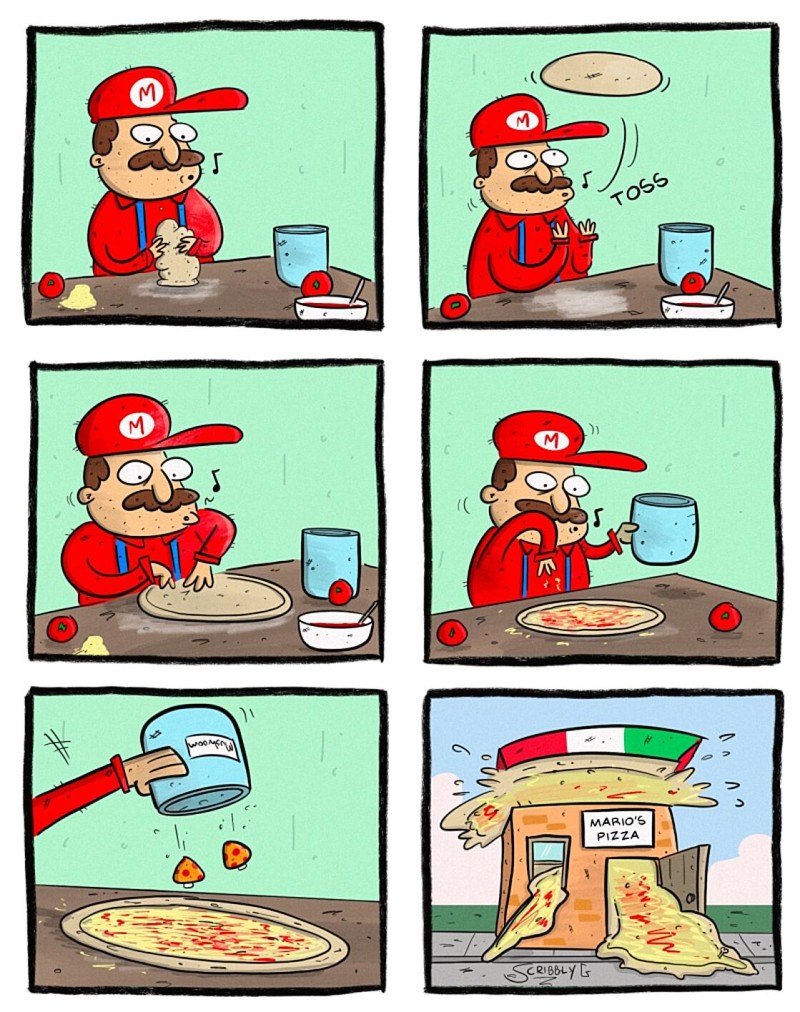
📘 Top product book
We couldn't have an edition on product-led growth without THE product-led growth book by Wes Bush, Product-Led Growth: How to Build a Product That Sells Itself.
Wes challenges the traditional SaaS marketing and sales playbook and introduces a completely new way to sell products. Bush reveals how your product—not expensive sales teams—can be the main vehicle to acquire, convert, and retain customers.
Mental Models and Critical Thinking 💡
This week we focus on mental models.
Mental models help us understand life. They guide our perception and behaviour and help us make decisions and solve problems. Understanding how one implements these behaviours is imperative not just for our product design, but for us as product people.
We've rounded up the best reads and talks about mental models, alongside a great book around forming habits. Enjoy!
⭐️ This week's top picks
[Read] Mental Models That Make You a Better Product Manager
Going by that definition, the life of a Product Manager is always caught up between discovering, planning and execution. It's a challenging job with lots of context switching - so how do you have time to really think about how you're doing things? Saurabh Rastogi walks us through the importance of mental models and how applying different ones can help you become a better Product Manager.
[Read] 10 Visual Models That Let You Simplify The Most Complex Ideas
A picture speaks a thousand words better than a single sentence does. In an age filled with back-to-back virtual meetings, here's how to communicate quickly and effectively with visual models.
[Read] 5 Mental Models That Help Product Managers Acquire and Retain Users
To become a learning machine, you can’t just overload yourself with information. You have to apply critical thinking to what you’ve learned. In this article, Hiten Shah talks us through 5 mental models that help Product Managers acquire and retain users (a must-read!)
[Video] Nils Davis - Mental Models (ProductTank SF)
Different situations call for different mental models. If all we have is a hammer, then everything looks like a nail, and that's obviously a bad situation to be in. There are dozens, if not hundreds, of mental models that can help you in different situations. In this talk, Nils Davis focuses on a handful he finds the most useful as a Product Manager.
💬 Social post of the week
Emilia Korczynska via Facebook
Speaking of mental models... who's been here, and how do we even begin to digest this mess 😅.
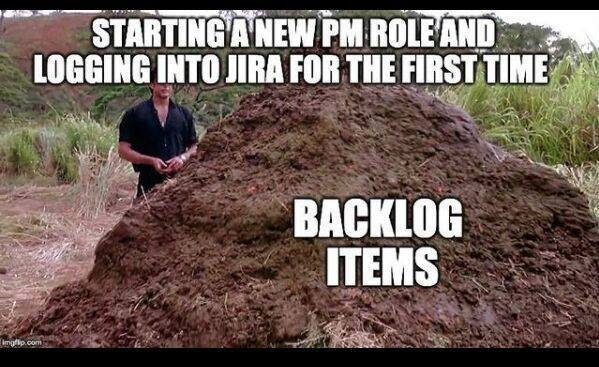
📘 Top product book
If you're having trouble changing your habits, the problem isn't you. The problem is your system. Bad habits repeat themselves again and again not because you don't want to change, but because you have the wrong system for change. You do not rise to the level of your goals. In "Atomic Habits", author James Clear guides us through how to break bad habits and start improving how you make decisions.☀️
Collaboration, Teamwork, and Putting Out Fires 🔥
This week we focus on collaboration and teamwork.
The most successful teams are those that think of themselves as a whole team - not as separate teams in an organization. How do you make that happen? How do you get everyone working together and not against each other?
From solving problems as a group to putting out fires, here's how to do it with a slice of pizza in hand 🍕
⭐️ This week's top picks
[Read] Core Concept: Collaborative Decision-Making in a Product Trio
Do product trios really work? What do they do when they can’t agree? Who really gets to make the decisions? Product Leader Teresa Torres guides us through the product trio concept and how to make collaborative decisions in this blog post.
[Read] Why Groups Struggle to Solve Problems Together
There are five stages of problem-solving: defining the problem, generating solutions, evaluating solutions, picking a solution, and making a plan. When we solve problems independently, we intuitively move in between these stages to generate solutions quickly. But when solving as a group, people move through these differently. Al Pittampalli guides us through how to solve problems as a team.
[Read] 3 Signs Your Team Doesn’t Have an Ownership Mindset and What to Do About It
To cultivate an ownership mindset on your team, you should focus on transparency, autonomy, and customer empathy. A few tips from the Atlassian team to improve your team skills here!
Chris White leads the University of Michigan’s Center for Positive Organizations. Through ground-breaking research, educational programs, and organizational partnerships, the center helps leaders build high-performing organizations that bring out the best in people. This is a must-watch for improve team-wide communication and collaboration. Watch it here.

💬 Tweet of the week
Ok, so this week, we don't actually have a Tweet, but a meme shared on Linkedin that's so funny it crosses language barriers. Who knew you could be funny on Linkedin too?

📘 Top product book
We couldn't pick just one book this week - after all, Summer is here!
Instead, we bring you a collection of books with a specific progression as marked by Nils Janse.
This curated list guides you through the top product management books, from Marty Cagan's Inspired to C.Todd Lombardo and Bruce McCarthy's Roadmaps Relaunched.
Happy Summer! ☀️
Lessons Learned and Grilled Cheese 🧀
This week we focus on lessons learned and experienced gained.
Product is hard, we all know this. But from the tough experiences come lessons learned, some funny, some not so funny - but all truly valuable.
From grilled cheese to jewelry manufacturing, we've got it all for you on this roundup!
⭐️ This week's top picks
[Read] A Masterclass in Product Management - Selling Grilled Cheese
In an endearing and funny roundup of lessons learned, Wil Kirwan's compelling storytelling guides us through how selling grilled cheese taught him about product management. 🥪
[Read] How Writing Made Me A Better Product Owner
One of the most important skills product people must have is the ability to communicate clearly. If you have a great idea but you can't convey it to others, how do can make it happen? Maarten Dalmijn guides us through how constantly writing helped him be a better product owner. If you're wanting to brush up on some writing skills, this is the blog post you've been looking for.
[Read] Your First Thought Is Rarely Your Best Thought: Lessons on Thinking
Have you ever thought about scheduling time to think, not just to work? In this short article, Shane Parrish shares lessons learned after setting time to think, and how it has improved his problem-solving skills.
[Video] 5 Lessons Learned in Product Management by Twitch Sr. Product Manager
In this Product School session, Greg Smith, Senior Product Manager at Twitch, shares his own unique journey to product management spanning time in the film industry, an Apple Store, an international jewelry manufacturer, a wine bar, and playing video games. He discusses the various lessons he learned along the way and how he applies them to product management at Twitch. You can watch it here.
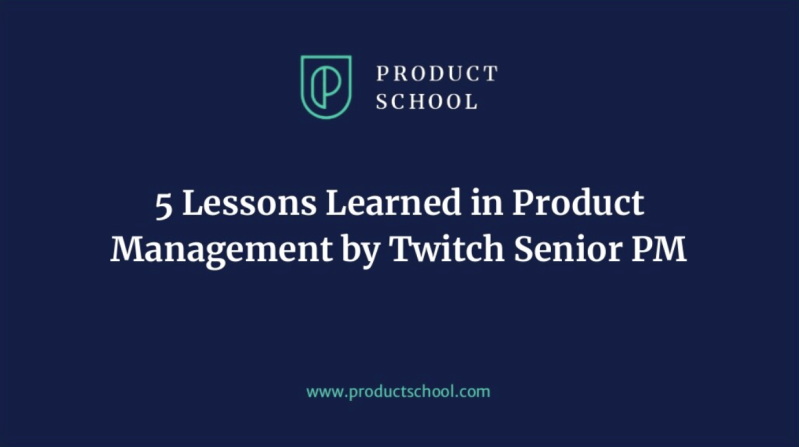
💬 Tweet of the week
keith kurson via Twitter
RIP fleets, we hardly knew (or used) you https://t.co/wMmfl2rNu4
— keith kurson (@keithkurson) July 14, 2021
📘 Top product book
Our top pick for book of the week is Computing Calamities: Lessons Learned From Products, Projects, and Companies that Failed by Robert L. Glass.
The author presents 30 of the worst computer-industry failures of all time - and shows how you can prevent disaster from happening to you. This book is organized into six short sections, each featuring a collection of articles relating to a particular type of computer-industry disaster.
Goals, Metrics, and Product Thinking
This week we focus on goals, metrics, and product thinking.
Building great products is about learning and iterating - but in order to learn, you need to measure the right things to make informed decisions. But where does one even begin?
From OKRs to building kitchens with the right outcomes in mind, we've got some great reads for you this week!
⭐️ This week's top picks
[Read] How to Measure The Progress of OKRs Using Leading and Lagging Indicators
The most useful goals help teams measure their progress continuously and adjust their actions accordingly. But neither of these will solely be achieved by being religious about "good" and "bad" OKRs. Check out this practical guide to setting up your OKRs by product coach Tim Herbig.
[Read] The Mindset That Kills Product Thinking
Jeff Patton talks us through how to recognize potential anti-patterns that kill creativity and hinder product thinking, with everyday, real-world examples like remodeling a kitchen.
[Read] How Engagement Metrics Can be Misleading
In most situations, tracking engagement metrics will be helpful. But in some cases, they can also be misleading. Oleg Yakubenkov guides us through how to recognize potentially misleading metrics and what you can do about them.
[Video] Why The Secret to Success Is Setting The Right Goals
In this practical talk, John Doerr shows us how we can get back on track with "Objectives and Key Results," or OKRs -- a goal-setting system that's been employed by the likes of Google, Intel, and Bono to set, and execute on audacious goals. Learn more about how setting the right goals can mean the difference between success and failure -- and how we can use OKRs to hold our leaders and ourselves accountable.
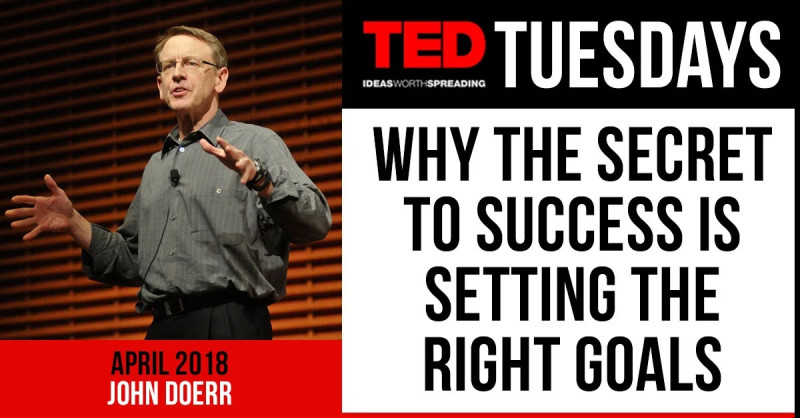
💬 Tweet of the week
Gtmhub | For Missions that Matter via Twitter
We're just going to leave this here 👀🤫 pic.twitter.com/eaErRyUgtR
— Gtmhub | For Missions that Matter (@gtmhub) June 18, 2021
📘 Top product book
Our top pick for book of the week is Radical Focus: Achieving Your Most Important Goals with Objectives and Key Results by Christina Wodtke.
How do you inspire a diverse team to work together, going all out in pursuit of a single, challenging goal? How do you get your team to commit to bold goals? How do you stay motivated despite setbacks and disappointments? And what do you do when it looks like you’re headed for failure? In Radical Focus, Christina Wodtke combines her hard-earned experience as an executive at Zynga, Linkedin, and many of Silicon Valley’s hottest companies to answer those questions. It’s not about to-do lists and accountability charts. It’s about creating a framework for regular check-ins, key results, and most of all, the beauty of a good fail – and how to take a temporary disaster and turn it into a future success.
Cats, Empathy, and Accessibility in Products 🐈
This week we focus on psychological safety - yours, theirs, ours. The most important skill a product manager and leader can have is the ability to empathize with others, but developing that skill starts with taking care of ourselves first.
Empathy leads to designing great products - so let's start the conversation. Can one really build products that are inclusive if we aren't providing the same level of inclusion, accessibility, and safety to our teams?
If you don't know where to start, we've put together a great collection for you below.
⭐️ This week's top picks
Did you know that all high-performing individuals - from executives to athletes - all have a coach? Yet over 60% of people who are on the edges of leading-edge innovators are actually embarrassed to ask for help. Kate Leto and Barry O'Reilly guide us through how to break through the taboo of asking for help so you can take your career to the next level.
[Read] How One Company Got Employees to Speak Up and Ask for Help
A case study of how a quickly growing startup puts emphasis on their employees' psychological safety to drive innovation. As a leader, if you want to create an environment where it’s okay to ask for help, how can you show that even you need help from time to time?
[Read] Inclusive UX in an era of Anxiety
Considering the skyrocketing rates of mental illness throughout the course of the COVID-19 pandemic — plus many more of us struggling with daily stressors and mood swings that may lead us to irrational negative thinking, how can you design with empathy and accessibility in mind?
[VIDEO] POURing Over Your Website: An Introduction to Digital Accessibility
Digital accessibility - what it is and why it's important. Most sites/apps are awful as far as accessibility goes. It's not something that's taught, and even when there is some awareness, it's considered too hard and costly to implement. In this TEDx talk, Ashleigh Lodge raises visibility about why it's important from both social & business perspectives and provides information and tools for people to take back to their own project use.
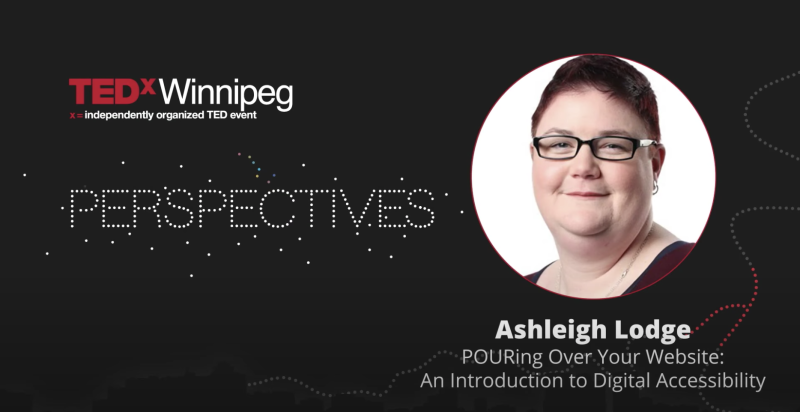
💬 Tweet of the week
NHS D&G Patient Safety & Improvement Team via Twitter
#WellbeingWednesday
— NHS D&G Patient Safety & Improvement Team (@DG_Improvers) June 30, 2021
Checking in with your teams is crucial to helping forge #PsychologicalSafety
Why not use one of these easy to understand graphics to assist and also add a bit of light relief.#DGImprovers #DGQINetwork #NHSDG #StaffWellbeing #Wellbeing pic.twitter.com/u5lj0OH0a7
Strategy and Peanut Butter Sandwiches
This week we bring you some awesome reads around the importance of strategic product research, and why context always matters. From talking to customers to the most ridiculous user experience with peanut butter sandwiches - remember to always focus on what the user wants to achieve.
We wrap up our digest with how Notion took their growth to the next level by tapping into their existing user base and growing their community by 200 members daily (yeah, you read that right!)
Enjoy!
⭐️ This week's top picks
[Read] When's the last time you talked to your customer?
Product leader Adam Thomas tells us about the importance of speaking to your customers, developing relationships, and taking your strategic research to the next level.
[Read] Why you should stop putting features on a roadmap
Make sure your discovery process is problem-focused and not feature-focused by asking questions on the problem the user is having, not the solution you are building.
[Read] The making of a strategic designer
A beautiful design is not the same as a useful design. Read all about the new emerging role that's taking the product world by storm.
[Read] How to write better user stories with gherkins
User stories have been getting a really bad rep lately - spice them up with gherkins (no, not the pickle!) and help your team focus on user outcomes.
[Video] Why user stories with context matter
This hilarious video circulating Reddit hits the spot on user experience, and why user stories focused on outcomes are important. Watch it here.

💬 Tweet of the week
Ryan Kaufman via Twitter
If you’re a SaaS founder, you need to study Notion
— Ryan Kaufman📈 (@growth_student) June 25, 2021
The growth strategies used become a $2B startup and reach 1M users after a single seed round
A thread👇
📘 Top product book
Our top pick for book of the week is Radical Focus: Achieving Your Most Important Goals with Objectives and Key Results by Christina Wodtke.
How do you inspire a diverse team to work together, going all out in pursuit of a single, challenging goal? How do you get your team to commit to bold goals? How do you stay motivated despite setbacks and disappointments? And what do you do when it looks like you’re headed for failure? In Radical Focus, Christina Wodtke combines her hard-earned experience as an executive at Zynga, Linkedin and many of Silicon Valley’s hottest companies to answer those questions. It’s not about to-do lists and accountability charts. It’s about creating a framework for regular check-ins, key results, and most of all, the beauty of a good fail – and how to take a temporary disaster and turn it into a future success.
How to Manage Technical Debt
Technical debt is one of the great sources of frustration among product teams and is mostly mismanaged.
Engineering teams hate bringing it up, and sweeping it under the rug leads to accumulation and long-term frustration.
The culprit is the wrong notion of what tech debt is, its strategic role, and not knowing how to prioritize it.
Newsflash: Products don't win by having little or no technical debt. Keep reading to understand how to manage it strategically.
Managing technical debt
Why scrum prevents and creates technical debt
Choosing your north star metric(s) and how to create a product strategy
🗂 Managing technical debt
Matt Greenberg & Keya Patel via Reforge
You could think of technical debt as parts of your code that will slow you down in the long run. These could be hard-to-read, low-quality code, shortcuts, tangled dependencies, and temporary hacks that later become long-term pains.
Demystifying technical debt
Typically four main notions undermine the management of tech debt.
Technical debt is bad or burdensome
1) There are different types of tech debt, and their difficulty varies greatly. We cannot classify it all as bad, as this makes it all look the same. We need to organize it by type and estimate the degree of pain/risk.
2) It's good to have a certain level of tech debt. This suggests that the team isn't focusing on removing it but focusing its efforts on key business areas like development or experimentation. Prioritizing technical debt over business is an indicator of growth problems. Your team will accumulate a bit of technical debt.
Ask: What can we gain by accumulating tech debt now and tackling it in the upcoming month?
All technical debt is complex work
Many teams have an unaligned definition of done. When it comes to tech debt, you need to have a definition of done, or all tech debt will become complex work.
Defined
If your work has a clear start and end, the path to the end might be easy or hard, but there is a definition of what it means to complete it and how to get there.
If you always define your tech debt, you can begin to understand how many days it would take to complete the work and account for it in upcoming sprints.
Undefined
If your definition of done is unclear, it'll be harder to manage expectations right off the bat.
If possible, move to a more defined approach by frontloading some of the work by scoping potential high-level solutions and considering how and when to make the fix.
You can make it less complex by breaking it into small parts of complicated but feasible work and tackle said pieces over a defined period or sprints.
Ask: What assumptions are we making that could be challenged? How would I break this tech debt for someone who doesn't understand the complexities?
Tech debt is excluded from product work estimates
Product teams tie their work to business goals, metrics, or OKRs, but this is rarely the case with tech debt. This lack of clarity and separation from product work makes it hard to address it. But tackling it at the right time can be critical to the business growth and user experience.
Even if some tech debt doesn't directly impact metrics, look to understand how it might impact user experiences in the long run.
Set a time to validate that there's a common understanding between tech and business leads. This will enable the teams to find spots between experiments and builds to address tech debt and incorporate them into the upcoming sprints.
Individual pain is the same as organizational pain
Engineering or dev teams will often put forward pieces of tech debt that they find painful to deal with. They could struggle around QA, and their pain points might seem critical to them without considering the overall strategic context.
Whenever a high-priority area of tech debt is raised, consider whether this is an individual or organizational level pain point. Will it impact the customer or business in some way in the short or long run?
Questions to begin prioritizing technical debt
Confidence - How high is the probability that this technical debt will cause a significant problem?
Time - How urgent is this problem? When will it become a problem?
Impact to User - How high is the impact of not tackling this piece of tech debt for the end-user? Will it result in a speed or quality issue that will hurt the user experience?
Sequence - Will this piece of tech debt block the team from reaching important milestones? If not, to what extent will it prevent the team from reaching said milestones?
Accumulated debt - How much technical debt has already been accumulated? Is it minimal or significant?
You can begin to pair up these questions with the type of technical debt, whether it's acute or systemic debt, and the stage of your company's growth to work out how to tackle it strategically. Here's how to put the full framework together.
⭐️ This week's top picks
[Read] Why Scrum prevents and causes technical debt
As a follow-up to the management of technical debt above, we wanted to include a different lens. How teams work with technical debt on a daily basis and how to tackle each anti-pattern.
[Read & copy] Top 5 Notion templates for product managers
Most product teams use Notion for one reason or another. It's a great productivity tool and place to keep your daily work-life organized. From meeting notes to user research, wikis, and sprint retros, these are some templates you'll want to add to your workspace.
[Read] Choosing your north star metric
Here's a guide to help you choose your north star metric(s), based on a survey of current and past employees at over 40 of today’s most successful growth-stage companies. Whether it's revenue, growth, engagement growth (MAU, DAU), this guide could help you nail your north star metric.
[Listen] How to create a product strategy
Nacho details his experience as a CPO creating a product strategy, as well as the situations you'll be facing, the relationship with the overall business strategy, setting goals, time frames, and how the process differs between established products and products that are yet to be launched.
💬 Tweet of the week
Julie Zhuo via Twitter
Everyone has an opinion on design.
— Julie Zhuo (@joulee) June 24, 2021
There's always an immediate gut reaction: "Ooh, I love this!" or "Meh."
But how do you go beyond that to honing your skills of giving helpful, actionable feedback?
Here are the 7 questions I run through when critiquing a product's design 👇
A Framework to Solve the Right Problems
What should you work on next, and how should you allocate resources?
You probably have RICE, WSFJ, or several frameworks in mind. These are great if you've already done discovery and you know you're working on the right problems.
So let's rewind - How do you know you're working on the right problems? And how do you align your team on the value and efforts they entail?
A shared understanding of your users' problem and how each problem relates to your product strategy is a good place to start.
Here's what we've got in store this week:
Tackling the problem: A simple framework to align your team’s efforts
How to break through the ceiling of product-led growth
How people discover products and how stripe builds them
Managing the right problems and efforts
Teams often misallocate efforts, focus, and resources on the wrong problems. The Intercom team has a way to focus on the correct problems while allocating the right amount of resources - providing a way to the right solutions with a simple framework.
A framework to focus efforts on the right problems
Not all problems and solutions are created equal. Therefore depending on the factors below and their rank from "low," "medium," "high," you'll be able to derive how much effort to invest and transition to exploring the right solutions.
Innovation: Before starting any project, you should categorize and rank how it will factor into your product strategy, business strategy, and execution levels. You'll ask:
At a product strategy level - does the project require an innovative solution? What level of innovation?
At an execution level - Will it contribute directly to differentiation or simply closing product gaps?
If the problem is tied to differentiation, innovation will be ranked as "high" and could evaluate high-level directions for solutions. On the other hand, if the project closes product gaps, innovation will be "low," and you'll want to consider existing or repurposed solutions instead of thinking of new approaches.
Investment: Should we spend a lot of time, resources and bring in external teams? Or do we want to solve it quickly without investing significant resources? This is a practical criterion, and its importance relative to other projects should be considered.
A few questions to ask before ranking:
Can our team solve this on our own? No? Then investment will be higher.
How will we prioritize it against other problems?
Would you intend to spend more time solving this problem than others?
Urgency: How time-sensitive is it? Do we need to get it to the market as soon as possible, or can we spend a lot of time on it? Urgency can be determined by top-down problems like product launches, or they could come from a bottom-up perspective such as the problem impacting users significantly. This can be observed from NPS scores, feedback, churn patterns, and blocked sales.
Questions to ask before ranking:
Is it crucial to the product strategy? Is it strategically important to solve this problem right now?
How critical is it to a broader launch? Is the other launch dependent on it?
Is this problem one that majorly impacts how customers use our product? Is it affecting a great pool of customers, or can is it a minor problem for them?
Urgency indicates how fast we should get the solution to our customers, and every project could appear to be of major urgency, but this is not always the case. Perhaps a project is of strategic importance, but there's a current solution that keeps customers satisfied.
There are many different cases and situations where the different factors will rule how you approach your problems and prioritize projects. If urgency is high and innovation low, speed is the important factor, for example
Discover how the factors work together and the different examples in this case study.
⭐️ This week's top picks
[Read] How to break through the ceiling in product-led growth
Product-led growth is often praised, but people rarely talk about the limitations and how to deal with them. This is a guide to understanding its limitations and building a complete GTM strategy, to leverage its full potential. It offers a playbook to build product-led growth into an integrated buying system.
[Read] How people discover new products
An easy read to understand the seven main channels through which people find and ultimately adopt products, with examples, suggestions, and advice as to which channel is right for each product.
[Read] Building products at Stripe
Stripe has been incredibly successful at capturing market share, and you might even be using it yourself. But how does an emerging market leader build products? Here's an inside look into Stripe's product culture, how new products are shaped, and the role of design.
💬 Tweet of the week
Julie Zhuo via Twitter
The Five Most Common Product Designer Mistakes, a thread 👇
— Julie Zhuo (@joulee) June 9, 2021
#1/5: Reinventing the Wheel
When “Let's be innovative!” wins at the expense of “Let's do things effectively and quickly!”
Examples:
Facebook going hamburger menu before tabs
Horizontally scrolling web pages
How to Scale Product Alignment - Miro's Approach
How do you build a product that users love? And how do you scale it?
Alignment. The common denominator among great product teams that experience and maintain hypergrowth.
It holds your product strategy stack together and the earlier you adopt it, the more robust your decision-making process will become, as well as adding an agility layer.
Here's what we've got in store this week:
How Miro scales product alignment
Why customer onboarding is a vital part of your growth strategy
How to write OKRs that don't suck
Rituals of hypergrowth
🗂 How Miro scales product alignment
Via Farbod Saraf (Product lead at Miro)
We all know Miro and how it grew from 3M to 15M users in less than a year. One of its product leaders recently shared how they scale their product strategy, find alignment, frame problems, and even run meetings in this tell-all document.
Why does it matter?
Every company and product team deals with collaboration and alignment issues at some point, especially while experiencing growth. The product alignment approach guides opportunity and solution discovery and ensures widespread product collaboration and knowledge.
The product alignment document
Miro uses this single document to detail the results of product discovery and its impact, with three pillars associated with the stages of the document.
Opportunity/problem framing: Where it all starts. They identify a problem to solve or a new opportunity to seize. Then, the team investigates the problem to be solved, the audience, its importance and the why, success metrics, and competitive research (how are others solving this problem?). Here's where a few possible high-level directions start to be explored. Caution: It's important to stay broad to avoid going into implementation details to stay open to more solutions.
Solution framing: The team chooses a direction and starts working on solution discovery. Scope, key features, and stories, complexity are identified, designers provide key flows, a go-to-market plan is prepared, and engineering design docs are crafted. Their PMs facilitate the flow of collaboration and outline possible risks and dependencies.
Post-launch recap: After launch and implementation, the team assesses how successful they were in achieving the goals according to the success metrics set and the learnings to continue improving.
The meetings
They stress the importance of having the most relevant audience reviewing the document during their weekly meetings to challenge it and provide feedback. Each session focuses either on problem framing, solution framing, or post-launch. They validate opportunities against user needs and business feasibility, get feedback from leadership, and add relevant-only outside perspectives. The only four possible outcomes range from a complete agreement to not approved and points that need work.
Discover how to approach each of the pillars, the questions to be asked, how to structure the meetings, and the actual document for you to copy, right here.
⭐️ This week's top picks
[Watch] Why customer onboarding is crucial for your growth strategy
The first thing that comes to mind when we think about growth problems is getting leads to try it out. But a more important problem is when they actually get to the product, and they leave. Onboarding is one of the biggest weaknesses of most companies, and Casey is here to present ways to successfully tackle it.
[Read] Uber's crazy YOLO app rewrite, from the front seat
A truly riveting story that will have you on the edge of your seat. George gives an insider look at what it was like to re-write the whole Uber app in two months. He narrates how these two months of hell ended in success at the cost of numerous burnouts and team members quitting.
[Read] How to write OKRs that don’t suck
Many teams fall into the trap of cookie-cutter OKRs that they follow and lose track of the inputs that actually matter. OKRs are a tool for strategy deployment. They must be relatable and understandable, and give the organization the information and tools to steer towards the desired outcomes. If this isn’t the case, then you should make adjustments.
💬 Tweet of the week
Everyone has an opinion on design.
— Julie Zhuo (@joulee) June 24, 2021
There's always an immediate gut reaction: "Ooh, I love this!" or "Meh."
But how do you go beyond that to honing your skills of giving helpful, actionable feedback?
Here are the 7 questions I run through when critiquing a product's design 👇
Forget About Your Idea Backlog
If you were a doctor, you wouldn't prescribe medicine to your patients without understanding their problems first.
The same should apply to product discovery.
Product teams gather long lists of ideas to tackle all sorts of problems, and these idea backlogs give a sense of what to work on next.
It's comforting, and it gives us a sense of direction, but at the end of the day, they only offer prescribed solutions that aren't connected to problems worth solving.
Keep reading to learn about the correct approach to product discovery.
Kill your idea backlog
How to create a product adoption strategy
50 questions product managers forget to ask
🗂 Kill the idea backlog
Via Tim Herbig
The concept of the idea backlog is inherently flawed, and it's time to drop it.
It's where we collect "great" ideas that never made it to the top of the ideation session, and they slowly become outdated or disconnected from problems worth solving, creating noise. But more importantly, they focus the conversation of what to tackle next, on solutions.
Idea backlogs discourage hard conversations
Management wants to add an idea to work on, so you agree to add it to the idea backlog instead of discussing it. It saves you the hard conversation then, but it'll work its way into prioritization or roadmapping discussions at some point.
So what should you do instead?
If you're currently maintaining an idea backlog, round up the team and inspect each idea, asking why we would want to pursue it.
Tim gives the example of an idea for a Reporting PDF Export.
Why would you do this? So account managers can share results with clients faster.
Why would we want to do this? So account managers consider us an excellent solution for working with their clients.
Why would we want to do this? So we can increase revenue from agency markets that purchase our solution.
Continue until you get something measurable, and if you can't, you should avoid it.
The reasons listed above will be your rationale for your next prioritization or roadmapping meeting, and it will start the conversation of what to work on next with a goal instead of the solution.
The steps that will follow:
Start broadly thinking of new solutions that could help you achieve the goal, now that you know it's worth solving, and there's data to back it up.
If you can't support the goal with evidence, it shouldn't be prioritized.
Dive into the problem space with the mission briefing
Your boss or a stakeholder will come to you with specific features they want. Your job is to determine if these requests will actually fulfill the expectations of your users or if you'll end up justifying them with vanity metrics.
How will you do this?
Create collaborative alignment by using the mission briefing framework, which clarifies the pillars of your product discovery mission without going into feature details. The five levels are:
The Context
Strategic Fit of a Problem Space
The intent of the Product Team
Areas of Uncertainty
Boundaries to consider
To avoid group-think, get your team to individually outline each one of them to co-create the mission briefing and understand how to proceed. Here's an example.
Remember why you started
We run discovery to answer whether the problems we propose are worth solving, and if so, will the solutions be worth pursuing, not the other way round.
This is a concept designed to deliver value consistently, and if you'd like to understand it and how to deal with new feature ideas, and those "great" ideas proposed by stakeholders, you can read the full case study here.
⭐️ This week's top picks
[Read] Why the Spotify squads framework doesn't work for product teams
Explore the Spotify Squad framework was emulated by many teams but few were able to succeed at it. It's important to understand why and how Spotify incorporated it, the product development methods it helped with, but most importantly, why they abandoned it.
[Watch] Expert Q&A: How to create a product adoption strategy
Product-led highlights the importance of allowing your product to sell itself, and lots of great outputs to achieve that, from messaging to great onboarding, but how do you decide where to put your focus first? This is where your product adoption strategy kicks in - understanding how to best prioritize that strategy as a team.
[Read] 50 questions that product managers forget to ask
Product managers love to solve problems and get things done. This is great because it means pushing products forward, and solve complexities. The downside to this is that we often forget to ask some questions that are essential to remember but painfully easy to forget.
💬 Tweet of the week
The job description for a Product Manager, based on reviewing PM career ladders at 20+ companies 🧵 pic.twitter.com/b7e3Udclv5
— Lenny Rachitsky (@lennysan) May 27, 2021
How to Own Your Product Backlog and Deliver Value
Repeat after me: I own the backlog; the backlog does not own me.
Your backlog management is a reflection of how agile you are. Therefore, it should constantly be adapting to learnings to maximize value.
Experienced PMs and POs know how to sidestep the pitfalls and tackle the numerous scenarios where they could get buried to the neck with items.
Keep reading to learn more about keeping your backlog in check and outcome-based delivery:
How to truly own your product backlog
Deliver value with the Kano model
Aligning your company around jobs-to-be-done and how to break into the mainstream market
🗂 How to own your product backlog
David Pereira via Serious Scrum
Your backlog items are an ordered list of what's needed to improve your product, and it should be in a constant state of change. If it grows too big, the chances are that it'll become stale.
When to kill items
If you ask stakeholders, they'll tell you that all their solutions are relevant, no matter how old. Outcome-driven teams and agile development are about learning and adapting to discoveries.
Here are a few situations when items become irrelevant:
Discoveries show that the item won't solve the problem it tried to solve.
It's no longer relevant due to a change in the direction of the product.
Another resolved issue partly or fully fixed it.
We will work on a solution that will solve the same problem in the future.
Your product's architecture shifts, and therefore the problem your solution is trying to solve becomes irrelevant.
The ancient backlog
Are you hoarding backlog items? A 200-item list can be a common occurrence among new POs inheriting backlogs, where some of the items are over a year old.
Time might have already been invested in them, but they only add noise. A three-month lifespan is a good rule of thumb. Ask yourself:
How long is your backlog?
How long are you keeping your items?
When did you last delete an item?
The dumpster
Can you connect your backlog items to the goals you want to achieve? A feature wishlist where you dump all your stakeholder requests only clouds your vision and ability to focus on outcomes. Challenge items by asking:
What problem is this item trying to solve?
How does it help us to reach our product goals?
Is it relevant to the release?
The recipe book
When you constantly update your backlog items to have all the details, so the developers focus only on implementation, it can become a recipe for subpar outcomes. It becomes a bottleneck for the PO because they have to keep up with the details, and it focuses on delivering features instead of value. Ask yourself:
Are your backlog items too detailed?
Are your items problem-oriented? If not, reconsider.
How much time is item creation consuming?
Deliver value with the Kano model
Mathieu Dhondt via The full guide to the Kano
If you'd like to go a step further and consider a list of solutions to work on for your next release and figure out what mix is the best in terms of user value, using Kano will help you deliver more efficiently.
Kano allows you to work out the right combination of:
Minimum basic features that must be included.
Performance features to start working or investing in.
Which delight features will impress users the most.
To identify how satisfied or even delighted users will be with a product, we must consider the two dimensions (or plotted axes), satisfaction versus functionality. How will users react to the level of functionality of our features? How well have we implemented it, or how much of a particular feature will they get?
We've explained the Kano model before, and though it's among the best frameworks, there is a lot to understand about putting it into practice. That's why a great place to get examples and keep up with its best practices is the full guide to the Kano model.
⭐️ This week's top picks
[Read & copy] Crossing the chasm with the ‘target customer scenario’ canvas
This is a very helpful tool for product managers to segment markets when defining the product strategy and go-to-market strategy. The canvas forces us to incorporate customer-centric frameworks and see our product from the customer perspective and whether our product could potentially scale by becoming the owner of our niche.
An enlightening talk by Marty Cagan about the challenges and misconceptions product people face and how to face them. Grab some popcorn because this is a deep dive into the applications of lean and agile and topics like validating ideas vs. discovering solutions, risk management, planning vs. prototyping. Bookmark it!
[Listen] Aligning your company around JTBD
Bob Moesta is known for building the jobs-to-be-done framework. In this episode, he breaks down how JTBD comes from the idea that we hire products to help make progress, why context is so important, and how pricing comes down to positioning which is informed by the customer's job to be done.
💬 Tweet of the week
Julie Zhuo via Twitter
Imagine you're using a product and something bothers you about it.
— Julie Zhuo (@joulee) May 19, 2021
Maybe it takes 5 clicks to do anything.
Maybe it works but is kinda ugly and clunky.
"I bet I could make a new app that's 15% better," you think. "Instant business success!"
This is a fallacy. Thread 👇
How to Achieve Product Adoption
Product adoption is one of the least favorite topics for most product managers.
It's mysterious and elusive for many, and sad for those who keep up with in-app analytics.
But it's a hidden treasure for those who understand how value and influence work together.
So here's a good starting point to start nailing product adoption:
The power user pitfall - understanding the fine balance
How to improve user engagement with the BJ Fogg behavior model
Using triangulation to get better research results + Spotify's design sprint template
🚀 The power user pitfall
Anne Lewandowski, Fareed Mosavat, Bangaly Kaba via Reforge
Our power users...They increase our average customer value and decrease our cost of acquisition. And often end up killing our product.
As PMs, it's only natural to over-cater to those who love and use your product the most. But we fail to consider that they are outliers and not necessarily our most frequent users. So how do we prioritize the right user's needs and avoid failing our most worthy users? Understanding failure.
Failing your wider audience by focusing on your power users
It's simple. You're spending too much time building for your specific power users and failing to consider the needs of your larger audience.
Overcomplicating the product, cutting growth: Building a product for experts or overloading it with functionalities can make it too complex or too expensive for new or non-power users. This can drive segments away. E.g Canva taking over Photoshop's less savvy or price-sensitive users.
Discomforting the user ecosystem: When power users command the product in ways that bothers other users, the larger audience will leave. E.g Linkedin offering more products geared towards sales and recruiters. As inboxes become cluttered with unwanted messages, users become disengaged, reducing value.
Product market fit expansion opportunities missed: If power users take up all your resources, you will risk overlooking opportunities to cater to adjacent users. Letting competitors take over.
On the other hand, you can also neglect your power users...
Missing low-hanging fruits: Power users are also overlooked as they represent a small portion of the user base. This leads to missing high revenue opportunities and related product improvements.
Decline in power user experience: Focusing on making the product convenient for all users, can result in a decline or depreciation of aspects that power users value. E.g Dropbox's sunset of their Carousel features to focus on core offerings, had users switching to Google Photos and Drive.
What are the reasons behind the power user mistakes?
Relying on generic power user definitions: Looking at a histogram of your monthly usage, you'll likely identify your power users as those who spend the most active days. Why is this wrong? Being too focused on usage frequency might miss important power user types, and frequency could be too broad of an aspect, and you'd need to consider actions to pair it up with this frequency.
You are considering ONE power user: Thinking that your product has only one type of power user might be over-simplistic. You'll want to consider whether you can identify multiple ones and balance their needs. One power user will have a higher monetization impact, but another might increase the chances of product-market fit for a broader audience.
Ignoring secondary effects: It would be wrong only to consider direct actions taken by power users. They don't always make purchases or engage in a specific action. Many power users in content-driven social networks are not those who are constantly consuming. This fails to account for those whose content posting is most meaningful and drives readership; ultimately driving more value.
Blindly trusting growth math: Teams who use frameworks like ICE (Impact x Confidence x Effort) often fail to consider that the audience size is the key factor of the calculation. This can lead teams to focus on the largest audience, which could be new users or unqualified ones, and therefore neglect power users.
The main takeaway
A power user should be defined as an outlier in terms of their behavior and influence within your product ecosystem. But it's important to note that they are outliers of numerous types of influence and behavior, such as monetization, creation, feature engagement, audience growth, and costs.
Discover the full extent of the different combinations of influence and behavior, as well as a field guide of power user types and how they fit different products, right here 👈
⭐️ This week's top picks
[Read and copy] Spotify's remote design sprint Figma template
Design sprints should allow for flexibility and have the power to rally the team around problems. As we found out during the past year, there are many challenges that arise with remote teams. However, this is a great tool to have by your side to design the right vision. It includes the templates with an agenda, insight artifacts, lighting talk slides, problem framing, and prototypes.
[Read] Improve user engagement with the BJ Fogg behavior model
This model is great when it comes to driving behavioral changes and product adoption for new users. It focuses on three elements that work together for the switch to happen - Motivation, ability, and prompt. This article provides a full tutorial on how to implement it.
[Read] Get better research results by using multiple UX methods
Using triangulation when doing research helps to see the problem from a different lens. Different research methods usually allow more reliable results that might have not been obvious at first.
💬 Tweet of the week
Your product delivers value to your customers. Value is an element that your customer wants. The question is, do you know what that is and how to unlock it?
“Our product is the fastest.”
— James Doman-Pipe (@JDomanPipe) May 4, 2021
“The only…”.
“We’re an all-in-one solution.”
🤮 Gross.
99% of B2B SaaS startups don't understand their true value.
🧵 Thread on how to fix it
When and How to Unship Features
If you have an outcome-focused product strategy in place, you're aware of the importance of having the right set of problems to solve on top of it.
Knowing how and what to prioritize is difficult. But what happens when we don't get it right the first time? What if the solution you worked on ends up having to be killed off a few months or years later? How do you justify having to do that?
Understanding your user's problems and delivering the right solutions is a continuous and non-linear process. Here are a few resources to go the extra mile:
When and how to unship features, what most teams miss
How to write a product problem outline (with a template)
What is FTUX and how to write clear product specifications
🚢 When to unship features
Keya Patel, Casey Winters, Fareed Mosavat, Neil Rahilly via Reforge
What if product teams were applauded for killing features as they are for shipping them? Unshipping features can have as big of an impact on growth as adding features, but its counterintuitive nature makes it complex.
Simply put, it's hard to explain the impact of removing things.
We don't always get it right; the market changes and our strategy changes. This leads to cannibalization, obsolescence, tech debt, underdelivering.
Below you'll get a summary of Reforge and Mixpanel's deep dive into all the aspects of unshipping features.
When should you unship? Any of these reasons make a good case.
Lack of strategic alignment: Your feature doesn't fit your company's strategic direction. E.g. Dropbox launching their 'carousel' photosharing feature.
Underdelivering: Feature isn't intuitive or has too many issues and lacking perceived value. E.g. Whatsapp's 'delete for everyone' only worked if all parties had the most recent version of the app.
Novelty and/or too niche: The feature sees diminishing returns due to natural short-term usage, or simply. engages with a very small pool of users. E.g. Slack's control screen sharing or Instagram event stickers.
Obsolescence and redundancy: No longer serves an important purpose for the user, or competes with a feature that solves the problem.
Incompatibility with your product: The feature worked for other products but not yours. Such as Facebook with avatars, imitating Snapchat.
Technical costs: Maintenance, performance, and operational costs are typically not included in company-level reporting.
What are the benefits?
Teams think of killing features as "what do we lose?" instead of "what can we gain?"
Here are some gains:
Retention will increase over time from users being focused on the core features instead of those that aren't served well, also increasing lead quality and decreasing acquisition costs.
Product's NPS increase as users are focused on the use case your product solves, removing any distractions, as well as an internal focus on feature quality.
Organic acquisition expands with referrals and word of mouth, helping to stick to messaging focused on a core set of features that truly matter.
Support tickets and pager alerts will decrease once removed from the code base, especially if it was a deprecated feature with bugs or increasing technical costs.
Why is it hard to kill features?
Removing features produces long term growth, and tech is focused on immediate revenue growth:
Roadmaps are often focused on 'quick wins' that move metrics fast, and multi-month or yearly growth features take less priority.
PMs are often required to show how every idea is tied to revenue and engagement.
Avoidance of all the sunk costs related to the time, energy that went into the feature.
Loss aversion overpowers the acquisition of comparable gains. Humans prefer to avoid a loss more than winning.
Discover how to counteract these pitfalls, a deep dive into the possible issues that can arise, and how Slack and Mixpanel overcame them in this case study.
⭐️ This week's top picks
[Read] How to write a product problem outline (with a template)
Here's a framework we can all get behind. It's an outcome-focused approach to understanding product problems and how to run discovery and experiments. It follows a structure that's easy for everyone to understand and presents the indispensable points in a concise way.
[Watch] What is first-time UX (FTUX) and how can you get it right?
It's hard to get a first-time user experience right. How do you ensure higher adoption rates? After all, it makes sense to increase retention since acquiring customers is typically 5 times more expensive than retaining them. Here's how to ask the higher-level questions that are typically forgotten by companies and how to help your users unlock value.
[Watch and read] Owning and writing clear product specifications
Here's a blueprint for building new features, requirements, or products. Product specs should have all the key information to help the team build a valuable product. It doesn't create transparency but also outlines the decisions, edge cases, scope, and what the product will stand for. So keep this breakdown present!
💬 Tweet of the week
Just a reminder of why product managers are such valuable assets.
14 habits of highly effective Product Managers
— Lenny Rachitsky (@lennysan) May 4, 2021
A thread 🧵 pic.twitter.com/nhFOuiup3E
How to (really) Understand User Problems
My advice to product teams who build things without understanding their users - Don't run before you can walk.
Understanding them leads to a growing customer base and finding product-market fit. It's a process that starts with the product team, not with marketing.
The great-idea graveyard is overpopulated partly because we are under the oversimplified impression that we either understand or don't understand our customer, rather than how well we understand them and their queries
It's hard...but understanding how to make an impact with the right product research and discovery, will take you a long way!
Here's a summary and resources to get it right :
Problem stack ranking: How Stripe validates new product ideas
How to shorten time-to-value with better user onboarding
Creating a product discovery mindset and outcome-based personas
💡 Problem stack ranking to validate product ideas
Daniel Kyne via OpinionX
Most new product ideas fail to take off. PMs wait a few quarters to validate, then more features get built on top; they re-examine their GTM strategy because they talked to customers and they confirmed that it's the right product. The learning is repeated, and it fails yet again.
Customer problem stack ranking analyzes the importance of your ideas against each other in the eyes of the user. A data-driven way of indicating whether your idea truly solves a major pain point or just a minor concern.
Step 1: Define your question
CPSR is a survey, so you'll start by asking a broad question related to an activity, rather than a problem you're trying to solve. Using the example of a holiday booking app, you could ask, "What is the most frustrating part of booking a group holiday?"
Step 2: Mask your idea as a problem statement
Asking users about your idea often leads to overstated or understated vague opinions. You'll want to turn it into a problem statement in order to compare it to other problems that they face in terms of the 'activity of focus'.
You can have multiple problem statements to dive into different pain points your idea could solve and different buyer personas and words they might use to refer to your 'activity'.
Step 3: Identify indirect problem statements
Lay out different problem statements related to your activity of focus but unrelated to your idea. You can get them from open-ended questions or sourcing pain points from reviews/forums.
Step 4: Send your stack rank to your target audience
To identify true priorities, send the stack rank survey to your specific target audience. Sending it to a randomized pool will generate noisy data. Ask them to stack rank the problem statement and the other problems posed. Allow users to add their own problem statements to learn about new pain points and iterate.
Reach your audience: If you don't have a list of users, try Slack communities or forums with high involvement.
Step 5: Analyze priorities and results
Aggregate and sort the problem statements from highest to lowest to understand your original statement and value proposition compare to the problems your users face. The results help see the big picture from their perspective, as well as whether the vocabulary and idea you have are even on their radar.
Stripe product master Shreyas Doshi recently talked about it, and after trying it, Daniel Kyne explained it in-depth using the example of an app that makes it easier for a group booking their holiday to split the cost of accommodation and activities. Read it here!
⭐️ This week's top picks
[Read] How to shorten time-to-value with better user onboarding
If your onboarding has too many unnecessary steps, it'll likely result in abandonment. Your goal is to shorten the amount of time it takes a new customer to see the value of your product. This article gives a great breakdown of how to build the right process around it.
[Read] Product discovery is a mindset, not a process
What is the biggest problem for our users? Will they figure out how to use a possible solution? If so, how? Can we actually build this solution in a way that's profitable for our business? These are some of the questions product discovery answers, but tackling it is hard and confusing. This article brings clarity about the use cases and what not to do.
[Read] Outcome-focused personas — Meaningful personas for product management
Personas are a key part of the discovery and design process but are often neglected or forgotten at some point in the process of development. Since understanding them is a key pillar of problem-solving this article provides an outcome-driven view on how to re-think them and avoid mistakes.
💬 Tweet of the week
John Cutler via Twitter
Some food for thought.
if your teams are tasked with delivering features...
— John Cutler (@johncutlefish) April 30, 2021
it adds insult to injury to ask them to dream up "results" and "objectives" that are outcome focused.
just call it like it is. make results the deliverables... and then commit somehow to measure impact.
over time, improve
Notes on Using Metrics and Data for PMs
In 2021 nearly every product team is data-driven. We are all somewhere in the spectrum.
The thing is...running experiments, tracking user insights and metrics, or setting great outcome-based goals aren't enough for our product to be successful.
There needs to be a consistent connection between all these practices, our requirements, and where we stand in order to deliver (more) value.
Here are a few resources that will help you connect the dots:
The importance of metrics maturity for evidence-driven teams.
How to use the jobs-to-be-done framework + a template.
How to get users, analyze interviews, and using a North star metric.
📈 Understanding metrics maturity
Emily Tate via Mind the Product
There are two common traits among businesses who transformed their business by using metrics correctly. They set a clear scope of outcomes and goals from the start, and consistently follow up with the results of what was built. They're evidence-driven teams. Most teams are not quite there but don't know it, or can't identify why so here's your cheat sheet to see where you stand.
Feature factories 🏭
Delivery-focused teams who prioritize producing outputs on time over everything. Roadmaps describe features to be built rather than value to be delivered. The budget holder is typically the gatekeeper to user insights, and
The hurdles: Since goals are focused on delivering features on time (and budget), there's little room for questioning if the features delivered are achieving the desired outcome, and there's no time for testing or iterations.
How to progress: Firstly, is there a decision stack in place? From there, you can start to dig into the problem to be solved with each feature request and alternatives to solving the problem. Once in place, you can start measuring results to iterate.
Aimless explorers 🧭
'Build-measure-learn' is their mantra, and testing is their strength. Numbers and metrics are always part of the evidence presented, paired up with strong qualitative research. But it doesn't align with strong product goals.
The hurdles: They are moving the needle, but not of the numbers that actually matter. A lack of clear and solid product goals keeps the team moving in an unknown direction.
How to progress: Evaluating the goals to be achieved isn't intuitive. They need to be tied to specific improvements to gain a competitive advantage or dominate the opportunity space. Frameworks like Opportunity Solution Trees are a way to start.
Hopeful visionaries (a VC's nightmare) 🚀
Well-defined outcomes, goals, and business cases get them funding. They hypothesize and define features to achieve those goals. After launching they don't follow up on metrics, or whether if the original outcome is being delivered. Common in long-planning cycle environments with annual budget approvals.
The hurdles: 'Great visions' and promises with no follow-up don't incentivize change. As a PM it's hard to break the cycle, and it rarely drives product success.
How to progress: Create accountability from within by presenting metrics on everything built and how it contributes to the outcomes set. Place next to what was presented in the business case.
Evidence-driven teams 🔍
This is whom we strive to be. Outcome-focused and business goals drive our metrics, while also reflecting the value users get. Build-measure-learn is a constant while understanding that not every idea is a success, and failure is part of the discovery and validation processes.
Word of caution: Teams can lose sight of the bigger picture, as well as external factors such as unintended consequences.
If you want to dive into the details of how teams fit into the quadrants and how your team compares, you can read it all here.
⭐️ This week's top picks
[Read and copy] Build products that solve real problems with this JTBD framework
Ensuring that your user will find your product valuable takes work. Teams struggle to align on what really matters about their product, and other teams fail to get traction, no matter the lifecycle stage. The JTBD framework provides new insights about your audience, who they are, and their motivations. Here's a practical breakdown of how a Facebook Product Lead uses it, and how you can implement it, with examples. Copy the template here.
[Read] How to analyze user interviews
User feedback is a sensitive topic in most teams. It's laborious and involves uncertainty, but when done right, user interviews can provide valuable qualitative data. This article gives a detailed breakdown of how to code the data, organize it to interpret the right context, and ensure reliability.
[Watch] How to get users and grow
"If you build it they will come" is no longer applicable. Gustaf Alstromer (Product Lead at Airbnb) goes into strategies to grow your product's user base while also understanding the essentials - Measurement, experimentation, and product-market fit, using Facebook as an example.
💬 Tweet of the week
Alex Garcia via Twitter
There's an infatuation with the NSM. But don't let it deceive you. It's an output metric and lagging indicator. Understanding its relationship to input metrics and actions to be take, is key. I found this thread to be a great refresher👇
What do Airbnb, Facebook, Spotify, Hubspot, and Slack all have in common?
— Alex Garcia 🔍 (@alexgarcia_atx) April 14, 2021
They all have a North Star Metric that influences their long-term growth.
This means the one metric that all business units focus on.
Here's the breakdown 🧵
Project-Based vs Outcome-Based Roadmaps
Bezos' final letter to Amazon shareholders on Thursday got me thinking...
How many teams are sitting in front of feature-idea wishlists that will never move the needle?
Is there a surefire way to connect our roadmap to a strategy that creates value?
We're all trying to find a way to build successful products, and we express this path with our roadmap.
This story-telling tool will give our stakeholders clarity on how projects fit, their impact on the user and business value, and how the product could develop.
So let's do just that. Understand how to clearly describe and reflect strategies with our roadmap.
Here's a deep dive into:
Transforming project-based roadmaps into outcome-based.
Applying Amazon's PR/FAQ process to our product methodologies.
Core product management lessons for our daily dynamics.
Roadmaps: project vs outcome-based
via Gibson Biddle
The project-based roadmap...Reliable, but teams love to complain about it with its ever-changing priorities, and David Cancel, CEO of Drift, even deems them a lose-lose.
🚪Enter the outcome-based roadmap. A cousin of the project-based roadmap but fully focused on problem-solving while telling a story of how things could play out, and used to optimize your approach when paired with strategies, metrics, and tactics.
Here's how Netflix's fictional project-based roadmap transforms into outcome-based.
The basics: Project-based
As a product leader at Netflix it's not only your job to delight customers in hard-to-copy and margin-increasing ways, but also to help your team understand your product strategy.
Start high-level
For Netflix, retention is the key metric that captures the job mentioned above, as it measures customer delight and margin through higher LTV. But it's hard to move the needle with this long-term metric.
Here's where proxy metrics come into the picture to measure the effectiveness of your hypotheses/strategies undertaken to improve your high-level metric. If these proxies move, over time retention will move. Otherwise, the hypothesis fails.
Proxy metrics & your quarterly roadmap
While the four-quarter roadmap isn't ideal, and it's a good approach if it's complete. It's complete if you have drawn up the strategies, their proxy metrics to measure their progress, and the identified tactics or projects. Here's an example:
Strategy → Metric → Tactics/projects
Watching experience → % customers who watch 40+ hours → Custom playback speed, shared viewing, lip-synch algorithms.
With these identified, your roadmap will reflect your larger strategies in a column, with the respective projects over the following quarters. Here's Gib's example.
Evolving to outcome-based
The challenge with the project-based roadmap is that it creates expectations around a specific schedule, even if the idea is to communicate how projects evolve and how things might play out.
The new format:
The outcome-based roadmap uses the "Now, Next, Consider" format.
Applies proxy metrics as leading indicators.
Replaces the strategies column with "problems to be solved" expressed with user language.
You might be wondering which roadmap style to chose now. Find outcome-based examples and Gibson's full take on it here!
⭐️ This week's top picks
[Read] What we can apply to our product development methodologies from Amazon's PR/FAQ process
New product ideas at Amazon are assessed using the so-called PR/FAQ method. It starts with a press-release-like document (less than 6 pages) followed by an extensive 1-hour FAQ process that stress-tests the idea on all dimensions (financial, market, user value, technical feasibility). Why is it worth trying? Because most fail. That's right. The few that pass usually generate further questions that need to be answered, heavily increasing the odds of success.
Delivering the wrong feature faster will deliver no value. Also the fact that only 1 in 7 product features achieves any kind of measurable impact is chilling. That's why this is a good place to start learning how to put in place a strategy based on outcomes.
[Read] Nobody really owns product work (by Basecamp's Jonas Downey)
Part of understanding product culture and team dynamics is internalizing that when submitting code your work is forfeited the moment you commit it. It all becomes part of the bigger picture. The faster you internalize this, the more feature attachment issues and headaches you will avoid.
💬 Tweet of the week
John Cutler via Twitter
Refreshing actionable advice on product management processes, accountability, timing, among other aspects of everyday PM. My favorite: "Alignment is ephemeral and must be constantly supported"
Forcing alignment can trigger premature convergence
ToDo: Seek coherence over alignment. Continuously.
10 Core Product Management Lessons (a 🧵)
— John Cutler (@johncutlefish) April 15, 2021
1. Not all good ideas are worth tackling now (or ever, even)
🧩: But sometimes immediate action is required
ToDo: Listen. Acknowledge. Make decision heuristics visible. Revise them with new information.
User Story Criteria and How Citi Lost $500M
In case you haven't heard, Citi recently lost $500M due to a poorly designed UI.
And no, it's no April fools joke, nor clickbait. It's a cautionary tale.
Understanding the user and defining the right user stories and acceptance criteria for the development of the product are vital.
Here's a deep dive into:
Crafting a solid acceptance criteria for user stories.
Actually connecting your product team with the user.
Choosing the right product metrics and knowing when decisions don't require mathematical proof.
🧾 Acceptance criteria for user stories
Uroosa Hippargi via Product Coalition
Lists. You go through school, work, and life, creating lists of requirements to avoid forgetting what matters. The same applies to developing a feature. It's called acceptance criteria, and it'll set the standard to ensure you build great user stories.
It defines what should be in the scope, and what shouldn't.
The problem
Part of the success of product development is attributed to achieving goals. But projects typically fail because they aren't in sync with the business side. In other words, it all starts with clear communication and requirement planning, and this is also where the problems often begin.
The definition of done
Delivering the right functionality depends on how well the user story was planned. Acceptance criteria is what will detail the functionality expectations, and what 'completed' means in terms of requirements, removing ambiguity for your team and QA.
Writing your acceptance criteria
Collaboration. How, and when?
Perspective: Ensure it's always written from the user's point of view.
Who writes it: The product manager or product owner.
Who reviews it: All criteria is to be reviewed by everyone and confirmed.
When: It must be written BEFORE the PM/PO considers it ready for sprint planning.
Stakeholder-development team consensus.
Stakeholders: Understand the outcome of each feature.
Development team: Understand the expected behavior of the feature.
Keep it simple.
Expressed with simple language. Clear and concise. Avoid 'and, but, or' usage.
Include only functional and non-functional criteria. No unwanted details.
Make it testable.
Acceptance criteria form the basis of all user story testing. Each criterion must be testable and should have clearly defined success or fail benchmarks. It can only be defined as complete once every criterion has been tested and accepted.
Use a format that fits your needs.
Scenario-oriented: 'Given, when, then' format mimics the user expectations.
Rule-oriented: A checklist. In some cases, we are working with inner system-level functionalities that don't fit the GWT structure.
Get a full overview of how each of the examples works right here👈
⭐️ This week's top picks
[Read] Stop playing the telephone game
Just like setting an acceptance criteria, a key part of building products is to understand user problems. The problem is that most companies (maybe including yours?) have a conveyor belt approach where product teams get requirements from customer-facing teams. This needs to stop, along with product teams being the gatekeeper to discovery.
[Read] Choosing, refining, and tracking product metrics
A reason why great product teams often build products that fail to make an impact is that they don't select the right metrics to measure it. It's never one-size-fits-all, and your product team should be addressing questions about the value your user sees as well as for the overall business.
[Read] Great PMs let fires burn
A good product manager is a firefighter. A great product manager prioritizes and finds leverage to reduce destruction. A Facebook PM gives insights on how to tackle the role on a daily basis. "If you spend all your time extinguishing fires, you may miss critical opportunities to build your business. You’ll be all reaction and no action."
💬 Tweet of the week
Shreyas Doshi via Twitter
Product management is an art and a science. Great PMs understand that we build products for other humans. Follow this thread to avoid falling into the "data-driven" label pitfall.
We need to stop pretending that *all* product decisions require mathematical proof.
— Shreyas Doshi (@shreyas) March 30, 2021
Trust me, it's fine to use instinct & creative insight for major product decisions.
And if you like moving fast, it's often required.
The trick is when to do it, who does it & how it gets done.
Notes on Building a Solid Product Strategy
Ask a product manager what makes for a good product strategy. You won't get two identical answers.
More often than not, product teams don't have a clear understanding of what (their) strategy is, and aren't fully aware of it.
It's easier to spot this when they struggle to prioritize product decisions. These difficulties are rarely an execution issue, but a strategy one.
How can we prioritize decisions when there's no clear guidance on how to do it?
To pinpoint and fix strategy issues, you need to have a complete product strategy stack that bridges company objectives and product delivery.
Here are some thoughts on:
Building a complete strategy stack, spotting mistakes, and case studies.
Airbnb's rapid response as a result of a strong mission. Google's vision framework.
Setting the right goals, and how cross functional leaders converge.
📚 The product strategy stack
Ravi Mehta and Zainab Ghadiyali via Reforge
Strategy shouldn't be an ambiguous concept, it's a system formed by a stack of 5 components (company mission, company strategy, product strategy, product roadmap, product goals) building upon each other, and their unique relationships. Here's how the system works.
The most common mistakes:
Goals = Strategy
There isn't a universal definition for these terms, but organizations often fail to ensure that there's a common understanding. Strategy is a plan to achieve your goals. How will your team win? Your goal is what a win will look like.
Goal: Increase revenue by 30%
Strategy: Tap into new markets or underserved category.
Hitting goals = Fulfilling strategy
Achieving goals doesn't mean progressing on strategy. Focusing solely on goals leads to losing track of strategic progress.
Goals: Could be defined in a vacuum or on wrong assumptions.
Strategy: Is affected by external factors such as market conditions.
Product strategy = Company strategy
A commonly mistaken assumption by product leaders. It is central, but not the only driver. The company needs to align it to other functional strategies to gain traction and position the company.
Goals first, then define roadmaps
Thinking about our goals first and making the roadmap secondary, can be rarely pulled off correctly.
Teams: Tend to do whatever it takes to hit short-term goals, sacrificing features that pair up, good UX, and even long-term progress for quick gains.
Goals: Should emerge from a roadmap designed to deliver value to the user. This empowers teams to move from trial and error to customer-centric development.
Is your product strategy stack great, incomplete, or poor?
Great stacks: Have a clear structure of components stacked in order: Mission, company strategy, product strategy, product roadmap, product goals.
Incomplete stacks: Are missing a few components such as company or product strategy. This eventually leads to misaligned team priorities, resulting in products shipped with ambiguous strategic direction.
Poor stacks: Missing components, but characterized by components being created in silos, and lacking connections. This results in difficulties setting goals, and reflects a lack of strategic understanding from managers.
You might be asking yourself, how does it all blend together into a tangible example. Here are Slack, Discord and Clubhouse's product strategy stacks.
⭐️ This week's top picks
[Listen] Airbnb's Brian Chesky on rapidly adapting to deliver value differently
An instructive never-heard-before account of the lessons learned after shrinking and navigating a crisis, re-thinking the product and working from a clear mission and the data collected until then, as well as using their S1 as a strategic roadmap.
[Swipe file] Google's building a shared vision framework
In case you're looking to brush up on the highest level of your product strategy stack, here's a 5 component framework to guide your team and develop concrete strategies and deliverables to achieve your mission.
[Event] Netflix's Product Strategy with Gibson Biddle (Former VP Product @ Netflix)
Join this talk on April 1st, where Gib discusses three frameworks to define your product strategy. He will actually show how to make them work while presenting a mock 2021 product strategy for Netflix. Last but not least, he'll use two current Netflix case studies to show the impact of strategy in day-to-day decision-making.
[Read] Goals for alignment, not bonuses
Goals are seen as guidance and purpose, and empowerment. But done wrong, they can easily separate your organization. The idea is to decentralize and empower teams. There are three areas that are key to doing so: Organizational design, the cascade of goals, and the need to empower with goals.
💬 Tweet of the week
Julie Zhuo via Twitter
Your company's success is highly driven by the quality of your product. The pressure is on, but being able to snap out of the silo mentality and align with cross-functional teams and their strategies will go the extra mile to position for market leadership.
I've participated in too many conversations about the role of design / pm / eng to count.
— Julie Zhuo (@joulee) March 25, 2021
Of course there are differences.
But every tech manager role, regardless of discipline, ends up converging at higher levels.
What does this mean for you as a manager?
Thread below 👇
Why There's No Right Way to Roadmap
A quick history lesson:
A hundred years ago a product pioneer found a different way to product-market fit.
When asked about it, he said: "If I had asked people what they wanted, they would have said faster horses."
Products were a bit different back then but the premise remained the same.
There's no one way to connect value to your roadmap; there are many.
Each 'right way' to address a user problem will come with its own set of difficulties - the delicate equilibrium between value, feasibility, and viability.
So whether you're Henry Ford reinventing mobility, or iterating on an existing product, don't just listen to your customers and don't deliver solutions.
Understand problems, quality balances, and how to measure opportunities at each lifecycle stage. Below is a comprehensive way to do it.
🧁 Intercom's 5 roadmap ingredients and personal questions
via Des Traynor
The basics say that a company's true goals are on the roadmap, but Intercom has 5 ingredients to scale the scope of their product.
New ideas: They're counterintuitive and almost asking you not to do them.
Customers won't be asking for them.
Data won't support them as they are unprecedented.
Hard to make a case for, as they are likely to fail.
You can either innovate or you can predict performance, not both. Get ideas to exploration without going through an extreme rationalization process.
Product iterations: Using the cupcake principle.
Start small, establish a feedback loop, and scale it up.
Every new feature brings its own roadmap. Ship, get feedback, repeat.
Customer problems: Find the root-cause of the problem.
Customers have expertise in their problem.
But they speak only in terms of pre-conceived solutions.
Can't predict future behavior and tend to overstate or understate importance.
Improving quality: Understand the quality, importance, satisfaction, frequency tradeoffs.
Quality: how well executed is it.
Importance: how important in the workflow is it.
Satisfaction: how happy are users with it currently.
Frequency: how often do they use it.
🚨 Questions for you:
New ideas: What new ideas have you rationalized to death?
Product iterations: What features did you ship and never revisit?
Customer problems: What features did you ship without really considering the problem?
Improving quality: What features are under-used or under-adopted in your product? You can increase usage frequency or increase adoption.
Watch Des Traynor digging into Intercom's roadmapping practices here. 👈
🔭 Product discovery - Opportunity decision trees
If you're still stuck in the mindset of what feature to ship next, you might want to shift the question to "what is the most important opportunity we should pursue right now?". Opportunity decision trees provide a holistic approach to discovery.
What is it: Similar to story mapping, it's a visual plan to reach a desired outcome. It follows a non-linear organization of ideation of opportunities and solutions through experimentation and gap identification.
How does it work:
1) Identify your outcome(s). Select one metric or OKR you'd like to improve. Make sure there's alignment or the whole exercise won't work.
2) Opportunities should emerge from generative research. Frame the needs and pain-points of your customers as opportunities. Dive deep into each opportunity. What did we learn about our customers and their problems?
3) Solutions can and should come from everywhere. BUT only consider solutions that help us deliver on one of our target opportunities. If they don’t align or connect to the tree, they should be deemed a distraction.
4) Experiment to evaluate and evolve your solutions. Test a single solution. Dedicate your experiments their own row on the tree, and test only the riskiest assumptions, not the whole solution.
PM gaps it solves:
1. We don't fully examine ideas before committing to them.
2. We don’t consider enough ideas.
3. We don’t multitrack in a systematic way.
4. Our solutions don’t connect to an opportunity or our desired outcome at all.
Discover how to set up an opportunity decision tree here.
⭐️ This week's top picks
[Read] What software/tools do you use most regularly to do user research?
In case your team is trying to do user research (hopefully the case), here's a full breakdown of what teams are using. From surveys to prototyping, there's a different one for each use-case. Just like a chef in the kitchen, always make sure you're using the right knife.
[Read] Speed is the killer feature
"I want slower products". Said no customer ever.
Speed is a key differentiator for products that control the market. A user will rarely tell you they want a faster product; it's expected. And somehow, teams continuously neglect this aspect and default to adding more features instead. This article outlines how to assess where speed is most important.
[Read] Designing the smallest possible thing
We all love finding actionable posts and this is one of them. It delves into designing with a continuous discovery mindset. This is how agile teams move from "design everything at once" to breaking things down into shippable chunks, finding how to deliver value in short sprints.
💬 Tweet of the week
No matter how experienced you are, keeping a daily checklist like the one below will keep you on your toes. Copy the full list, and grab more inspiration from different PMs in this thread.
A handy daily checklist for PMs to keep their team executing at peak performance:
— Lenny Rachitsky (@lennysan) March 8, 2021
✅ Does everyone know what they should be working on?
✅ Are there any blockers currently blocking anyone on the team? Will there soon be?
✅ What decisions need to be made this week?
(more 👇)
How to Ship Innovative Products
Last week we talked about the struggles of eCommerce PMs, but no matter what vertical you're in, fast improvement and scalable execution are always a struggle.
To some, it's a process of short steps and constant iteration, and for others, it involves judgment, some gut feeling ,and intuition, while constantly shipping big bets.
One thing's for sure: projects that entail 6-12 months of work are grueling, and failure is common. But then teams like Stripe come along, and prove it's all possible.
Building products that are consistently better and stand out from anything on the market is rare. Here are some insights on building frameworks to make it possible:
Shipping big product bets, how great teams scale and deliver innovation
How product analytics maturity feeds a product-led strategy
Using data to build products your users want, and using dependencies
🎲 Shipping big product bets - Silicon Valley's dirtiest secret
Andy Johns and Matt Greenberg via Reforge
One of the dirtiest secrets of most great product teams is that they still follow a waterfally system to consistently launch innovative products and initiatives.
It serves as an argument against the overreliance on agile or lean processes. Short timelines and iterations are safe but prevent from shipping big bets consistently, and fosters a culture of uncertainty avoidance - inherent to innovative ideas.
“High-performing product teams don't religiously subscribe to one tool for all problems. They recognize that through a company's lifetime, different problems arise that each requires a different tool.”
Problems of new dimensions: Arise as the product gains traction and the company grows, such as channel saturation increasing CAC, diminished available target market, and need for larger absolute gains to maintain % growth, to name a few.
Strategies must evolve: The focus shifts from acquisition to engagement, but once the gains from engagement start decreasing, only meaningful innovation can overcome diminishing returns.
Scaling product delivery is messy: Uncertainty, risk manifest,misalignment and cannibalization will undermine your path from strategic idea to final outcome. So recognizing the signals of unscalable product execution is vital.
Building a specific system for large product bets is key to consistently ship innovative products, but since there isn't a one-size-fits-all, here's a detailed description of all the steps you'd need to create this system.
📈 How product analytics maturity feeds a product-led startup strategy
How many times have you heard "we don't have enough reliable data"?
Can you pinpoint your product's "aha moments"? What are the characteristics of your top users? Have you correctly identified user success factors and drop-off?
It's not just a common issue among startups. But it means "product analytics maturity is not a priority" and that you're potentially missing out on reducing time to value, and feedback loops responsive to your customer needs.
Gaining a crystal clear view on how your product creates value for different users is much more attainable than most think.
Wherever you are in your product analytics maturity, layering in a data-driven approach should become the foundation and accelerator of your product. Here's how to implement, and recognize the key indicators to progress at each stage.
⭐️ This week's top picks
[Watch] Making safe bets with good data: Build the products you know customers want
If the articles above weren't enough, here's a great real life example from Jaime DeLanghe (Slack). She'll take you along the journey of using customer insights throughout your data maturity process, and how to act during the different phases.
[Watch] Dependencies - A 5 Minute Overview. Challenges | Mapping | Types
Most teams should have at least a few big bets on their roadmap. But in order to ship ambitious products and initiatives and scale, cross-functional teams need to be able to overcome challenges such as dependencies, timelines and plans.
💬 Tweet of the week
Shreyas Doshi via Twitter
Don't you love it when generic-looking tweets come packed with hidden easter eggs? Should you build what users say they want? Should you not? What has a heavier weight, your growth pace, your learnings or your product's reliability? It's never a generic solution to problems or one single way to build the right product. Read the whole thread below👇
Why product management is hard
— Shreyas Doshi (@shreyas) February 14, 2021
(and why good product management matters)
1/15 👇🏾
How to (Actually) Build a Product Roadmap
It makes no sense.
PMs spend countless hours trying to build the best version of their vision - researching, managing insights, prioritizing, only for the roadmap to fail its purpose.
It's about where your product is, where you want it to be, and how you'll get there. Not a feature wishlist.
Today's digest is all about building a roadmap that enables great products. In case you need an update on product roadmap best practices, start reading here.
Scroll down for some expert takes on:
How to approach the roadmap correctly.
How vision and roadmaps align teams. Tackling the uncertainty of development cycle alignment, and re-prioritizing.
PRD's with examples, learnings from silicon valley product group, and 25 years of product summed up.
😵 Modern-day problems require modern-day roadmaps
via Malte Scholz and Gibson Biddle
The basics:
Short-term focused and flexible: Any outcome-based roadmap is only as effective as the learning process behind it. Ideally, it should be ready to respond to strategic changes, and ongoing findings about your users. It's not a long-term features release plan.
Visual communication tool: In the words of former Netflix CPO Gibson Biddle "Your roadmap is a story-telling device that details how things might play out over time". In other words, your vision is always present among your high-level initiatives.
Collaborative: Sounds basic, right? Your roadmap should NOT be created by a PM in a silo. PMs in empowered teams make decisions, but listen to the input of their cross-functional teams.
How are you handling your roadmap and what questions do you have? Join the discussion on LinkedIn.👈
🔭 Staying true to your product vision
Read the full article on Built In
“Roadmaps can and should change, but the vision itself must remain consistent.”
The strategies to stick to the product vision vary, but the goal remains the same: Maintaining a constant evolution so that product you provide your customers, is the best one possible.
Vision simplified:
It's where you want your product to be in the future. Ensure everyone's onboard.
Keep your roadmap high-level as a reminder of your vision.
Milestones- You'll need short-term, and long term ones.
It'll require you say "no".
Always keep in mind the "why" behind your vision. Why did you create it?
🤝 How to align teams behind a product roadmap?
While changes in a product roadmap are bound to happen, the consequences of changing priorities mid-development will translate to lost time, and interrupted workflows, which can be crippling. That's why, team alignment from the start is non-negotiable. Especially with remote teams.
Development cycle alignment: "If a requirement is missed or a design task or development story gets booted to a later sprint, the roadmap can easily go awry. To mitigate this risk, a product owner should over-communicate progress and needs." Vinny Pizzimenti - Squarespace.
On re-prioritizing: "Regularly incorporate input from analytics, testing and customer feedback into feature-level adjustments. As product managers, it’s easy to assume that the rest of your team understands the decisions behind certain changes as well as you do. But building alignment around a roadmap in flux means taking the time to explain why priorities have changed." Narguess Noshirvani - Work and Co.
Find out how 26 tech product leaders are tackling these uncertainties, right here.
⭐️ This week's top picks
[Copy] Kevin Yien's product requirements document template (PM at Square)
Before committing to a product or initiative you'll want to define its value and purpose. If you can't tie your product goals to your requirements, those of your users, and how they'll interact into this short doc, you might want to reconsider.
File > Make a copy. You're welcome.
[Read] Product vs. Feature Teams by Marty Cagan
Marty Cagan breaks down the differences between outcome-driven product teams which are a rarity, and the great majority of teams in the feature team model, and how to break away from it.
[Watch] 20 Years of Product Management in 25 Minutes by Dave Wascha
2:30 Listen to customers (for user problems)
5:00 Don't listen to customers (for solutions)
6:23 Watch the competition (for customer research)
8:40 Don't watch the competition
💬 Tweet of the week
Emil Kabisch via Twitter
Emil is waging a war against traditional roadmaps, giving a startup PM's view on why they don't serve their purpose, and five alternatives that enable the roadmap to be used as part of a process that harnesses new opportunities as findings arise.
Product roadmaps are one of our most important communication and planning tools. Yet crafting a strategic roadmap is one of the most challenging tasks PMs face.
— Emil (@emilkabisch) January 22, 2021
5 ideas on how to escape the feature roadmap trap and do more strategic product planninghttps://t.co/WNqi5YlkY1
1/6

